Featured Articles


28-Days-to-Lean Meal Plan
With the right plan and the right discipline, you can get seriously shredded in just 28 days.

The 20 Hottest Female Celebrities
Talented stars, killer physiques.

The 'Dos' and 'Don’ts' of Bill Gillespie’s Record-Breaking Bench Press
At age 62, "Big Bill" shares his wisdom to dominate one of the ultimate strength marks.

The 50 Best Fitness Influencers on Instagram
Follow these fit women we're crushing on for inspiration, workout ideas, and motivation.
- 13 Things Every Fitness Beginner Needs to Know
Every journey begins with a step. We answer your biggest questions about starting on the road to a fitter, healthier you.
- Click to share on Facebook (Opens in new window)
- Click to share on Twitter (Opens in new window)
- Click to share on Pinterest (Opens in new window)

Starting a fitness journey can be intimidating. There are workouts to learn, diets to follow, willpower to conjure, and self-consciousness to overcome. But making the decision to start a fitness regimen and making strides toward improving your health are the absolute best things you can do for yourself— mind and body . So give yourself a big pat on the back, then listen to the sage advice of trainer, coach, natural bodybuilder, and gym owner Eric Broser .
Here, Eric answers the most common training questions he gets from people who are starting their quest toward fitness.

CasarsaGuru / Getty
I don’t know how to use the equipment or do any workouts. How do I get started?
As a complete beginner, the gym can certainly be an intimidating place. This is why I suggest hiring a personal trainer for a good eight to 10 sessions. He or she can teach you what muscle groups each piece of equipment works, as well as proper exercise technique, breathing patterns, and rep cadence. A good trainer will also help you develop a workout program that is suited to your present level of fitness, particular goals, and that addresses any injuries or limitations that you may have.

Inti St Clair / Getty
What type of training should I do to lose weight?
When it comes to losing weight, you need a combination of weight/resistance training and cardiovascular exercise. Many people make the error of performing too much cardio and neglecting weightlifting, thinking that only treadmills, stationary bikes, and stair steppers are responsible for burning fat—but this is far from true.
While cardio will certainly help you burn extra calories, it’s weight training that is going to stimulate the metabolism (so that you become a fat-burning machine), change the composition of your body, and bring about the shape and contours you want. I suggest at least three to four days per week lifting weights and four to five performing cardio—preferably first thing in the morning or right after resistance training.

What type of training should I do to build strength and muscle?
For building strength and muscle, you’ll need a well-designed weight training program that primarily utilizes free weights and compound (multi-joint) exercises. A four-day-per-week program works quite well for most, using a two on, one off; two on, two off pattern. This allows you to hit each muscle group hard once per week, while providing you three days for rest and recovery (which is when actual growth takes place).
I suggest starting with about four exercises for three sets each for major muscles like back, quads, hamstrings, chest, and shoulders. For smaller groups like biceps, triceps, traps, abs, forearms, and calves, you’ll do well with just three movements for two to three sets each. Perform one to three warmup sets before each exercise (more are needed earlier in the workout), and then work sets of 13 to 15, 10 to 12, and 7 to 9 reps.

SrdjanPav / Getty
How often do I need to work out?
How often you need to work out depends on your fitness level, goals, and time limitations. The loftier the goal, the more time you will have to spend going after it. That said, if you have a very demanding job, a family, or other important personal responsibilities, you may not be able to spend hours per week working out. Then you’ll need to be patient when it comes to reaching your goal.
To make decent progress you need to hit the gym at least three days per week for an hour at a time. However, as time passes, you’ll begin to require more time in order to see continued progress. I suggest starting out with three gym sessions per week and adding to your program every month or so.
Letizia Le Fur / Getty
How much time should I spend in the gym?
Like the last question, this depends on how fit you currently are, what goals you have set for yourself, and how much time you have to devote to working out. For some people it may be best to schedule three hour-long workouts per week, while others may find it more convenient and beneficial to train five to six days per week—but for only 30 minutes.
In other words, it’s best to think about how many total hours per week you’ll spend in the gym, and then decide how best to spread it out. Another important point to consider is quality of time and not just quantity. Someone who is very dedicated and focused on their training can often get far more accomplished in just 30 minutes than someone who’s there for an hour, but constantly distracted by their phone, chatting with others, and watching rather than doing.

Westend61 / Getty
How much rest do I need?
Certain exercises are far more demanding on the body than others and require more rest between sets. For example, a set of 15 reps of barbell squats will not only tax the thighs, glutes, and lower back, but will also have you breathing like a freight train. You may find that you need a good three to four minutes before you are ready to get to the next set. On the other hand, performing 15 dumbbell side laterals may only require 45 to 60 seconds of recovery time.
Another point to consider is what your primary goal is and how weight training will work best to reach it. Someone who’s in the gym to build massive size and power will want to rest for longer periods in between sets so as to be able to lift maximum weight for maximum reps. When you’re looking to burn body fat and increase endurance, it’s best to keep heart rate elevated and move quickly from set to set, even if the weights are lighter.
As for between workouts, you may find that as a beginner that a full day of rest is needed in between weight training sessions. However, as you progress and become more resilient, it’s possible to train for days without a break, just as long as you never work the same muscles two days in a row. Cardio can be done daily.

Douglas Sacha / Getty
Should I start a supplement regimen?
In the beginning of your health and fitness journey, the main focus should be on implementing an intelligent and efficient workout regimen and a healthy and balanced nutrition program. Anyone who tells you to immediately jump on all sorts of sports supplements is either misinformed or trying to make a buck (well, most of them). After spending eight to 12 solid weeks in the gym, working hard and consistently while carefully following a sound diet, it’s appropriate to think about adding supplements into the mix.

MRBIG_PHOTOGRAPHY / Getty
Is there really a 30- to 60-minute window to consume protein post-workout? Why?
It’s actually true that within the first hour after working out intensely with weights, the body is in a special metabolic state where protein and carbohydrates are partitioned toward muscles and away from fat cells. This is because during this period, insulin sensitivity is extremely high, which means amino acids and carbs will very readily be absorbed, assimilated, and stored directly into damaged muscle cells. This allows for repair, recovery, and recuperation to start immediately, and over time you’ll get far better results than eating your post-workout meal outside of this anabolic window.

Digital Vision / Getty
I’m severely out of shape. Is there anything that isn’t safe for me to do?
While it’s likely safe for you to begin a light workout program, preferably under the care of an experienced and educated personal trainer, it would be best for you to consult with your physician before even stepping into a gym. Getting the green light from your doc will give you peace of mind and keep you from needlessly causing yourself harm, illness, or injury, especially when you are taking steps to improve your health and wellness. Don’t be disheartened; just talk to your doctor first to get a physical and come up with a strategy.

Jordan Siemens
Do you recommend any non-workout activities to get fit?
Absolutely, yes. Not only are outside activities great for your body, they’ve been proven to improve your mental wellbeing —depression is often a factor for people who find it difficult to get in shape. These types of activities are especially great when it comes to getting in your cardiovascular training. It’s far more enjoyable to hike, dance, bike, run stairs, or swim than to walk on a treadmill every session.

IAN HOOTON/SPL / Getty
How do I know my training is working? What performance measures should I be tracking?
Carefully tracking your progress is extremely important when embarking on any kind of physical fitness program. If possible, it’s a good idea to meet with a coach or trainer every two to four weeks to have your weight, body fat, and complete measurements taken. You can take it a step further by having regular blood tests via your primary physician if you are trying to regulate general health measures like total cholesterol, ratio of LDL to HDL, triglycerides, and blood pressure.
Oddly enough, a very good indicator of progress is feeling how your clothes fit. Obviously if you are looking to get bigger and more muscular, you know you are headed in the right direction if your shirts are fitting tighter in the arms, chest, and through the back. The scale is not always a telltale sign of whether your program is yielding results, since it’s very possible for people, especially women, to drop several sizes without losing a single pound. Always remember that muscle weighs more than fat, but it takes up far less space.

martin-dm / Getty
What do I do when I hit a plateau?
When stagnation sets in, it’s time to look carefully at your overall program and decide what changes need to be made to kickstart progress once again. Sometimes it’s a case of simply adding in more work or tweaking your diet by adding or subtracting calories (depending on the goal). Other times you have to ask yourself if you are truly giving it 100 percent every day in the gym. Simply showing up is not going to get the job done—you need to focus, concentrate, and give your all to every set and rep.
Another possibility is that your body and mind have adapted to the exercises and types of cardio you have been doing and need a change. Try changing some of your weight training movements, switching to different cardio machines, using more or less resistance, or altering rest between sets.

BJI / Blue Jean Images / Getty
I’m really struggling, how do I stick with it?
This may be the toughest question of all to answer. The desire and will to keep pushing yourself day after day has to come from within. While the people close to you may lend their support (and you should question anyone who doesn’t), it’s still you that has to take the journey. You’re the one who has to skip the cheat meals, pass on the booze, pump the weights, and sweat on the treadmill, bike, and stepper.
But just like anything in life, few things worth having come easy. And honestly, nothing is more important than your health. That said, a few suggestions I have that may help are:
- See if a friend, family member, or another gym goer will work out with you. It’s great having a partner .
- Watch inspirational videos or movies that can help psyche you up to go to the gym.
- Always wear headphones with your favorite motivational music when you work out.
- Contemplate how you will feel about quitting . Think about looking back months from now and knowing what you might have accomplished had you stuck with it.
- Beginner Workouts
- Build Muscle
- Training Q&A
- Training tips
- Weight gain
- Weight loss

Far from Home Fitness

BCAA’s – A Must Use Supplement for Advanced Athletes
An 'MVP' Plan for Getting Ready for the Octagon
Michael "Venom" Page takes us through his UFC 299-winning MMA workout routine.

5 Kettlebell Moves Everyone Should Add to Their Workouts
Maximize your power, minimize injury, and have fun with these essential KB moves.

When is The Right Age to Start Training Your Kids?
While weightlifting may have an age requirement for kids, "strength training" doesn’t.
- Workout Tips
- Skip to primary navigation
- Skip to main content
- Skip to primary sidebar
The Online Home for Strength Sports
The Beginner’s Guide to the Gym
Everything to know before starting your fitness journey..
Whether you have a personal resolution to get fit in the new year or have just decided to take your first steps towards bettering your health, you need a good roadmap. Pursuing a better bill of health means navigating all of the intricacies of the fitness world.
The questions circulating your mind might feel infinite — what kind of workout or gym is best suited for your needs? What new gear do you have to buy? What’s the deal with proper nutrition ? Fortunately, the answers you seek are all right here.
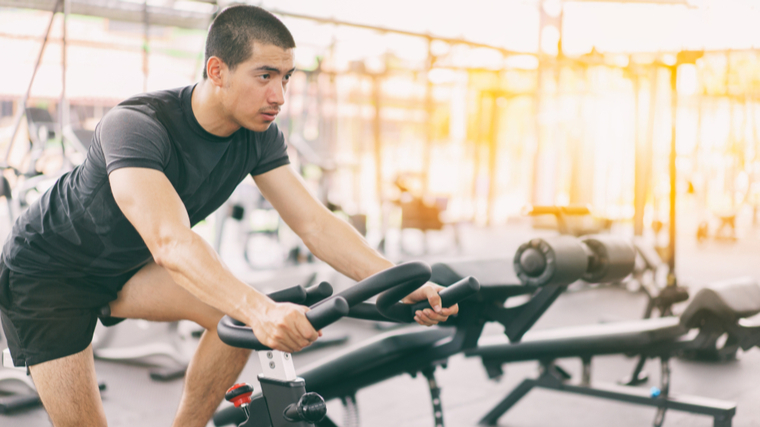
From specific training plans, diets, and various assortments of equipment, this guide will have you covered. Here is everything you should understand before you join a gym and start grinding toward a healthier life.
Beginner’s Guide to the Gym
How to start training, sample beginner program, the basics of nutrition, gym gear you need.
- Types of Gyms
- Common Gym Equipment
There’s a distinct difference between starting a workout routine without a concrete plan and starting a workout routine with specificity while being mindful of every detail . You can begin at random, but if you don’t know what it is you want to improve upon, you’re not going to make much progress over time.
Step 1 — Pick a Goal
If this is your first workout program, or you don’t have much experience, you’ll see the most benefits from an outlined plan. Rest assured — this is applicable for any gymgoer regardless of their knowledge. Knowing what you want to tackle is one of the first major steps.
Do you want to improve your conditioning ? Are you trying to build healthier muscle or see an uptick in your general strength across the board ? Maybe you’re looking to change your body composition and lose fat from top to bottom .
The best workout routine for you is sustainable and targets your specific goals .
Step 2 — Choose a Workout Split
Now that you have your goals in mind, center on a workout split , which is how you split up all the work you do over a period of time — usually a week.
There has to be a balance that leaves you with energy for a workout every day and gives you appropriate time to recover. This is where you determine how frequent your training sessions will be. Between three to five days is the most standard split option. If you choose to work out more often , then you may have to reduce your workout frequency. On the flip, if you work out once or twice a week, then those sessions may be more intense.
Step 3 — Select Your Exercises
With your goals and split established, it’s time to pick specific exercises. Every exercise you choose should be in service of whatever your goals are and suitable for your body type. There should be no wasted space.
A dedicated powerlifter, for example, will have plenty of deadlifts , back squats , and bench presses present throughout their split. If you want to become more agile or improve your conditioning, you may still hit up the squat rack , but the majority of your training would consist of exercises that specifically improve the qualities you’re after.
Exercises are typically categorized as either compound or isolation, and they have some distinct differences for you to consider.
Compound exercises involve movement at more than one joint at a time. They also often work multiple muscles simultaneously, making them both effective and efficient. These movements should occupy a large portion of your overall training.
Some lower body compound exercises you can consider including are back squats, front squats , leg presses , regular deadlifts , and trap bar deadlifts . Some upper body compound exercises you can consider including are the bench press, pull-ups , and push presses .
Your isolation, or accessory movements , serve as complements to your compound exercises. They tend to focus on one body part and are good for rounding out your body. Some people use accessory movements to focus on a neglected body area. Others treat accessories as every bit as integral as any compound workout .
How you want to view the place accessory movements have in your routine depends on your respective goals and the variety of exercises you include.
Some potential lower-body isolation movements you can consider including are lunges, and their variations , leg extensions and leg curls , calf raises . Some upper-body isolation movements you can consider including are any type of biceps curl , face pulls , and triceps pushdowns .
Step 4 — Organize Your Workouts
Suffice to say: Each of your workouts ought to begin with your compound movements because of the high energy they require. Then, depending on the day’s tasks, you’ll follow up with supportive, tailored accessory movements . As a general rule, begin with those lifts that recruit more muscles and require more attention before shifting to smaller, isolated movements.
Step 5 — Select Sets and Reps
The number of sets and reps you perform in a given exercise largely dictates how it affects your body . If you’re aiming at more strength , lower reps per set with higher weight will yield more gains. Conversely, dropping the weight down and performing more reps overall will help your muscular and cardiovascular endurance.
Compound exercises tend to match well with lower rep ranges, and the inverse is true for isolation movements. It’s easier to pump out 20 reps for a biceps curl than a back squat. (Though, 20-rep back squats are a thing , and they suck, but they do pay off.)
- 1 to 3 Reps — Power
- 3 to 6 Reps — Strength
- 6 to 12 Reps — Hypertrophy
- 12+ Reps — Endurance
It’s worth pointing out that these are not strict divisions, and that your body’s response to certain reps is more of a spectrum. A set of 12 reps can help you grow more muscle , but also provides a degree of endurance training.
Step 6 — Consider Your Rest
As much as you have to rest post-workout , you also have to rest between your sets . Structured resting periods often separate good workout plans from great ones .
The heavier the lift with smaller numbers of reps, and you’ll probably want a breather before you push your body through another set. The lighter the lift with higher numbers of reps, and you’ll probably want to move at an accelerated pace, depending on what your body can handle. Aim for two or more minutes of rest for heavy, low-rep sets , and a minute or less for high-rep work.
How to Progress
Your gym workout program has goals, tailored workouts with balance, and a general skeleton of sets and reps. Now it needs progression . The most common means of workout progression are increasing your reps, weight, or both .
For example, during your first workout, you back squat 135 pounds for three sets of eight reps. When you next circle around to back squats, you do three sets of nine reps at the same weight and so forth. Eventually, after a couple of weeks, if your legs aren’t jelly, you might add five pounds and run through the same cycle. This process can apply to any exercise.
If your head is spinning, don’t fret. Below you’ll find a very basic, beginner-friendly three-day routine that incorporates the principles of balanced program design. As you gain more experience with exercising and programming, you can build off of this template or devise your own to attack your specific goals more directly.
This routine is suitable for someone who is new to resistance training and who wants to develop a combination of muscle strength and size .
- Back Squat: 3 x 5
- Bench Press: 3 x 5
- Lat Pulldown : 2 x 8
- Lunge: 2 x 12
- Plank : 2 x 30 seconds
- Barbell Row : 3 x 6
- Dip : 3 x 8
- Overhead Press : 3 x 8
- Back Extension : 2 x 12
- Deadlift: 2 x 5
- Front Squat: 3 x 6
- Dumbbell Pullover : 2 x 8
- Triceps Extension: 2 x 12
- Cable Crunch: 2 x 12
Note: One of the most common forms of exercise notation, shown above, is (sets) x (reps).
When it comes to your workout program, know your reasoning for being in the gym. If you can understand and elaborate well upon why you’ve chosen an exercise, timeline, or dedicated split, it’s fair game to implement.
Nutrition is the pillar that supports your workout program. You can exercise all you like, but if you’re not feeding your body the proper nutrients pre and post-workout, you’re figuratively leaving gains on the cutting board.
The greatest athletes in the world exercise feverishly and follow diligent nutrition plans , with nary a second thought because they understand how essential it is to give their bodies proper fuel . Making sound nutrition a priority will pay off in spades long-term.
Caloric Intake
Calories are the fuel that enables you to perform activities both in and out of the gym. How much you eat is predicated on your activity level — as a beginner, you’re probably not going to need as many calories as a competitive powerlifter who needs more energy for their high-intensity workouts .
Thankfully, if you have a grasp of your activity level, you can easily calculate what your daily caloric intake should be.
Calorie Calculator
Your daily calorie needs: calories per day.
Exercise: 15-30 minutes of elevated heart rate activity. Intense exercise: 45-120 minutes of elevated heart rate activity. Very intense exercise: 2+ hours of elevated heart rate activity.
Macronutrients
A significant part of understanding your nutrition is that it has two primary elements: Macros (or macronutrients) and micros (or micronutrients). Macronutrients refer to the nutrients your body needs in larger quantities.
Protein , carbohydrates , and fat are what constitute your macronutrients. You need a healthy balance to get your fitness to the heights you envision. Each macronutrient contains a number of calories (four for both protein and carbohydrate, and nine calories per gram of fat).
Macronutrient Calculator
Total calories: per day.
A hearty protein intake helps you recover from the metabolic stress of physical training. Carbohydrates are your body’s preferred fuel source and help fill your proverbial engine. Dietary fat controls many essential regulatory and hormonal processes in your body that contribute to your overall wellbeing.
Protein Sources
- Chicken breast
- Low-fat cottage cheese
- Canned tuna
Carbohydrate Sources
- Whole-wheat bread, pasta, or crackers
Fat Sources
- Salmon
- Coconut oil
Micronutrients
Micronutrients get to do the jobs left behind by the macronutrients.
That is, your micros are your vitamins and minerals, and they are every bit as integral to your health as macros, even if they’re less abundant. If you want to maintain your vision while having a robust immune system, among some functions, you must incorporate micronutrients somewhere into your nutrition.
Luckily, most whole foods contain plenty of healthy micronutrients. Eating unprocessed foods, fresh fruits and veggies, and free-range meat or poultry can help you cover your bases. To be extra sure, you can pick up a solid multivitamin .
Hydration
Water is absolutely crucial to bodily function, and most people don’t drink enough of it . From cell wall integrity to nutrient partitioning, proper hydration keeps your body functioning from head to toe (and everywhere in-between).
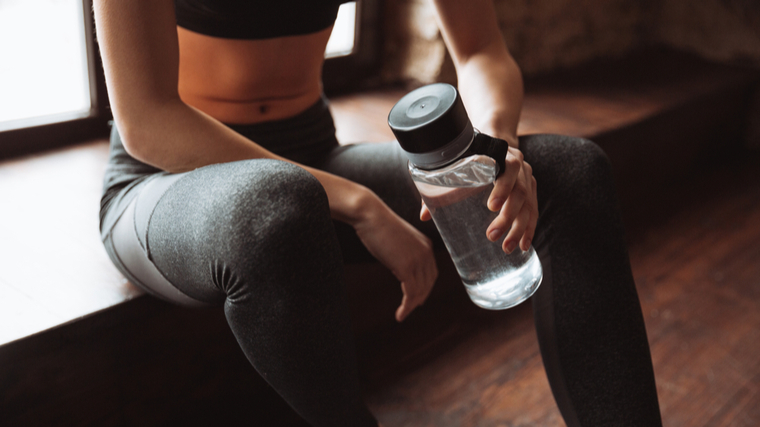
At the gym, you’re likely to need even more water than you might think, especially if you’re training in a way that breaks a real sweat . Try to aim for half a gallon or a gallon of water intake per day, whether you exercise or not.
The good news is you’ve digested a lot of information to this point and done your research. The “bad” news, which is also good news, is that it’s time to gear up for your workout regimen with proper equipment.
Bear in mind that no piece of gear is essential to making progress on your physique. There are some pieces of equipment that add convenience, comfort, or stability while you’re working out, however.
Transporting your personal belongings to the gym and back doesn’t have to be clumsy. A solid gym bag can keep you tidy and organized, while also ensuring you have everything you need no matter what kind of training you’re working on.
Lifting Belt
A weight belt helps provide support to your trunk and spine while you lift. As a beginner, it would be wise to work with just your body so you develop solid foundational stability. That said, a good lifting belt can help bring you peace of mind while also adding a bit of extra protection to vulnerable structures.
Cross Trainers
If you’re implementing a hybrid or cross-training program — which balances strength and endurance activities — you can’t neglect your feet. A session with cleans or box jumps and rope climbs will have a lot of intensity that puts your shoes under duress.
Cross-training shoes have become a popular choice in this department as they’re durable, reliable, and suitable for basically every type of training you can do in a gym.
Fitness Tracker
If you’re into meticulous bookkeeping, a fitness tracker is your friend . Not only can a tracker measure your steps, heart rate, or sleep quality , it’ll give you a picture of how active you are during your training, and whether you need to consider any changes . Some “smarter” trackers might link to your phone, letting them send texts, get calls, and even stream music.
Different Types of Gyms
Believe it or not, there are many different types of gyms out there. Some serve the general public, while others address specialty training or niche sports. If you’re searching for a consistent space to work out in, you need to know what kind of gym is appropriate for you.
Commercial Gym
Commercial gyms are Jacks-of-all-trades. Inside a commercial gym, there’s usually a major cardio area with treadmills , ellipticals , and stationary bikes . The other main portion is a strength area with free weights, weight machines , and other instruments. If the gym is massive, sometimes there are additional amenities like a spin studio or basketball court.
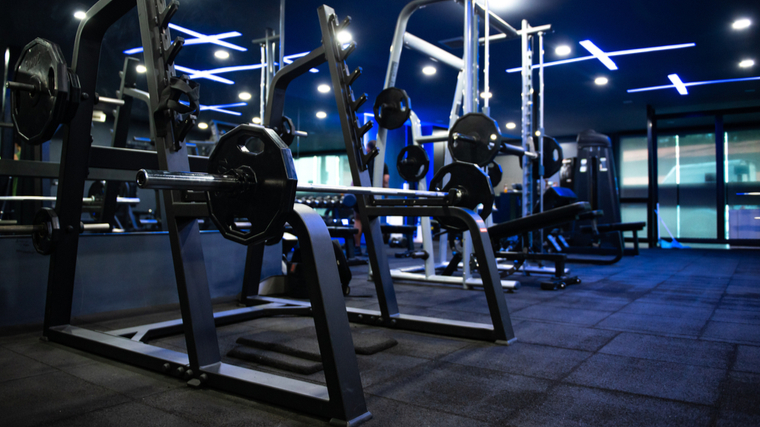
In terms of membership and accessibility, they’re friendlier to your bank account in comparison to specialized spaces and can be found just about anywhere. If you’re testing the waters with exercise, a commercial gym is a fantastic first choice.
CrossFit Box
A run-of-the-mill CrossFit gym centers around the namesake — where you mix strength and conditioning and perform group-based functional fitness classes, with no shortage of applicable equipment like dumbbells , kettlebells , rowing machines , and jump ropes .
A typical CrossFit gym has an open floor. In a group class, members work together through various trials or at their own stations, but the central pillar of a good CrossFit workout is community effort. A certified trainer leads everyone through a session to keep you on track.
Strength Sports Gym
If you’re out to acquire strength , power , and bulk en masse, a strength sport gym is a place to be.
Strength sports gyms focus on athletic development for powerlifting , strongman , or Olympic lifting . These facilities are chock-full of athletes both aspiring and competitive who want to test themselves on the platform or the competition field.
You can find all manner of heavy-duty equipment in a strength gym. Various types of barbells , extra-heavy dumbbells, massive Atlas stones for lifting and tires for flipping. While not as common as commercial gyms or CrossFit boxes — and often more expensive — a good strength gym is second-to-none for getting strong.
Common Gym Equipment
Entering a gym for the first time can be a jarring, but unexpectedly pleasant, experience if you’re committed to bettering yourself. However, you might take one look around and realize that you have no idea what the various contraptions and devices are, or what they do.
From dumbbells and barbells to benches, cable machines, and more, we’ve got your back. Below is a shortlist of the most common equipment you’ll find in a gym.
A tried and true staple of any modern gym, no gym or workout program is complete without these bad boys. A dumbbell has even weight distributed on each end and is most often used in pairs for a seemingly endless list of exercises for your arms, legs , back , core , you name it.
Dumbbells are often utilized in pairs and allow you to move your arms independently during an exercise, making them fantastic for addressing imbalances or performing unique movements.
Kettlebells
In contrast to a dumbbell’s even weight distribution and one-hand-per-weight design, a kettlebell’s weight is entirely distributed below its handle. One kettlebell easily accommodates the use of both hands, but can also be used unilaterally.
The design of the kettlebell makes it intuitive to move and perform with. They’re great for beginners , who can see noticeable cardio boosts and increases in their work capacity .
There’s no need to overcomplicate this description — A barbell is a long metal rod (of varying weight, but often 45 pounds) that holds weight on both ends. There are different kinds of barbells, and they are of frequent use for exercises like squatting and benching .
Barbells allow you to work with the most resistance possible, generally leading to better strength gains if you program properly.
Weight Plates
No barbell goes anywhere without a weight plate tagging along. Standard weight plates are loaded onto the ends of a barbell and come in increments of 2.5, 5, 10, 25, 35, and 45 pounds. They can also be rubber-coated, called bumper plates , such that you can drop your barbell if needed to avoid damaging the gym floor.
You’re not going to be sitting at this kind of bench, throwing seeds to attract birds. A gym bench is a piece of equipment where you can either lay down (to bench or dumbbell chest press, for example) or sit down (to seated shoulder press , for one).
Any gym-goer understands that a squat rack is one of a gym’s key elements. It’s where you’ll perform most barbell leg movements, as it allows you to get the bar onto your back safely instead of lifting it from the floor.
The squat rack is also a suitable location for exercises like the overhead press , rack pull , or barbell row. It’s generally considered good manners in the gym to only use the squat rack for exercises you can’t conveniently perform elsewhere.
Cable Machines
Whereas free weights are more or less at the mercy of the laws of physics (and the movement your body is capable of), cable machines offer wide-ranging opportunities for strength exercise. Because of a flexible path and consistent tension, cable machines allow you to work on desired smaller parts of your body with less restraint.
Resistance Bands
What if you want to train strength but aren’t in the mood to use free weights or machines? Resistance bands can save the day. These are elastic bands that can be pulled apart or wrapped around a pole, piece of equipment, or a partner, and contract and build smooth tension that can be kinder to your joints. They have ample uses for strength and endurance exercises if you’ve got some creativity .
A firm grip is a vital segment of any lift. Because it absorbs your sweat, you can spread chalk over your palms and fingers to improve your grip . Chalk makes it easier to hold on during heavily-loaded exercises like deadlifts, or when you have to grip something for an extended period of time — like in a farmer’s carry .
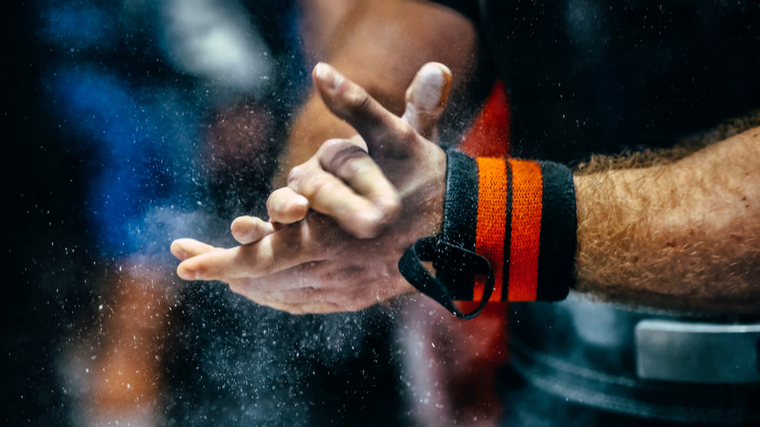
Note — due to the nature of communal equipment, and because of the mess it can create, not every gym might allow the use of chalk.
Cardio Machines
You know what you’re going to get with a standard treadmill , elliptical, or exercise bike . Aside from settings that you should safely familiarize yourself with before attempting, they have no surprises. Most gyms have an expansive selection of cardio equipment for you to experiment with during or after your workout.
Gym Culture
The gym can be an intimidating place for a newcomer. While you’re learning the ropes, it is completely fine to stumble along the way and make a few gaffes. The biggest thing to remember about gym culture is that everyone was once a beginner themselves.
So if you find yourself wondering what some of the common gym jargon means or don’t know all the rules of proper weight room etiquette , don’t worry. Being polite, courteous, focusing on your own training, and cleaning up after yourself will have you on the right track from day one.
The Big Picture
The health benefits of exercise are beyond numerous, but physical training is its own reward. If you’re even considering starting up with a workout plan, you’re already setting yourself up for success, health, and happiness long-term.
Getting yourself in the door is half the battle, and what comes after depends on how prepared you are. Luckily, with this guide in your back pocket, you have everything you need to take charge of your physique and crush any goal you set.
Featured Image: Mr. Somkiat Boonsing / Shutterstock
About Robert Zeglinski
Robert is a seasoned and adept editor and writer with a keen, passionate penchant for the writing craft. He's been a leader in newsrooms such as SB Nation, USA TODAY, and WBBM Newsradio, with various other content and art production teams, and first made a name for himself in his hometown of Chicago. When not knee-deep in research or lost in a stream of consciousness for a thorough piece, you can find Robert inhaling yet another novel, journaling his heart out, or playing with his Shiba Inu, Maximus (Max, for short).
View All Articles
BarBend is an independent website. The views expressed on this site may come from individual contributors and do not necessarily reflect the view of BarBend or any other organization. BarBend is the Official Media Partner of USA Weightlifting.
- Spiritual Health
- Drugs & Medications
- Healthy Cooking
- Fitfluencer

Say Goodbye to Cankles with These 5 Powerful Calf Exercises!
Science-backed strategies for butt fat loss: 10 exercises & more, landmine press guide: strengthen shoulders and core, arnold schwarzenegger’s back workout: a bodybuilding legacy, how to place kickboxing stance properly: mastering proper footwork, a beginner’s guide to kickboxing 101: a dynamic fitness regimen, training like titans: unveiling the secrets of mma fighters, victor richards: the original mass monster, things we must know :the science behind the power of mindfulness, unlocking success: the power of consistence.
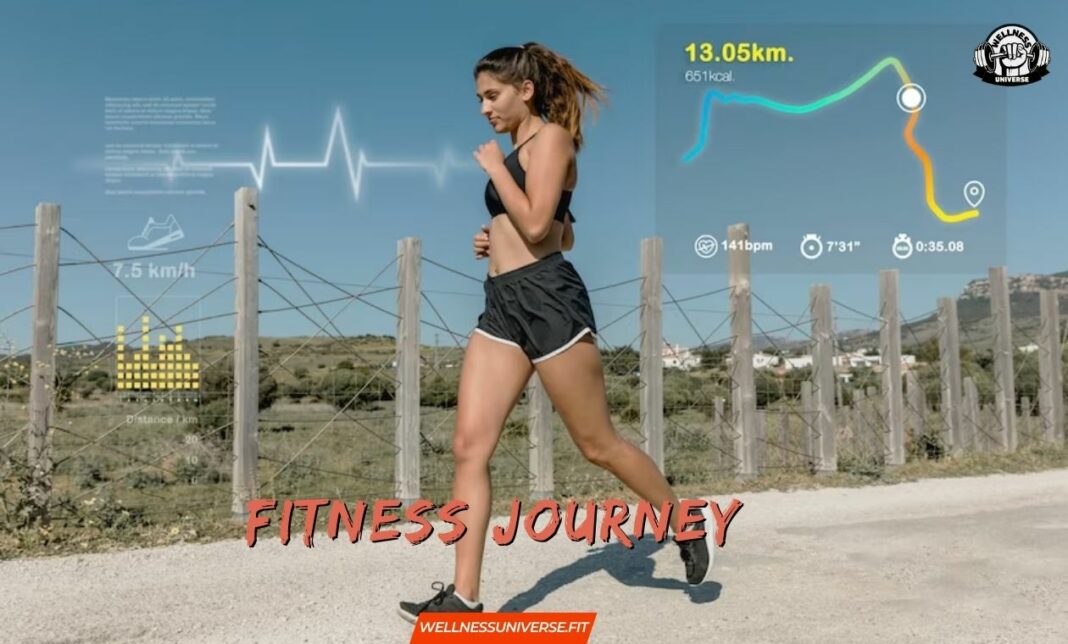
The Ultimate Roadmap to an Empowering Fitness Journey
Embarking on a fitness journey refers to the intentional and structured pursuit of improving one’s physical fitness, overall health, and well-being. It involves setting goals, adopting healthy lifestyle habits, and engaging in regular exercise and physical activity to achieve desired outcomes. A fitness journey is a personal and transformative experience that goes beyond short-term goals and focuses on long-term sustainable changes.
A fitness journey is unique to each individual, as it is tailored to their specific needs, preferences, and starting point. It can involve a wide range of activities such as cardio exercises, strength training, flexibility exercises, and mindful practices like yoga or meditation. The journey may also include modifications to one’s diet, sleep patterns, stress management techniques, and overall lifestyle choices.
Embarking on a fitness journey holds immense significance for individuals seeking to improve their health and overall quality of life. Here are some key reasons why a fitness journey is important:
- Physical health improvement: Engaging in regular exercise and physical activity has numerous benefits for physical health. It helps strengthen the cardiovascular system, improves muscle tone and strength, enhances flexibility, boosts metabolism, and promotes weight management. Regular physical activity also reduces the risk of chronic conditions such as heart disease, diabetes, and certain types of cancer.
- Mental and emotional well-being: Exercise has a profound impact on mental and emotional health. It releases endorphins, commonly known as “feel-good” hormones, which promote a positive mood, and reduce stress, anxiety, and symptoms of depression. Regular exercise also improves cognitive function, enhances focus, and increases self-confidence and self-esteem.
- Energy and vitality: A fitness journey can significantly increase energy levels and overall vitality. Regular physical activity improves circulation, delivering more oxygen and nutrients to the body’s tissues and organs. This leads to increased energy, improved alertness, and a greater sense of vitality throughout the day.
- Longevity and quality of life: Adopting a fitness journey can positively influence longevity and overall quality of life. Regular exercise has been shown to increase life expectancy and reduce the risk of premature death. It enhances functional abilities, promotes independence, and enables individuals to enjoy an active and fulfilling life well into older age.
- Personal growth and self-discovery: A fitness journey is not just about physical transformation but also about personal growth and self-discovery. It provides an opportunity to challenge oneself, push beyond comfort zones, and discover new strengths and capabilities. It cultivates discipline, perseverance, and resilience, fostering a sense of accomplishment and personal empowerment.
By embarking on a fitness journey, individuals can experience holistic improvements in their physical, mental, and emotional well-being. It offers an empowering path toward self-improvement, personal growth, and a healthier, more fulfilling life.
Starting Your Fitness Journey
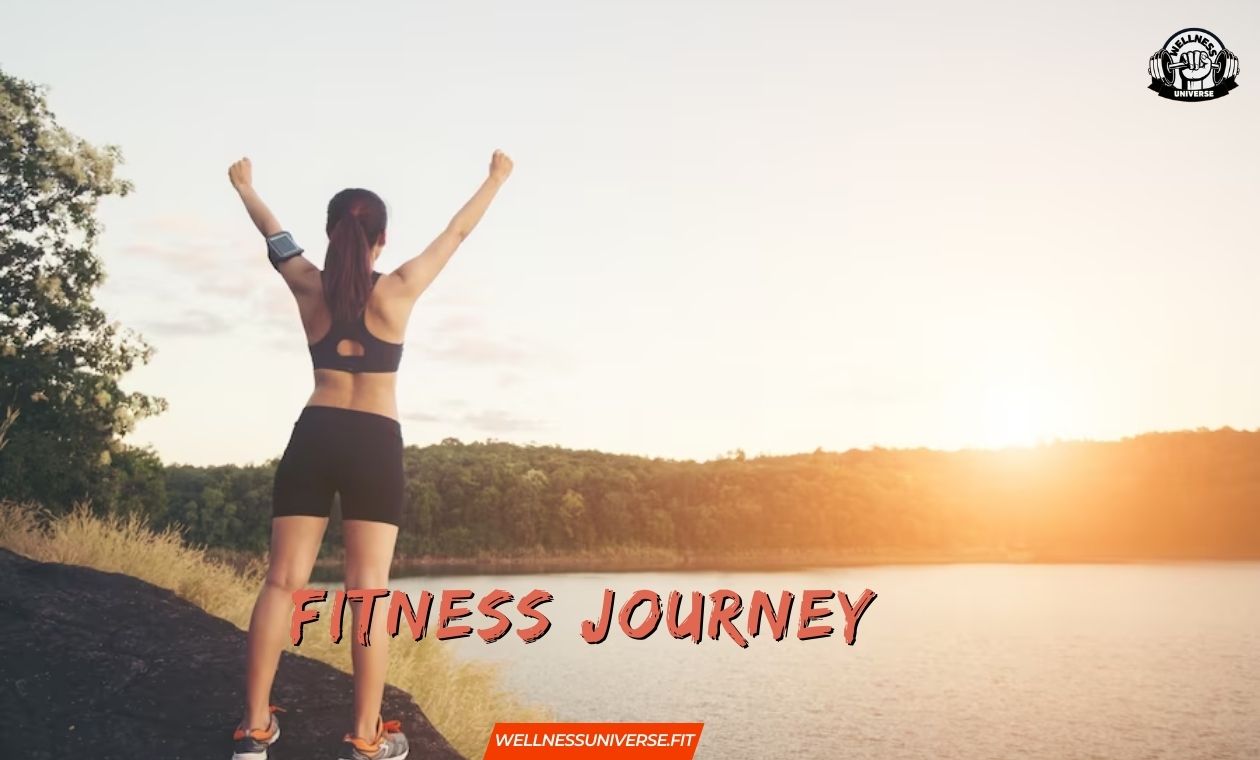
One of the first steps in starting a fitness journey is setting clear and realistic goals. Goals provide direction, motivation, and a sense of purpose throughout the journey. When setting fitness goals, it’s important to make them specific, measurable, attainable, relevant, and time-bound (SMART). This means defining the desired outcome, determining measurable indicators of progress, ensuring the goals are within reach, aligning them with personal values and aspirations, and setting a timeframe for achievement.
Examples of fitness goals could include losing a certain amount of weight, increasing strength and muscle tone, improving cardiovascular endurance, participating in a specific event or sport, or simply adopting a more active and healthy lifestyle. Setting goals that are meaningful to you will keep you focused and motivated along your fitness journey.
Before starting any fitness program, it’s essential to assess your current fitness level. This assessment helps you understand your strengths, weaknesses, and areas that need improvement. It also provides a baseline against which you can track your progress and measure the effectiveness of your fitness journey.
There are various ways to assess your fitness level. You can start by evaluating your cardiovascular fitness through exercises like walking, jogging, or cycling to determine your endurance and aerobic capacity. Strength tests, such as push-ups, squats, or lifting weights, can assess your muscular strength. Additionally, flexibility tests like reaching for your toes or performing stretches can evaluate your range of motion.
Alternatively, you may consider seeking professional help from a certified fitness trainer or healthcare professional who can conduct a comprehensive fitness assessment. They can provide a more accurate evaluation of your fitness level, identify any potential limitations or health concerns, and tailor a fitness plan that suits your specific needs and goals.
Before embarking on a fitness journey, it is advisable to consult with a healthcare professional, especially if you have any underlying health conditions or concerns. A healthcare professional, such as a doctor or a registered dietitian, can provide valuable guidance and support to ensure your fitness journey is safe and effective.
During the consultation, you can discuss your goals, medical history, and any concerns you may have. The healthcare professional can assess your overall health, provide recommendations on exercise intensity and duration, discuss dietary considerations, and offer insights into managing any health conditions or medications that may impact your fitness journey.
This consultation is particularly important if you have a history of chronic conditions, are pregnant or postpartum, are over the age of 40, or have been inactive for an extended period. The healthcare professional can help create a personalized fitness plan that takes into account your individual needs, abilities, and limitations, ensuring a safe and successful start to your fitness journey.
By setting clear goals, assessing your current fitness level, and consulting with a healthcare professional, you establish a solid foundation for your fitness journey. This proactive approach enables you to create a personalized plan that aligns with your aspirations, minimizes the risk of injury, and sets you up for long-term success.
Benefits of a Fitness Journey
Embarking on a fitness journey brings numerous benefits to your physical health. Regular exercise and physical activity have been shown to reduce the risk of chronic diseases and improve overall health. Here are some of the key physical health benefits of a fitness journey:
- Weight management: Engaging in regular physical activity helps in weight management by burning calories and building lean muscle mass. It can assist in achieving and maintaining healthy body weight, reducing the risk of obesity-related conditions such as heart disease, diabetes, and certain cancers.
- Cardiovascular health: Regular exercise strengthens the heart muscle, improves blood circulation, and lowers blood pressure. It reduces the risk of developing cardiovascular diseases, including heart attacks, strokes, and coronary artery disease.
- Stronger bones and muscles: Weight-bearing exercises, such as resistance training and weightlifting, stimulate bone growth and increase bone density, reducing the risk of osteoporosis. Additionally, strength training exercises help build and maintain muscle mass, improving overall strength and stability.
- Improved immune system: Regular physical activity has been shown to enhance the immune system’s function, reducing the risk of certain illnesses and infections.
- Better sleep: Engaging in physical activity can improve the quality of sleep, helping you fall asleep faster and enjoy deeper, more restorative sleep. It also helps regulate your sleep-wake cycle, promoting a consistent and refreshing sleep pattern.
In addition to the physical benefits, a fitness journey has a positive impact on mental and emotional well-being. Regular exercise has been linked to improved mood, reduced symptoms of anxiety and depression, and enhanced overall mental well-being. Here’s how a fitness journey can boost your mental health:
- Stress relief: Physical activity stimulates the release of endorphins, the body’s natural “feel-good” chemicals, which help reduce stress and improve mood. Exercise provides a healthy outlet for managing stress and promoting relaxation.
- Enhanced cognitive function: Regular exercise has been shown to improve cognitive function, including memory, attention, and problem-solving skills. It stimulates the growth of new brain cells and enhances the brain’s ability to form connections.
- Increased self-esteem: Achieving fitness goals, improving physical fitness, and taking care of your health can boost self-confidence and self-esteem. The sense of accomplishment from overcoming challenges and making progress in your fitness journey contributes to a positive self-image.
- Mood regulation: Exercise has a positive impact on mood regulation, helping to alleviate symptoms of anxiety and depression. It promotes the release of neurotransmitters like serotonin and dopamine, which are associated with improved mood and a sense of well-being.
Regular physical activity improves energy levels and enhances stamina. As you engage in a fitness journey, you’ll experience increased endurance, allowing you to perform daily activities with less fatigue. Regular exercise helps your cardiovascular system work more efficiently, delivering oxygen and nutrients to your muscles, which boosts overall energy levels.
A fitness journey can significantly improve self-confidence and body image. As you progress in your fitness goals, achieving milestones and overcoming obstacles, you’ll develop a sense of pride and self-assurance. Your physical transformations and increased fitness levels contribute to a positive self-perception and improved self-confidence in various areas of life.
In summary, a fitness journey offers a multitude of benefits for both physical and mental well-being. From weight management and cardiovascular health to improved mood and self-confidence, embracing a fitness journey positively impacts various aspects of your life. By committing to regular physical activity and making fitness a priority, you can reap the rewards of a healthier, happier, and more confident you.
Duration of a Fitness Journey
When embarking on a fitness journey, it’s essential to recognize that it is not a temporary endeavor but a lifelong commitment to your health and well-being. Fitness is a continuous journey that involves adopting healthy habits, maintaining consistency, and adapting to various stages of life. While specific goals may have time frames attached to them, the overall fitness journey extends beyond reaching those goals. It’s about cultivating a sustainable and healthy lifestyle that you can maintain in the long run.
The duration of a fitness journey varies for each individual and depends on several factors, including starting points, goals, commitment, and lifestyle. It’s crucial to set realistic expectations for progress and avoid comparing your journey to others. Progress is not always linear, and there may be periods of plateaus or setbacks along the way. It’s important to focus on gradual improvements and celebrate small victories, as they contribute to long-term success.
Instead of fixating on a specific timeline, shift your focus to building healthy habits and making consistent progress. Embrace the concept of sustainable change rather than seeking quick fixes or rapid transformations. Remember that the most significant transformations occur over time and require patience, dedication, and perseverance.
A fitness journey is not a destination but an ongoing process of continuous improvement. As you progress, your goals may evolve, and new challenges and opportunities may arise. Embrace the mindset of constantly striving to be better and finding new ways to challenge yourself physically and mentally.
Set new goals or milestones periodically to keep yourself motivated and engaged in your fitness journey. This could involve increasing the intensity or duration of your workouts, trying new forms of exercise, participating in fitness events or competitions, or exploring different fitness disciplines.
Furthermore, focus on holistic growth beyond physical fitness. Consider incorporating other elements into your fitness journey, such as improving flexibility, practicing mindfulness and stress management techniques, or enhancing your nutrition. The key is to maintain a growth mindset and embrace opportunities for self-improvement in all aspects of your well-being.
In summary, the duration of a fitness journey is not limited to a specific timeframe but is an ongoing commitment to a healthy and active lifestyle. Understand that progress may take time, and it’s important to set realistic expectations and avoid comparing yourself to others. Embrace the concept of continuous improvement, continually challenging yourself, and exploring new growth opportunities. Remember, a fitness journey is a personal and lifelong endeavor that extends far beyond reaching initial goals, and the key to success lies in maintaining consistency and a positive mindset throughout the journey.
Creating a Fitness Journey Plan
One of the keys to a successful fitness journey is finding activities and exercises that you genuinely enjoy. When you engage in activities you like, you’re more likely to stay motivated and committed to your fitness plan. Take some time to explore different types of physical activities, such as running, swimming, dancing, hiking, cycling, or playing a sport. Experiment with various exercises and discover what brings you joy and fulfillment.
Consider your preferences, interests, and lifestyle when choosing activities. If you enjoy being outdoors, you might opt for activities like hiking or cycling. If you prefer a social environment, group fitness classes or team sports could be a great fit. The goal is to find activities that keep you engaged, excited, and eager to participate.
A well-rounded fitness journey plan includes a combination of cardio, strength training, and flexibility exercises. Each component plays a vital role in improving overall fitness, health, and functional ability.
Cardiovascular exercises, such as jogging, swimming, or cycling, elevate your heart rate and help improve cardiovascular health, endurance, and calorie burn. Aim for at least 150 minutes of moderate-intensity aerobic activity or 75 minutes of vigorous-intensity aerobic activity each week.
Strength training exercises, such as weightlifting or bodyweight exercises, help build muscle strength, improve bone density, and enhance overall body composition. Include strength training exercises at least two days a week, targeting all major muscle groups.
Flexibility exercises, such as yoga or stretching routines, improve joint mobility, muscle flexibility, and posture. Incorporate stretching exercises into your fitness plan to enhance your range of motion and reduce the risk of injuries.
Remember to start gradually and progress gradually. If you’re new to exercise or returning after a break, begin with low-intensity activities and gradually increase the duration and intensity as your fitness level improves.
To stay organized and motivated, it’s essential to design a fitness journey plan that includes a schedule and milestones. Set aside specific days and times for your workouts, treating them as non-negotiable appointments with yourself. Consistency is key, so aim for regular exercise sessions throughout the week.
Consider your personal schedule and commitments when designing your fitness plan. Find a balance that works for you, whether it’s early morning workouts, lunchtime sessions, or evening exercises. Choose a time when you’re most likely to follow through with your fitness routine and when you feel energized and focused.
Setting milestones can provide a sense of direction and accomplishment throughout your fitness journey. Break down your goals into smaller, manageable milestones that you can work towards. These could include increasing the duration or intensity of your workouts, reaching a specific weight or body composition target, or achieving a certain fitness milestone, like running a 5K race.
Track your progress regularly, celebrating each milestone you achieve. This can help you stay motivated and provide tangible evidence of your growth and improvement. Consider using a fitness tracker or journal to record your workouts, measurements, and milestones.
In conclusion, creating a fitness journey plan involves identifying enjoyable activities, incorporating a variety of exercises, and designing a schedule with milestones. Choose activities that you genuinely enjoy and that align with your preferences and lifestyle. Incorporate cardio, strength training, and flexibility exercises to improve overall fitness and health. Design a schedule that suits your routine and set realistic milestones to work towards. Remember, the key is to find a balance that is sustainable and enjoyable, making your fitness journey a positive and fulfilling experience.
Staying Motivated During Your Fitness Journey
One of the most important factors in staying motivated during your fitness journey is finding your inner motivation and purpose. This involves identifying the reasons why you want to embark on this journey and understanding the personal benefits it will bring to your life. Ask yourself what drives you and what you hope to achieve through your fitness journey.
Some common motivations for embarking on a fitness journey include improving overall health, increasing energy levels, boosting self-confidence, managing stress, or achieving specific fitness goals. Reflect on your own aspirations and values to determine what truly inspires you. By connecting with your inner motivation and purpose, you’ll have a strong foundation to stay committed even when challenges arise.
Setting rewards and incentives along the way can provide an extra boost of motivation during your fitness journey. Rewards serve as positive reinforcement for your efforts and help you stay focused on your goals. Consider setting both short-term and long-term rewards to celebrate milestones and accomplishments.
Short-term rewards can be simple and immediate, such as treating yourself to a massage, buying new workout gear, or enjoying a favorite healthy meal. These rewards act as reminders of the progress you’ve made and encourage you to continue moving forward.
Long-term rewards can be more significant and aligned with your ultimate fitness goals. For example, if your goal is to run a marathon, treat yourself to a weekend getaway after completing the race. These rewards serve as a culmination of your hard work and dedication.
Remember that rewards don’t always have to be material. Consider rewarding yourself with non-food-related treats, like a day off to relax, a movie night with friends, or a spa day. The key is to choose rewards that are meaningful to you and that reinforce the positive behaviors you’re cultivating throughout your fitness journey.
Building a support system can greatly contribute to your motivation and accountability during your fitness journey. Surrounding yourself with positive and like-minded individuals who share similar goals can provide the encouragement and support you need to stay on track.
Reach out to friends, family members, or colleagues who have an interest in fitness or who are also on their own fitness journey. Share your goals with them and ask if they would like to join you or provide support along the way. Having a workout buddy or a group of people who understand and share your challenges and successes can be incredibly motivating.
Additionally, consider joining a fitness community or finding an online support group. These communities offer a sense of belonging and can provide valuable insights, tips, and encouragement. Engaging with others who are also striving for better health and fitness can create a sense of camaraderie and inspire you to keep pushing forward.
Don’t hesitate to lean on your support system when you face obstacles or moments of doubt. They can offer guidance, celebrate your victories, and remind you of your progress. Likewise, be a source of support for others, as helping others on their fitness journey can reinforce your own commitment and sense of purpose.
In conclusion, staying motivated during your fitness journey requires finding your inner motivation and purpose, setting rewards and incentives, and seeking support from friends, family, or a fitness community. Connect with the reasons why you want to embark on this journey and use them as a source of inspiration. Set rewards and incentives to celebrate your progress and keep you motivated along the way. Surround yourself with a supportive community that understands and shares your goals. By implementing these strategies, you’ll maintain the motivation needed to stay committed and achieve long-term success in your fitness journey.
Diet and Nutrition during Your Fitness Journey
When it comes to your fitness journey, diet and nutrition play a crucial role in supporting your overall health, optimizing your physical performance, and achieving your fitness goals. A balanced and nutritious diet provides the necessary fuel, nutrients, and building blocks for your body to function optimally.
A balanced diet consists of a variety of nutrient-dense foods from different food groups, including fruits, vegetables, whole grains, lean proteins, and healthy fats. These foods provide essential vitamins, minerals, antioxidants, and fiber that promote overall well-being and support your fitness endeavors.
To maintain a balanced diet, aim to include a wide range of colorful fruits and vegetables in your meals, as they offer an array of vitamins, minerals, and antioxidants. Incorporate whole grains like brown rice, quinoa, and whole wheat bread to provide sustained energy and fiber. Choose lean proteins such as chicken, fish, legumes, and tofu to support muscle repair and growth. Additionally, incorporate healthy fats from sources like avocados, nuts, seeds, and olive oil for their beneficial effects on heart health and nutrient absorption.
Different individuals may have different dietary preferences and requirements. It’s important to explore and find a dietary approach that aligns with your goals, preferences, and lifestyle. Some popular dietary approaches that people incorporate into their fitness journey include:
- Mediterranean Diet: This diet emphasizes whole foods, such as fruits, vegetables, whole grains, legumes, fish, and healthy fats like olive oil. It’s known for its heart-healthy benefits and is rich in antioxidants and anti-inflammatory compounds.
- Plant-Based or Vegan Diet: This diet focuses on consuming plant-based foods and excludes animal products. It emphasizes fruits, vegetables, whole grains, legumes, nuts, and seeds. It can be beneficial for those seeking a diet that is higher in fiber, lower in saturated fat, and environmentally sustainable.
- Low-Carb or Ketogenic Diet: These diets restrict carbohydrate intake and prioritize fats and proteins. They aim to shift the body into a state of ketosis, where it primarily burns fat for energy. These approaches may be suitable for some individuals, but it’s important to consult with a healthcare professional before adopting such a diet, especially if you have any underlying health conditions.
- Intuitive Eating: This approach focuses on listening to your body’s hunger and fullness cues, eating mindfully, and cultivating a positive relationship with food. It encourages honoring your cravings while also prioritizing nutrient-dense foods.
Remember, there is no one-size-fits-all approach to nutrition. What works for one person may not work for another. It’s essential to experiment, listen to your body, and find a dietary approach that supports your fitness goals while nourishing your body and promoting overall well-being.
If you find yourself unsure about the dietary aspects of your fitness journey, it can be helpful to seek guidance from a registered dietitian (RD) or a nutritionist. These professionals are trained in nutrition science and can provide personalized advice based on your specific needs, goals, and health conditions.
An RD can assess your current dietary habits, help you identify areas for improvement, and provide practical strategies for incorporating nutritious foods into your daily routine. They can also address any concerns or questions you may have regarding supplements, portion sizes, meal timing, and navigating social situations that involve food.
Working with an RD can provide you with the knowledge, support, and accountability necessary to optimize your nutrition and achieve your fitness goals in a safe and sustainable manner. They can tailor their recommendations to your unique circumstances, ensuring that your dietary choices align with your fitness journey.
In conclusion, during your fitness journey, it’s important to prioritize a balanced and nutritious diet to support your overall health and fitness goals. Aim for a variety of nutrient-dense foods from different food groups and explore different dietary approaches to find what works best for you. If you need further guidance, consider consulting with a registered dietitian or nutritionist who can provide personalized advice and support. By nourishing your body with the right foods and seeking professional guidance when needed, you’ll optimize your nutrition and enhance the benefits of your fitness journey.
Embarking on a fitness journey is a transformative and empowering experience that can positively impact your life in numerous ways. Whether you’re just beginning your journey or have been on it for a while, remember that every step you take toward a healthier lifestyle matters. Take pride in the progress you make, no matter how small, and celebrate your achievements along the way.
If you haven’t started your fitness journey yet, now is the perfect time to take that first step. Embrace the opportunity to prioritize your health, well-being, and happiness. Remember, every fitness journey is unique, and there is no right or wrong path to follow. It’s about finding what works for you and creating sustainable habits that align with your goals and values.
Your fitness journey is not just about physical transformation; it’s also about improving your mental and emotional well-being. It’s an opportunity to discover your inner strength, challenge your limits, and unlock your full potential. Embrace the journey as an opportunity for self-discovery and growth.
Throughout your fitness journey, it’s essential to practice self-compassion and kindness. Be patient with yourself and recognize that progress takes time. There will be ups and downs, setbacks and obstacles, but remember that each setback is a chance to learn, grow, and come back even stronger.
Surround yourself with a supportive network of friends, family, or like-minded individuals who share your passion for a healthier lifestyle. Seek inspiration from success stories and individuals who have overcome challenges similar to yours. Their stories can serve as a reminder that you’re not alone and that your goals are achievable with dedication and perseverance.
Lastly, remember that a fitness journey is not just a temporary phase but a lifelong commitment to your well-being. Embrace the changes you make as lasting lifestyle choices rather than quick fixes. Continually reassess your goals, set new challenges, and adapt your routines as you progress. Embrace the joy of movement, nourish your body with wholesome foods, and prioritize self-care in all aspects of your life.
Your fitness journey is an ongoing adventure, full of growth , self-discovery, and opportunities for a healthier and happier life. Embrace it with enthusiasm, dedication, and an open mind. Believe in yourself, stay committed to your goals, and never forget the incredible potential that lies within you.
As you embark on or continue your fitness journey, remember that the power to transform your life is in your hands. You have the ability to create a healthier, stronger, and more vibrant version of yourself. Embrace the journey, enjoy the process, and savor the rewards of a fitter, happier, and more fulfilling life.
Thank you for joining us on this fitness journey! We hope you found our The Ultimate Roadmap to an Empowering Fitness Journey blog insightful and inspiring. Our aim is to provide you with valuable information, expert advice, and motivational content to support you in your wellness endeavors.
Related Post :-
- How To Do Wall Pushups
- Hand Size Demystified
- CrossFit Unleashed
- Barbell Lunges
- Forearm Fortitude
- Kettlebell Circuit
- Squat Mastery
Shoulder Exercises
FAQs about Fitness Journey
What is a fitness journey.
A fitness journey refers to the process of adopting a healthier and more active lifestyle with the goal of improving physical fitness, overall well-being, and achieving personal fitness goals.
How do I start my fitness journey?
To start your fitness journey, begin by setting clear and realistic goals, assessing your current fitness level, and designing a fitness plan that includes a variety of exercises and activities. Start with small steps and gradually increase intensity and duration as you progress.
What are the benefits of embarking on a fitness journey?
Embarking on a fitness journey offers numerous benefits, including improved cardiovascular health, increased strength and endurance, weight management, stress reduction, enhanced mood, and mental well-being, increased energy levels, and reduced risk of chronic diseases.
How long does a fitness journey usually take?
The duration of a fitness journey varies for each individual and depends on factors such as starting fitness level, goals, consistency, and dedication. It is important to view fitness as a lifelong journey rather than a short-term endeavor, as maintaining a healthy lifestyle is a continuous process.
What should I include in my fitness journey plan?
Your fitness journey plan should include a combination of cardiovascular exercises, strength training, flexibility exercises, and adequate rest and recovery. It should be tailored to your goals, preferences, and fitness level. It is also important to incorporate proper nutrition and hydration into your plan.
How do I stay motivated during my fitness journey?
To stay motivated, set specific and realistic goals, track your progress, celebrate achievements, find activities you enjoy, vary your workouts, seek support from friends or a fitness community, reward yourself for milestones, and remind yourself of the benefits and positive changes that come with a consistent fitness routine.
What are some common challenges people face during their fitness journey?
Some common challenges during a fitness journey include lack of motivation, time constraints, plateaus in progress, dealing with injuries or setbacks, balancing fitness with other responsibilities, and overcoming self-doubt or negative thoughts. It is important to stay resilient, adapt to challenges, and seek support when needed.
Can I embark on a fitness journey without a gym membership?
Absolutely! A fitness journey can be pursued without a gym membership. There are numerous options for home workouts, outdoor activities, bodyweight exercises, and fitness classes or programs available online. It's important to find activities that suit your preferences and fit your lifestyle.
What are some effective exercises for a fitness journey?
Effective exercises for a fitness journey include activities such as running, walking, cycling, swimming, strength training with weights or resistance bands, yoga, Pilates, HIIT (High-Intensity Interval Training), and functional training exercises that engage multiple muscle groups. Choose exercises that align with your goals and preferences.
How can I track my progress during my fitness journey?
You can track your progress by keeping a fitness journal, recording workout sessions, tracking measurements, monitoring changes in weight or body composition, using fitness apps or wearable devices, and assessing improvements in endurance, strength, flexibility, or performance. Regularly review your progress to stay motivated and make necessary adjustments to your fitness plan.

Meet Pradeep Singh, your go-to guide for all things fitness, health, and motivation. With over 7 years in the field, Pradeep brings a blend of expertise and real-world experience to his writing. From workout tips to healthy living insights, he simplifies complex topics, making fitness accessible for everyone. His authentic approach and genuine passion aim to inspire and support your wellness journey. Get ready to embark on a path to a healthier lifestyle with Pradeep as your trusted companion and motivator.
RELATED ARTICLES MORE FROM AUTHOR
Leave a reply cancel reply.
Save my name, email, and website in this browser for the next time I comment.

10 Proven Ways to Weight Loss Without Breaking a Sweat in 2024
The Pros and Cons of Metabolic Confusion: Fad Diet or Fat-Burning Genius?
12 Weeks Pregnant: Symptoms and Baby Development Guide
Popular posts, becoming the dark knight: the epic batman workout revealed, fierce and fit: empowering female through muscle growth, bmi breakthrough: transform your body, popular category.
- Workout 143
- Lifestyle 20
- Nutrition 8
- Spiritual Health 5
- Motivation 3
- Healthy Cooking 3
Gym Fitness • Gym Membership • iChuze Fitness
How to start going to the gym: a guide.
Starting your fitness journey is a transformative step towards a healthier and happier you. In this guide, we’ll share with you some of the essential aspects of starting your 30-minute gym routine (if you’re just starting), providing practical advice and motivation to help you navigate the exciting world of fitness. Whether you’re new to the […]
Published: 1/22/24
Starting your fitness journey is a transformative step towards a healthier and happier you. In this guide, we’ll share with you some of the essential aspects of starting your 30-minute gym routine (if you’re just starting), providing practical advice and motivation to help you navigate the exciting world of fitness. Whether you’re new to the gym or returning after a hiatus, we’ve got you covered. Embrace the empowering journey of self-improvement, discover the joy of breaking a sweat, and witness the positive changes unfolding in both your body and mindset. Your fitness evolution starts here!
Key Components of a Successful Gym Routine
Keeping a consistent gym routine involves grasping the fundamental components that play a pivotal role in enhancing your overall fitness. Whether you’re going solo or trying partner workouts, here’s a look at the key elements that should be part of your successful gym routine:
1. Strength Training
- Free Weights: Incorporate exercises with dumbbells, barbells, and kettlebells to engage multiple muscle groups and improve functional strength.
- Weight Machines: Utilize resistance machines to target specific muscle areas with controlled movements, making them ideal for beginners.
- Bodyweight Exercises: Integrate bodyweight workouts like push-ups, squats, and lunges for functional strength and flexibility.
2. Aerobic Exercise
- Running: Lace up your shoes and hit the treadmill or venture outdoors for a cardiovascular workout that boosts endurance and burns calories.
- Cycling: Whether on a stationary bike or cycling through scenic routes, this low-impact exercise is excellent for cardiovascular health.
- Elliptical Machines: Enjoy a low-impact alternative that mimics running without the stress on your joints, making it suitable for various fitness levels.
3. Flexibility Exercises
- Dynamic Stretching: Incorporate dynamic stretches into your warm-up routine to improve blood flow, flexibility, and joint mobility.
- Static Stretching: Post-workout, engage in static stretches, holding each stretch for 15-60 seconds, to enhance flexibility and reduce muscle tension.
- Yoga: Explore yoga sessions to not only improve flexibility but also promote relaxation and mental well-being through mindful movement and breath control.
Importance of Goal Setting
A successful gym journey involves more than just lifting weights and breaking a sweat—it’s about setting clear and achievable fitness goals. Here’s why goal setting is the cornerstone of your path to a healthier you:
- Guiding Compass: Your fitness goals act as a guiding compass, directing your workouts with purpose and intention. They provide a roadmap for your journey, ensuring every step contributes to your overall success.
- Fueling Motivation: Goals serve as powerful motivators, igniting the passion needed to push through challenges. Whether you’re aiming for weight loss, muscle gain, or improved mental health, having a target in mind keeps you driven and focused.
- Setting the Tone: Clear objectives set the tone for your entire fitness routine. They create a foundation for your workouts, helping you tailor your exercises, intensity, and duration to align with your specific aspirations. This is especially important in your morning exercise routine .
Incorporating goal setting into your gym routine transforms exercise from a mere activity to a purpose-driven journey. So, take a moment to define your objectives—whether they’re about sculpting your physique, enhancing endurance, or finding mental clarity—and let them be the driving force propelling you toward your fitness aspirations.
Different Types of Gyms
Selecting the right gym sets the stage for a successful fitness journey, and with the diverse options available, it’s essential to make an informed decision. Explore the various types of gyms to find the perfect fit for your unique preferences and fitness goals:
1. Specialized Studios
Specialized studios cater to those with specific workout preferences, offering a focused environment for targeted exercises. Consider these options:
- Yoga Studios: Immerse yourself in the tranquility of a yoga studio, perfect for enhancing flexibility, balance, and mindfulness.
- Spin Classes: Join a spin studio for high-energy cycling sessions, ideal for cardiovascular health and lower-body strength.
- Strength Training Studios: Explore spaces dedicated to strength training, equipped with free weights and machines for building muscle.
It’s worth noting that specialized studios can limit the type of fitness activities you can engage in and a more full service gym may be more appropriate for someone trying to find their fitness groove. For example, Chuze provides group fitness classes that cover these same types of workouts, and also has standard gym workout equipment along with extra amenities.
2. Full Service Gyms
Full service gyms provide a one-stop-shop for all your fitness needs, offering a comprehensive range of amenities, equipment, and classes. Factors to consider include:
- Amenities: Access facilities like saunas, swimming pools, and locker rooms for a complete post-workout experience.
- Equipment Variety: Enjoy a wide array of exercise equipment, ensuring you have everything you need to diversify your workouts.
- Class Diversity: Engage in various classes, from cardio workouts and strength training to yoga and dance, catering to diverse fitness preferences.
Full service gyms, such as Chuze, allow beginners to explore different fitness exercises and routines that work best for them instead of committing them to one type of workout class!
3. Community-Centric Gyms
Some gyms prioritize a sense of community, fostering a supportive environment for individuals of all fitness levels:
- Group Fitness Classes: Join classes that encourage camaraderie, creating a motivating atmosphere for achieving shared fitness goals.
- Personalized Training: Access to personal trainers who provide tailored guidance, ensuring your workouts align with your specific objectives.
- Social Spaces: Gyms with communal spaces create opportunities to connect with fellow fitness enthusiasts, fostering a sense of belonging.
4. Budget-Friendly Options
If budget considerations are paramount, explore affordable gym options without compromising on essential amenities:
- Basic Gym Chains: Many budget-friendly chains provide the necessary equipment and classes for a no-frills, cost-effective fitness experience.
- Local Community Centers: Check out community centers that offer gym facilities at affordable rates, contributing to both your physical and financial well-being.
5. Virtual Fitness Platforms
In the digital age, virtual fitness platforms (such as our iChuze digital fitness program) have gained popularity, allowing you to work out from the comfort of your home:
- Online Classes: Access a variety of classes and workouts through virtual platforms, providing flexibility in your fitness routine.
- Tech-Integrated Equipment: Explore gyms equipped with virtual training tools, combining technology with traditional fitness for an innovative experience.
Building a Beginner-Friendly Workout Routine
Your fitness journey as a beginner requires a well-crafted plan that balances simplicity and effectiveness. Here’s a guide to building a beginner-friendly workout routine, complete with sample workout plans:
- Cardiovascular Exercise: Kickstart your workout with 20-30 minutes of aerobic activity. Options include brisk walking, cycling, or using cardio machines like the treadmill.
- Strength Training: Build overall strength with a mix of bodyweight exercises, free weights, or weight machines. Include exercises like squats, lunges, and dumbbell workouts.
- Flexibility Work: Dedicate time to stretching exercises to enhance flexibility and prevent injuries. Focus on dynamic stretches before your workout and static stretches afterward.
Sample Beginner’s Workout Plan (3 Days/Week):
Follow this simple and effective workout plan designed for beginners:
Day 1: Cardio
- 20 minutes on the treadmill
- 15 minutes on the stationary bike
Day 2: Strength Training
- Bodyweight squats: 3 sets of 10 reps
- Dumbbell chest press: 3 sets of 12 reps
- Plank: 3 sets of 30 seconds to 1 minute hold
- Bicycle Crunches: 3 sets of 15 reps (each side)
Day 3: Flexibility
- Dynamic stretching routine
This beginner’s plan incorporates a balance of cardiovascular exercise, strength training, and flexibility work, ensuring a holistic approach to your fitness journey. Feel free to adjust the intensity and duration based on your comfort level and gradually increase as you gain confidence and strength. Remember, the key is consistency and enjoyment as you progress towards your fitness goals.
Overcoming Gym Intimidation and Anxiety
Feeling nervous about the gym is normal, and overcoming that initial hesitation is crucial for a positive fitness journey. Combat gym intimidation with these practical strategies:
- Choosing Off-Peak Hours: Experience a less crowded gym during off-peak times. This allows for a more comfortable and private workout environment, easing feelings of self-consciousness.
- Starting Slow: Begin with familiar exercises to build confidence and a sense of familiarity within the gym. Gradually explore new equipment at your own pace, focusing on exercises you feel comfortable with.
- Buddy System: Bring a friend along for mutual support. Having a workout buddy can alleviate anxiety, provide encouragement, and make the gym experience more enjoyable.
- Group Classes: Participate in group fitness classes where the group dynamic fosters a sense of community. Group classes often have an instructor guiding the session, offering additional support and motivation.
- Virtual Workouts: If the gym setting is still overwhelming, consider starting with virtual workouts at home. Many fitness apps and online platforms (such as our iChuze online fitness program + app ) offer beginner-friendly routines, allowing you to build confidence before transitioning to the gym.
- Professional Guidance: Consider joining a group fitness class (such as our Team Training or Lift Lab ), even if just for a few sessions. A certified coach can provide guidance, create a workout plan, and offer support in navigating the gym after the session.
Following Gym Etiquette
To maintain a positive gym environment and ensure a harmonious workout space for everyone, it’s crucial to adhere to basic etiquette guidelines:
- Clean Equipment: Wipe down machines after use to promote cleanliness and hygiene. This simple act demonstrates respect for fellow gym-goers by leaving the equipment in a sanitary condition for the next user.
- Mind Your Noise: Keep noise levels in check, including avoiding loud conversations or music without headphones. Additionally, be mindful when dropping weights, as excessive noise can disrupt the concentration of others.
- Respect Personal Space: Be aware of personal space, especially during crowded hours. Allow others enough room to perform their exercises comfortably, and avoid unnecessarily occupying shared spaces.
- Share Equipment: Be considerate by allowing others to work in between your sets, especially during peak hours. Share the equipment, and communicate with fellow gym-goers if there’s a need to alternate.
- Time Management: Respect the time limits on equipment during busy periods. Be mindful of others waiting and try to complete your workout efficiently.
- Return Equipment: After using free weights or other portable equipment, return them to their designated places. This ensures that others can easily find and use the equipment without disruption.
- Silence Your Phone: Keep your phone on silent mode or vibrate to minimize disturbances. If you need to take a call, step outside the workout area to avoid disrupting those around you.
- Proper Attire: Wear appropriate workout attire and footwear. This not only contributes to a professional and respectful atmosphere but also ensures your safety during exercises.
Your Fitness Journey Starts Here
Starting your gym journey is a rewarding venture that contributes to your physical and mental well-being. Chuze Fitness , with its commitment to providing an awesome yet affordable gym experience, is an excellent choice for beginners, seasoned gym goers, and group fitness classes alike. Remember, your fitness journey is unique, and the key is to enjoy the process. So, put on your workout clothes, pack your gym bag, and take the first step towards a healthier, happier you. Your fitness adventure awaits!
Explore our list of nearby locations scattered across California, Arizona, Colorado, Texas, Georgia, Florida, and New Mexico. Whether you’re in search of gyms in El Paso or gyms in Orange County , we’re here to assist you in reaching your fitness goals. Experience positive change for yourself.
- Nerd Fitness. 6 Gym Workouts for Beginners (How to Train in a Gym) . https://www.nerdfitness.com/blog/a-beginners-guide-to-the-gym-everything-you-need-to-know/ .
- RxFit. How to Start Going to the Gym: A Beginner’s Guide. https://rxfit.co/how-to-start-going-to-the-gym/ .
Related Posts
Cross training for runners: a guide, morning exercise routine, gym cardio workout.

The Beginner’s Guide To Starting A Fitness Journey
- July 25, 2017

- Getting rid of medications that are unnecessary with lifestyle changes.
- Being able to keep up with your kids/grandkids and enjoy life with them instead of watching from the sidelines.
- Being a good role model for those in your life who are looking to you for guidance.
- Managing or even better, eliminating chronic disease and illness born from poor lifestyle.
- Clothes fitting looser. Okay, so the scale hasn’t moved yet. But you’re clearly getting smaller which was the goal, right? So stop obsessing over an arbitrary numbers machine and actually pay attention to the changes in your body.
- Getting better sleep and feeling vibrant. It’s a by-product of regular exercise, so when this lovely side effect hits you, embrace it with wide open arms.
- Feeling HAPPIER from that endorphin glow each day. Starting or ending your day with an amazing workout and that lovely life elixir called sweat.
- Being more PRODUCTIVE because you have more energy to show up for your life in a really positive way.

- Afternoon home spa pampering yourself or go get a mani/pedi.
- Donate your now-too-big clothes to charity.
- Use stickers to note the date of your milestone achievements on your calendar.
- Plan a healthy day trip with friends such as hiking.
- Get a massage.
- Schedule a professional photoshoot .
- Plan and execute your dream vacation.
- Buy new workout gear.
- Make a new playlist.
- Go shopping … in your own closet!
- Snag a fresh bouquet of flowers at the farmers market.
- Find a new plant to add to your garden.
About Inspired Wellness We are a wellness movement aimed at cultivating greatness in all areas of life. We believe that everything is connected and that having the body of your dreams shouldn’t come at the price of your mental and emotional health. You CAN have it all; you just need some determination, grit and the desire to truly change your life!
Catch us locally in sunny Sacramento CA inspiring lives at our wellness center with fitness, nutrition and lifestyle programs, or online doing the same thing with our new online training site + community coming soon!
Want more content like this delivered straight to your inbox? Get a weekly dose of inspiration by subscribing here .
Let’s get social! Come connect with us in these places:
Free Wellness Group : facebook.com/groups/iwagaccgroup Facebook : facebook.com/theinspiredwellness Instagram : instagram.com/inspirewellness
Inspired Wellness
I had established a great work routine and got into the gym a minimum of 5 days a week. Then I hit a bit of a tragedy with the death of my mom and brother and just couldn’t get myself to go anymore. So really excited to get back into working out.
I’m going to remind myself that I love myself enough to do this for me, and that I’m not comparing myself to or competing with anyone. I’m celebrating my milestones by getting massages!
Exercise makes me a better mom and partner. It is therapy!
The one thing that initially drew me to Inspired Wellness and has kept me coming back for more (despite the killer workouts) is the AMAZING sense of community – there is no judgment only an incredible, supportive group of individuals who come together and lift each other up.
This isn’t my first challenge but this still resonates. Thanks!
I need to remind myself that I am worth it and everything is hard before it’s easy!
I believe community really is a huge part of our wellness all around! I hope to meet some new friends through this experience.
I think the #1 tip is the one that resonates the most with me! I’ve recently started the Inspired Wellness Get Fit Challenge and while it can be a challenge, I stay motivated by reminding myself why I am doing this. It’s important to me to understand what I’m putting in my body and when I have kids one day I want to make good nutritional decisions for them as well. Thinking of these reasons makes the Wellness journey a lot more simple and fun!
Leave A Comment Cancel reply
Save my name, email, and website in this browser for the next time I comment.
You might be interested in...

3 stress-free ways to say NO
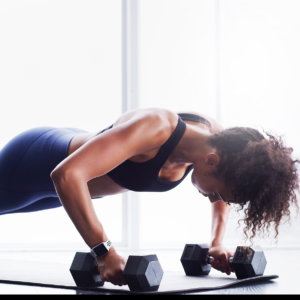
End 2023 with a giant exclamation point

Most powerful version of YOU
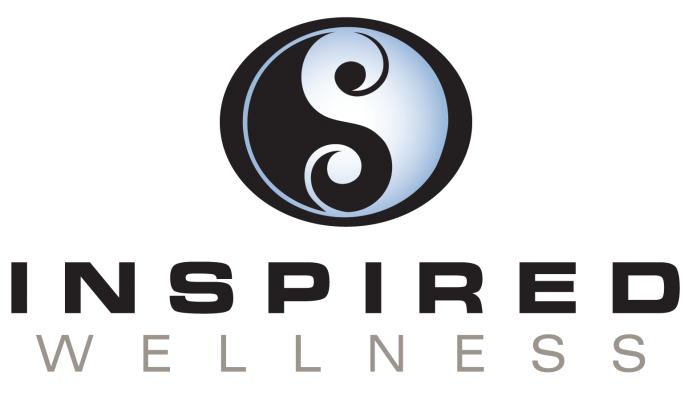
- (916) 235-3453
- [email protected]
- 2724 24th St STE 100, Sacramento, CA 95818, United States
Weekly Newsletter

How to Start Your Fitness Journey
We’ll start by admitting that starting anything new is hard. There’s a reason it’s so common for people to give up on their New Year’s resolutions by February—because building a new habit is an uphill battle from the start.
Exercising more is the most common New Year’s resolution , and it’s also the first one to go out the window.
If you’re reading this—whether it’s January or June—you probably don’t want that to be your story. And our goal is to set you up for success from the start.
This guide has plenty of tools, advice, and resources to help you begin a lifelong habit of exercising. New to fitness or new to actually understanding it, this is the knowledge you need to move forward.
How to Set Goals
Setting goals might sound like a simple thing, but it’s challenging to set realistic and motivating goals that keep you going. People tend to run into these common roadblocks when setting goals:
- You set goals that are completely out of reach . You’re not going to be able to go from zero to 10 pull-ups in your first month of exercising. That’s a fact. But many people set goals that are similarly unrealistic.
- You set goals you don’t really care about . All too often, we set goals for ourselves that are really being driven by someone else, whether that’s a family member, a coworker, or even the media. If your goal isn’t personally meaningful to you, you’ll have a hard time drumming up enough motivation to work on that goal.
- You set goals that are too vague to really be actionable . “Exercise more” is a really good example. What does that mean, exactly? How will you know if you’re making progress?
There are thousands of books about goal setting because this is universally challenging. With a good framework, though, you can learn to set goals that are both achievable and motivating. Let’s look at a few strategies to help you set meaningful goals.
Start With Why
There’s a great book by Simon Sinek called, Start with Why (you can also watch his TED Talk on the same topic if you’re short on time). It’s more geared toward entrepreneurs and business leaders, but his main idea is just as essential to setting goals with a new fitness program.
It’s all about taking a step back and defining why you’re doing this—beyond the vague “get in shape.”
What’s your real purpose in starting an exercise program?
For many people, it’s about getting overall healthier so they can be comfortable with their bodies or, thinking of longevity, being able to tackle a flight of stairs without thinking about it.
For others, it’s about reconnecting with an old athletic hobby that used to bring them a lot of joy. And for others still, it might be about getting past chronic pain they’ve lived with for years.
Choosing to start an exercise journey is hard, and you should be proud of yourself for even making that choice. When we make hard choices like that, there’s always a deeper reason for doing so, even if we don’t realize it right away.
If your goal is to lose 20 pounds, think through your personal “why” behind that goal. There’s no right or wrong answer, as we each have different things that are important to us. If your motivation is tangible and meaningful to you , that’s something you can keep coming back to, especially on those days when the last thing you want to do is exercise.
Many people skip this step when setting goals, but you’ll be glad you took the time to think through the deeper purpose driving you to put in this work.
Find What Motivates You
Knowing your “why” is a big part of staying motivated and setting goals accordingly. Another important piece is tapping in to what psychologists and social scientists refer to as intrinsic motivation and extrinsic motivation.
- Intrinsic motivation comes from the thing itself—in this case, exercise. People who like exercising or feel really good when they work out can draw on that intrinsic motivation.
- Extrinsic motivation comes from something external. That could be a reward of some kind—“If I do 20 workouts, I’ll buy a new pair of shoes”.
Research shows that these different kinds of motivation are pretty much equally effective . Just having a clear motivation is what makes the difference in success with achieving goals.
One theme that will come up throughout this guide is that the key to success is knowing what works for you. If a certain tool or approach works really well for your friend or colleague, that doesn’t mean it will work well for you.
So, if intrinsic motivation is an effective tool for you, then great. Let’s say you just feel better when you exercise—that doesn’t mean you’ll automatically have the motivation to exercise. You’ll need to remind yourself about how exercising makes you feel (and how not exercising makes you feel), and draw motivation from that.
Maybe you’re more motivated by extrinsic things, like rewards. You might print out a picture of the reward you want and hang it on your fridge or in front of the treadmill—whatever works.
Set SMART goals
This mnemonic device for goal setting is popular for a reason—because it works. SMART stands for:
- Specific . Make sure your goal is specific rather than being broad and vague. For example, instead of a goal of “get stronger,” a better goal might be to “build up the strength to do push-ups.”
- Measurable . Your goal should also be quantifiable so that you can track your progress. So, that might be: “build up the strength to do 10 consecutive push-ups.”
- Achievable . How realistic is this goal? If you’ve never done a push-up in your life, 10 push-ups might not be so achievable right now. Maybe that goal needs to be dropped down to five, or three, or even one.
- Relevant . This brings us back to your “why.” Is the goal you’re setting relevant to what’s most important to you? Let’s say your “why” is being able to stand up on a surfboard. Being able to do a push-up might be a great goal then, since that strength translates into being able to push yourself off the board and onto your feet.
- Timebound . Finally, setting time limits to any goal is a good idea so you can check in periodically. Though, It’s important to realize that progress is not linear, and time limits are usually pretty arbitrary. So, if you set a goal of “build up the strength to do one good push-up within two months,” just remember that you can adjust that time along the way.
This formula is not set in stone, but is a good framework for defining your goals, especially after you’ve gone through the work of figuring out the deeper purpose behind them.
Write it Down
This might be the most important step of all. You might dismiss this as unnecessary, but we recommend doing it anyway.
You might write this down in a journal, in a note on your phone, or on a scrap piece of paper you stick to your bathroom mirror. Whatever you do, jot down the answers to the following:
- What is my “why,” my deeper purpose for starting this exercise program?
- What works better for me, intrinsic motivation or extrinsic motivation? What, specifically, can I draw motivation from?
- How is my goal SMART?
Once you’ve answered these questions, you should wind up with a very clear and meaningful goal, like the one we identified in the previous section:
“I want to build up the strength to do one push-up within the next two months so that I can easily get up off the board when I learn to surf in California.”
Come back to this goal periodically to remind yourself about why you’re doing this and what you’re working toward. That way, you can assess whether you’re making progress toward that goal or if you need to adjust what you’re doing.
Creating Accountability
We’re all human. Sometimes, even motivational strategies, like reminding ourselves of our deeper purpose for exercising, just won’t cut it. When you can’t get yourself going, having someone else holding you to your commitment can be the kick you need to follow through. That’s why establishing a specific plan for accountability is big.
Accountability can come in different forms, and you may need to try a couple of strategies before you find what works for you. Here are some possibilities:
Find an Accountability Buddy
For many people, it can be really helpful to have a friend, coworker, or family member going through this process at the same time. That might mean someone who goes to the gym with you or a friend you exchange texts with on your planned workout days.
This helps in both directions. You know someone else is paying attention to whether or not you’re showing up, but you also have the motivation to help another person stay committed. It’s a win-win.
Try Group Training
Group training doesn’t work for everyone, but it’s an effective accountability and training tool for a growing number of exercisers. There are plenty of options for group training, including classes in your gym, a fitness studio, a local community center, or at the local park.
There are also new online group training options cropping up every day. You can find exercise classes covering a wide range of goals and approaches held over video platforms like Zoom or dedicated streaming services.
Training in a group is like having multiple accountability buddies. If you stop showing up, the teacher or other people in the class will likely notice your absence and can check in with you.
Additionally, if you find yourself paying for a gym membership to access classes, you’ll be more motivated to go and get your money’s worth.
There are hundreds, if not thousands, of apps on the market now to create accountability and help you build new habits, many of which are specifically for tracking exercise. You can set up reminders and notifications through any of these apps. Here are just a few that might help:
- Fitness tracker apps, like MyFitnessPal or Strava
- Productivity or habit-building apps, like Done
- Apps for specific training modalities, such as the Peloton app or the Nike Run Club app
Don’t underestimate the power of accountability. When we know someone else (even if that’s an app) is counting on us, we’re much more likely to keep showing up.
How to Choose a Program
You’ve set a clear goal, you know your deeper purpose for starting this journey, and you’ve got some accountability and motivation tools in place. All you’re missing now is a training program.
You have two primary options: w ork with a pre-existing program or build your own program.
In this section, we’ll cover the first option and give you some guidance on how to choose a pre-existing program. In the following section , we’ll go over how you can build your own program.
Choose Something You’ll Enjoy
Not everybody loves to sweat, but you don’t have to hate it, either.
Often, when people dismiss exercise out of hand, it’s because they see “exercise” as a pretty narrow thing. It’s lifting weights in the gym, or running on the treadmill, or doing squats. Maybe a dance or spin class.
It’s true—all of those things fall under the umbrella of exercise. But plenty of other things do, too.
Here is just a small sampling of different things you might try:
- Weightlifting
- Martial arts
- Rock climbing
- Bodyweight training
- Mountain biking
- Indoor cycling
- Circus arts
- Obstacle course training
- Ice skating
- Organized sports (like basketball, soccer, football, or hockey)
There are probably dozens more that could be added to that list, but this should give you an idea of just how many options are available to you.
“Exercise” is a broad term and, especially when you’re new to this, the most important thing is to start moving your body regularly. If you try to force yourself to do something you hate, you probably won’t be able to keep doing it consistently. You’re much better off choosing something you really enjoy and can look forward to doing at least a couple of times per week.
Different Types of Programs Available
Just like “exercise,” the term “program” can be pretty broad, too. There are programs available online, in books, streaming video, apps, as well as our own training plans .
If you decide to go with a more recreational activity, like swimming or martial arts, the club you join will likely have a suggested program you can follow to make sure you’re progressing as expected. That might be as simple as showing up to a certain number of classes per week, but it’s important to go into this with a plan.
Even for more solo activities, like hiking or walking, you can find programs online to help you work on your form or breathing, with recommendations on how to build up your endurance.
We’re big proponents of varied workout programs with a focus on bodyweight exercises and based on our experiences, these are the training programs we can recommend:
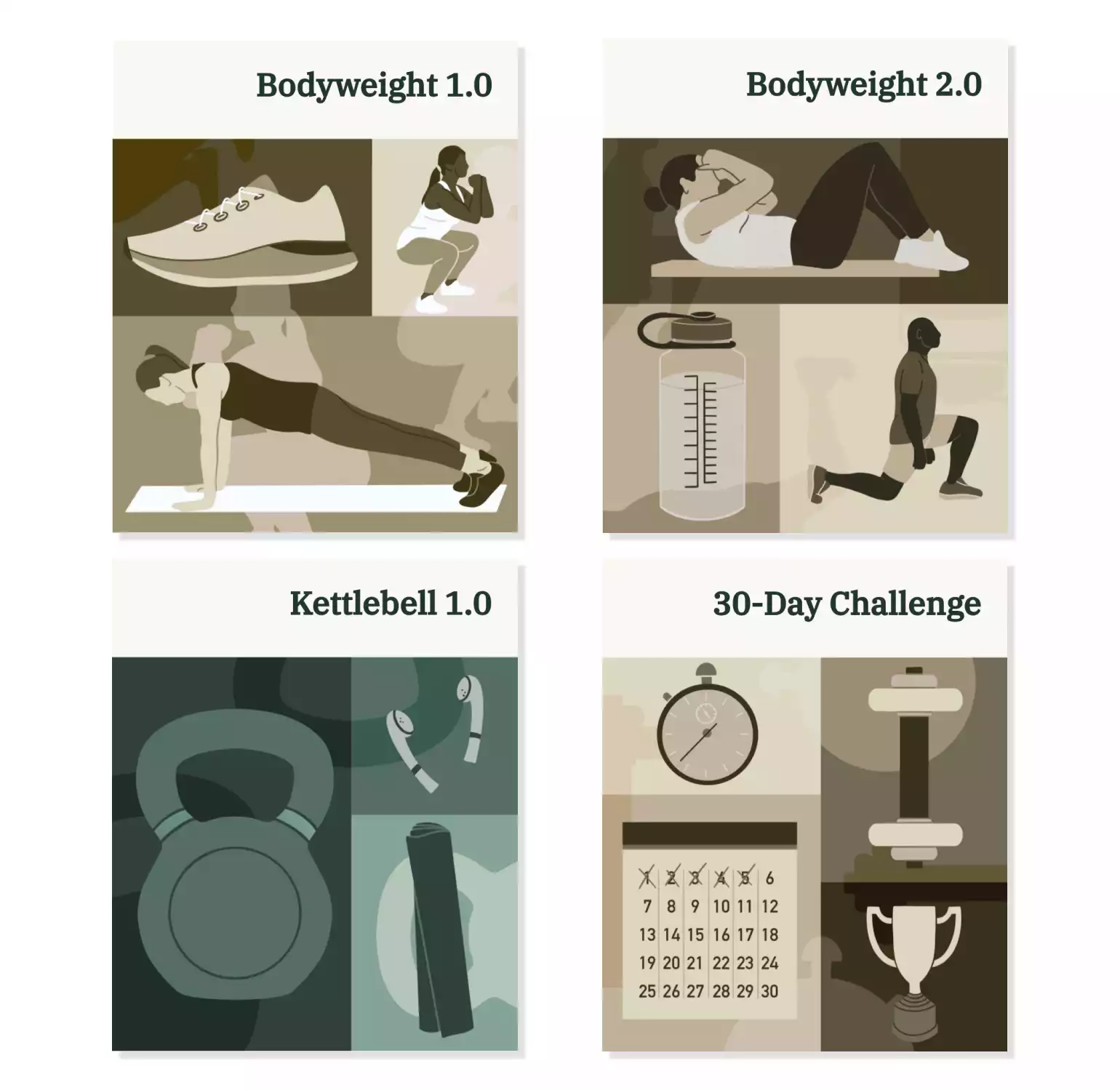
- Bodyweight 1.0
- Bodyweight 2.0
- Kettlebell 1.0
- 30-Day Challenge
- Bonus module: Intro to Nutrition and Healthy Eating
- Over 12 weeks of calisthenics workouts
- Beginner to intermediate levels
- Progressive calisthenics: Start with the basics and improve with time
Choose a Program Based on Your Goals
No matter what activity you choose as your primary mode of exercise, it’s important to pick a program that aligns with your goals. If your main goal is to work on your endurance so you don’t get winded as easily when hiking, a program that’s primarily focused on building muscle wouldn’t be as effective as an endurance program.
Some programs don’t really have a stated goal and are more focused on general fitness. That is okay too, but be careful not to choose something that’s too vague. Just like your goals should be specific and measurable, the goals of the program should be, too. Ideally, those goals will be pretty well aligned.
Make Sure the Program Matches Your Level
As a beginner, you’ll want to make sure you’re not biting off more than you can chew. A common mistake people make is buying the flashiest, most popular program on the market, only to find they can’t possibly keep up.
When choosing a program, look at the program’s expectations.
- Do many of the starting exercise variations look impossible to you?
- Does the program entail nonstop work at a relatively high level of intensity?
- Are there clear explanations for exercise technique, or does the program assume you already know what to do for basic exercises?
Be honest with yourself about where you’re starting from and evaluate the program accordingly. Don’t choose a program just because a friend raves about it—you may not be starting from the same place as them.
Building Your Own Training Program
You might decide to build your own exercise program instead of buying or using a ready-made one.
Maybe you have a specific goal that requires a more tailored approach. Or perhaps you’re looking to save money.
Whatever your reason, experimenting with making your own program is a great way to understand exercise methodology.
You can build a workout in many ways, but we’ll give you a framework for understanding which components are most important.
Minimum Effective Dose
The concept of “minimum effective dose” is uncomfortable for many people because it goes against what so many of us have been taught. It’s the direct opposite of “more is better.”
Rather than trying to do as much as you can before collapsing, this concept challenges you to do the least amount possible to see results. Before building an exercise program, try to adopt this mindset that you don’t need to do a lot to see results—especially as a beginner.
Start with less. You can always add more later if you are able to.
General Program Structure
With the “less is more” mindset, you’ll be able to build a healthy and sustainable exercise program. From here, there are four components you’ll need to decide on:
This is what type of exercise you’ll be doing. As we discussed in the section on choosing a program , you can really choose anything. As long as you’re moving your body and the type of exercise you’re doing supports your goals, everything else is a personal choice.
We recommend, of course, choosing a mode of exercise you enjoy. If it feels like a chore every time you do it, you’re just not as likely to keep showing up.
You’ll need to decide in advance how often you want to work out. We recommend three to five times per week, but this is ultimately going to depend on your lifestyle and preferences.
If you have commitments like a rigorous job or small children at home, it might be more realistic to start with fewer dedicated workouts each week. Or, you might find you’re more consistent in your training when you work it into your schedule more often.
Think about your life realistically, and plan on a frequency that you can stick to. This allows you to get a baseline, which you can always adjust or build upon as you progress.
Here’s where you’ll decide how intensely you want to be working. There are objective and subjective ways of determining intensity.
Objective measures include things like setting a target heart rate, speed on a treadmill, or revolutions per minute (RPM) on a bike.
There are various scales for subjective measurements of intensity, but a good one is the ratings of perceived exertion (RPE) scale:
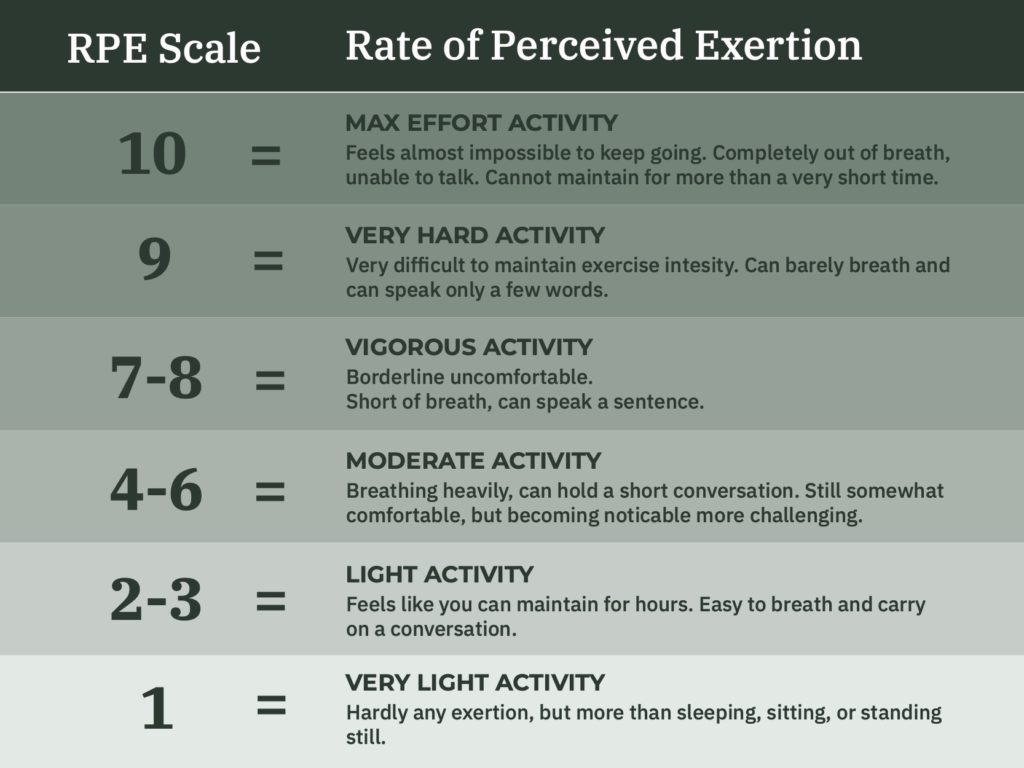
You may want to create your program with a mix of higher- and lower-intensity activity. It’s not a good idea to be at a 9 or 10 on the RPE scale with every single workout (most people really don’t need to go above a 7/8 ever).
This last component defines how long your sessions will be. It doesn’t have to be the same every time, and it’s important to build some flexibility into your planning since life is rarely predictable and steady.
With that said, try to think about what would be an ideal amount of time to spend on a workout session.
If you’re one of those people who has a lot of internal motivation for exercising and you just love working out, you might relish an hour-long exercise session. For the rest of us, remember it’s about quality over quantity. If you only have 20 minutes you can devote to a workout, then plan for that. Whatever’s realistic.
Creating a Workout for Different Goals
If you choose a less traditional form of exercise (say, dance or swimming), you’ll still want to think about frequency, intensity, and duration, but you may be better off turning to experts on the particular activity for help building a training program.
With more traditional forms of exercise (like bodyweight training or weightlifting), it’s a bit simpler to provide guidance on building workouts.
In general, here’s what we recommend depending on your goal:
- Building strength : use a relatively harder variation of a given exercise for 2–4 sets of 4–6 repetitions per exercise.
- Hypertrophy (building muscle) : work with a relatively easier variation that you can do for 2–4 sets of 8–12 repetitions per exercise.
- Building endurance : choose an even easier variation that you can do for 2–4 sets of 12–20 repetitions per exercise .
To gauge the difficulty of an exercise variation, you’ll want to pick a variation where you can do the recommended number of repetitions while keeping a couple of reps in the tank.
So, for example, if you’re working on squats with a goal of building strength, you’ll want to pick a variation of the squat where the absolute maximum you can do is eight reps, but you’ll stop at six. That way, you always stay fresh and can make sure to do each exercise with proper and safe form.
Going From Zero to Advanced Exerciser
How do you progress from absolutely zero knowledge all the way to an advanced exerciser? We’ll show you. Understand, though, that progress is rarely linear.
These benchmarks will give you some general guidelines for navigating through different stages of training. Along the way, though, you might advance more quickly in one area than in another. Or, you might move backward in certain areas at different points in time. That’s okay.
As you’ll see, the key to becoming a lifelong exerciser is to be as consistent as possible in your efforts, and that’s true no matter what stage you’re starting from. We’ll look at four levels:
- Intermediate
Starting From Zero
There are many people starting an exercise program who need to take a step back from even beginner-level exercises.
It’s possible you’ve gone years without moving your body in a purposeful way.
There’s no judgment or shame in being honest with yourself about your level of activity. It’s important to know where you’re starting from so that you can take this important step in an enjoyable and sustainable way.
If you’re starting from this place of zero activity, what can you do to get yourself to beginner level? Start with gentle movements, like:
- Easy hikes in nature
- Basic bodyweight movements like marching in place or squatting while holding onto a support.
The most important thing at this stage is creating a consistent habit. Don’t worry too much about achieving lofty goals. Your only real goal should be to make movement a regular part of your life—something you do every day for at least a few minutes.
At this early stage in your journey, one of the best things you can do is start a consistent walking program—some of the most successful and sustainable exercise programs are based on walking alone.
Start with a walk around the block every day, then build up to a mile or two per day. This might not sound like a lot, but it can be quite challenging if you’re starting from zero. And making this a part of your daily routine will help you stay consistent with more advanced training as you improve.
Progressing to Beginner Level
Once you’re moving more regularly and are comfortable with basic movements and stretches, you can start working on beginner-level exercises. Here are some ways you can bump up your level of intensity:
- Increase your distance on your walking program, or begin speed walking or jogging.
- Start doing hikes at a moderate level of intensity.
- Make your stretching more dynamic by including yoga fundamentals.
- Try some standard bodyweight exercises, like beginner variations of push-ups or squats. (See our Bodyweight Training Guide for detailed beginner-friendly exercises.)
At this level, it’s important to go back to the goal-setting exercises from earlier. Setting clear goals will help you maintain the consistency you’ve been building. Staying consistent at every level is the necessary ingredient for making this a lifelong endeavor.
Moving up to Intermediate Level
You’ve been at this for a while now. You’re comfortable doing beginner-level progressions of bodyweight exercises like push-ups, squats, and deadlifts. You’re stretching regularly, and you’re on a consistent walking or jogging program. You’re doing activities you love (or have learned to love), so you’ve successfully made exercise a sustainable habit. This is a part of your life now.
At the intermediate level, you can start to:
- Add sprints or intervals into your jogging sessions.
- Do more advanced bodyweight exercise variations.
- Incorporate some weighted strength training with barbells or kettlebells. (See our Strength Training Guide for detailed strength-based exercises.)
As you progress, revisit your goals as necessary—what motivated you at level zero isn’t necessarily going to motivate you now.
Becoming an Advanced Exerciser
This is the goal for many people—to achieve an advanced level of skill and ability. It’s not the right goal for everyone, though. You have to know yourself and understand what’s a realistic, motivating, and healthy goalpost for you.
If you do decide you want to achieve this level of exercise, here’s what that might look like:
- Add hill sprints into your running sessions.
- Do high-intensity interval training (HIIT).
- Use heavier kettlebells or barbells, or practice more technically advanced exercises (such as the Turkish get-up).
- Work on advanced bodyweight exercises like handstands, pull-ups, and gymnastic ring exercises.
The sky’s the limit with what you can work on when you reach a certain level of skill and ability with your exercise. Just pay attention to the following:
- Are you able to maintain your consistency when working at such a high level?
- How does your body feel? If you’re getting injured all the time doing advanced exercises, that’s not going to be sustainable.
- Is this advanced level of work having any impact (positive or negative) on your mental health?
There isn’t a right or wrong answer to any of these questions. It’s important, though, to pay attention to these things, especially as you keep advancing.
Managing Plateaus or Setbacks
There’s something magical about those early days of a new exercise program. You feel excited about the work you’re putting in, and you see consistent results adding up with almost every workout session.
…until you don’t.
After a few weeks or a few months, you hit a wall. It gets harder to muster up excitement for your training sessions, even when you use all the techniques we’ve described throughout this guide. What now?
Don’t Panic and Don’t Give Up
When you hit a plateau like that, it can be tempting to lean into one of two feelings:
- Panic. This is never going to work!
- Resignation. I’m just going to quit while I’m ahead.
We’ve all been there, so we get it. Let’s take a step back to set some realistic expectations.
Reality check #1: Plateaus are inevitable.
No matter your experience level or the amount of effort you’ve put into setting yourself up for success, you’ll likely come across plateaus or setbacks at some point.
Our bodies and minds adapt quickly, especially when starting something new, so when it’s not so new anymore, you’re not as likely to see the same results consistently.
That’s okay. Actually, it’s a good thing. Hitting plateaus means you’re putting in consistent effort.
Reality check #2: Setbacks are unavoidable.
Setbacks can happen for all sorts of reasons—injury, depression, vacation, new job, pandemic, etc. The key is knowing that when a setback happens, it doesn’t have to mean the end of all your progress.
With these realistic expectations in mind, we can go over some strategies for managing setbacks and plateaus when they happen.
How to Manage a Plateau
A plateau is usually seen as a bad thing in the context of an exercise program. It’s when you hit a period of little to no progress and things stay pretty flat for a while.
Here are two main ways to deal with a plateau:
Ride it out
Sometimes, the best way to deal with a plateau is to embrace it and ride it out. It’s unlikely that you’ll be stuck at that same plateau for very long. Often, if you lean into the plateau and just keep showing up, you’ll find yourself on the other side of that plateau within a couple of weeks. If a month or so goes by and you’re still in the same spot, though, it’s probably time to go into troubleshooting mode.
Troubleshoot
Switching things up may mean changing your program entirely or adjusting specific aspects of your program. Go back to the four components of your program we discussed earlier: mode, frequency, intensity, and duration.
Perhaps you need to try a different mode of exercise for a change, or it could be that your body needs a rest in which case you might cut back on intensity or frequency temporarily.
It may take some trial and error to see if changing one or more of these components gets you back on track.
Getting Back on Track Right Away
When you hit a setback and miss a planned session, it can be tempting to go into all-or-nothing mode.
James Clear, who’s a master at habit-building, talks about the importance of “avoiding the second mistake.” Or, as we like to say: Don’t miss twice.
Just because you missed one workout doesn’t mean all of your efforts at exercising should go out the window. Consistent work is the most important thing in building this lifelong habit, and means showing up next time, even if you couldn’t get yourself to the gym this time.
Go back to square one and figure out what changes you need to make to your routine so that you have the best chance of showing up to your next session.
Making This a Lifelong Journey
So, how can you sustain this new exercise journey for the rest of your life? It comes down to three things:
- Staying consistent
- Engaging in self-reflection
- Expecting nonlinear progress
Consistency is Key
Showing up consistently is far more important than all the other details of your exercise program.
It’s more important than what type of exercise you do, how intensely you work out, or even how frequently you exercise. Find something you enjoy and just keep showing up. That’s what creates a sustainable habit.
People overestimate what they can do in an hour and underestimate what they can accomplish in a decade. We think that if we work as hard as possible in an hour-long workout, we should see results right away. When that doesn’t happen, we’re disappointed and may be tempted to give up.
But any accomplishment takes time, and exercise is no different. Even when you’re just getting started, remember that this is a lifelong journey and results accumulate over time.
Your “Why” Will Change
As you get older and have different life experiences, your “why” is going to change. Very few people have the same motivating factors at 20 as they do at 40.
What’s important, then, is continuing to be self-reflective.
Revisit the exercises from the beginning of this guide periodically to make sure you’re clear on what’s most important to you. We recommend going through those exercises at least once a year, reminding yourself of your “why” throughout the year.
Progress Isn’t Linear
You’re going to face ups and downs in your exercise journey, and there will be times when you feel like you’re not making any progress at all—or worse, like you’ve gone backward. You haven’t. Just keep showing up consistently and it will lead to progress.
One year from now, you can look back and know that you’ve made progress because you started this journey—and starting is half the battle.
If you have started and are ready to move forward, check out our guides and training plans to see if there’s a good fit for you.
Other Guides
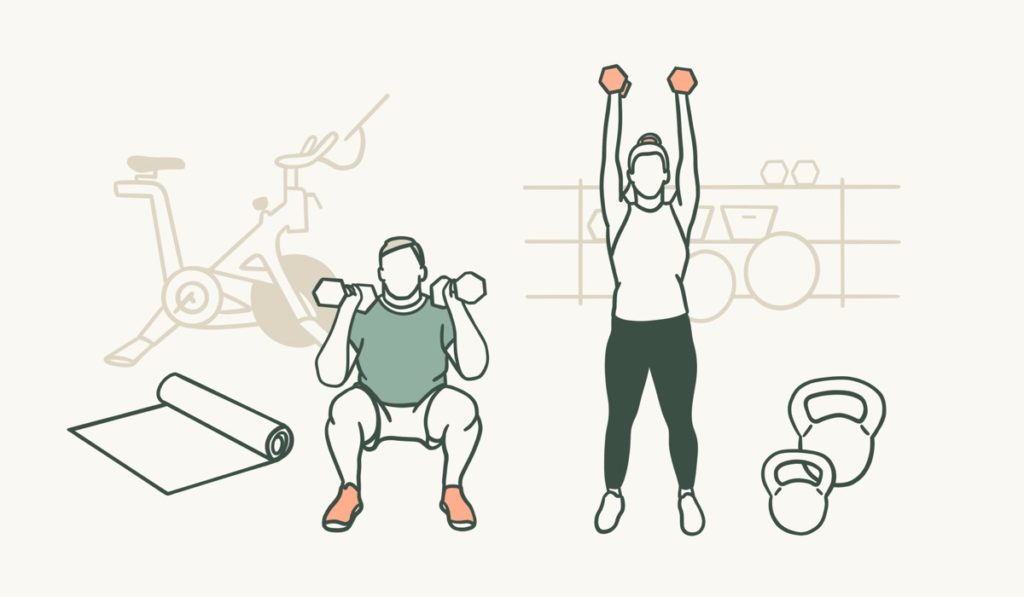
Intro to Strength Training

Intro to Nutrition & Healthy Eating

The Paleo Diet Explained
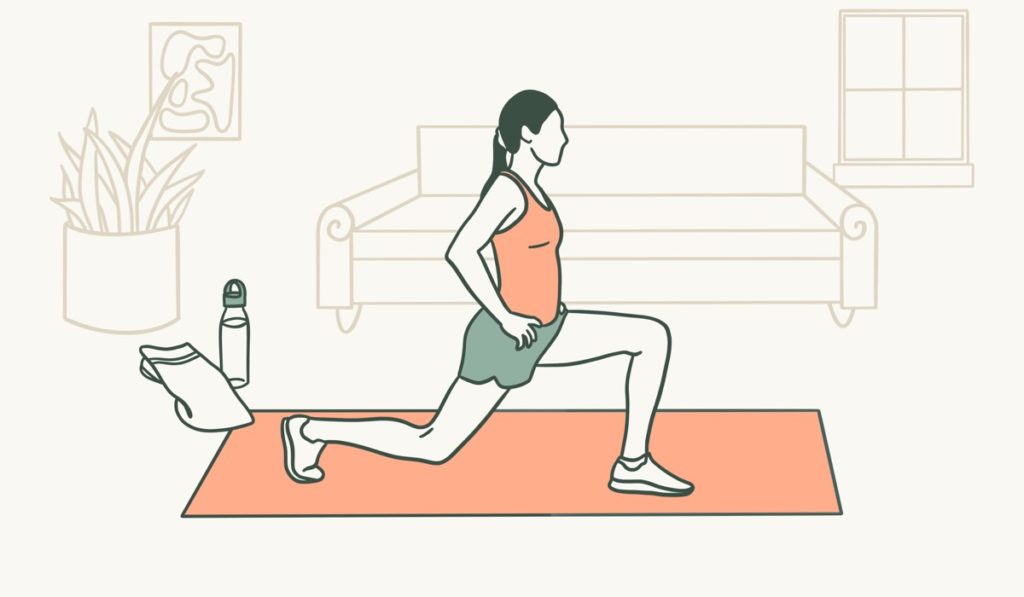
Guide to Bodyweight Training
Sign up to receive a free workout every Wednesday!!

If you’re willing to put in the work, we’ll provide the resources to help propel you forward.

TOP CATEGORIES
TheHybridAthlete.com does not intend to provide medical advice. We go to great lengths to help our readers better understand their bodies and their health; however, the content on this website is not a substitute for medical guidance. For more information, please read our privacy policy .
© 2022 All Rights Reserved
Affiliate programs.
TheHybridAthlete.com is a participant in the Amazon Services LLC Associates Program, an affiliate advertising program designed to provide a means for sites to earn advertising fees by advertising and linking to Amazon.com. *Amazon and the Amazon logo are trademarks of Amazon.com, Inc., or its affiliates. Additionally, TheHybridAthlete.com participates in various other affiliate programs, and we sometimes get a commission through purchases made through our links.
It’s time for your 2023 fitness journey—here’s how to get started
Here's how to help the new you achieve those fitness goals.
By Sandra Gutierrez G. | Published Jan 15, 2023 9:00 AM EST
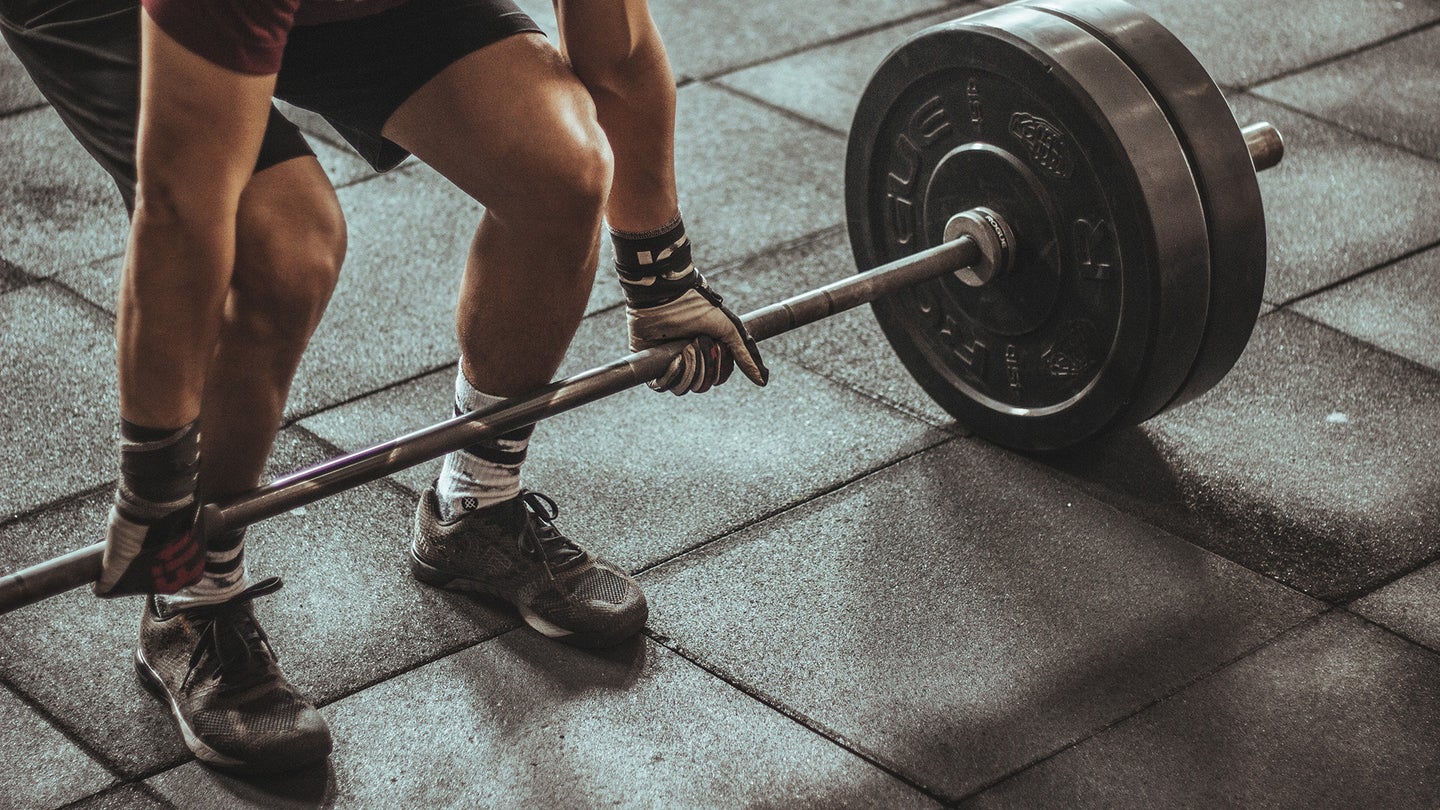
A new year is always a fresh opportunity to start your fitness journey. This can mean anything, whether you’d just like to get off the couch more often, want to run a 5K, or are hoping to win a bodybuilding competition by 2024.
You may not be sure about how to achieve your goals, but that’s ok. Having the motivation to get out there is half the battle, and we want to help you along your way.
PopSci has a number of science-backed fitness stories to guide you in this new era. You’ll learn how to make the best of your workouts, how to get gains safely and consistently, and how to keep your body healthy along the way.
Understand how to build muscle
Fitness novices might think getting buff is just about lifting heavy objects over and over again. In a nutshell, it sort of is, but there’s a lot more to it. Learning about muscles and how your body builds them will help you understand concepts like hypertrophy and failure, and allow you to get the most out of each workout.
Our guide on how to get muscle gains will walk you through that process and explain how resting is as important as going to the gym, and how protein is a crucial element your body needs to build more mass.
[Related: You should definitely rotate your workouts ]
Food restrictions like veganism can seem like an added layer of difficulty when it comes to including enough protein in your diet, but getting those gains doesn’t require you to become a carnivore. If you need guidance, head on over to our vegan guide on how to get muscle gains and learn about the foods that will give you the nutrients you need to achieve your fitness goals.
Don’t forget to warm up
Whatever sport or discipline you choose, one of the most common mistakes fitness noobs make when they start working out is to skip warmups. They can seem boring and pointless because you may feel like you don’t actually need them, but trust us: your body does. Warming up properly before you go for a jog or start lifting will help you perform better and prevent injuries in the long run, which will allow you to take your fitness journey even further.
But before you repeat the same stationary stretches you might remember from PE class, give dynamic warmups a try . These exercises will not only tell your brain it’s time to move—which is especially important after sitting at a desk for a while—but will also prepare your body for physical activity by getting your blood flowing and your heart rate up.
Help your body recover
You may think that when it comes to exercise, more is better. And since you’re already motivated and proud of your effort, why not keep going? Well, giving your body time to recover is also essential to your fitness journey.
But other than resting, there are other techniques you can use to help your muscles feel better after a heavy workout . That annoying and painful soreness you feel around 24 hours after your last gym session is a result of muscle damage, and recovery techniques can help you handle the pain and help tissue heal faster.
From classic stretching to foam rollers, ice baths, and massages, our guide on what works when it comes to recovery can be exactly what you need when your muscles are so sore that getting off your chair comes with excruciating pain.
Once you’re at least a couple of months into your journey and have made a little progress, you might find yourself hitting a wall that makes results harder to come by. This is normal and happens to a lot of people as their bodies change. To get back on that progress train, you might need more data about what you’re putting into your body, and tracking your nutrition can be incredibly useful for that.
Knowing your maintenance rate—the number of calories you burn simply by existing—can give you a baseline to adjust the number of calories you eat every day to keep the muscles growing and fat-burning going.
It’s important to know that monitoring your food can be a slippery slope to unhealthy habits, so make sure to do it only for short periods of time, and to follow experts’ recommendations regarding calorie surplus and deficit. And if you don’t know what those are, don’t worry—it’s all in our guide.
Measure progress
Data not only shows you how much to eat but also how far you’ve come. Gathering information about your workouts will make it easier to measure your progress, and you’ll be able to celebrate even the smallest victories so you can push yourself a bit further.
Getting a fitness tracker can help compile all the statistics you need to keep going and improving—all you need is to put it on and go do your best. And if you don’t know which wearable to get, we have some recommendations that might lead you in the right direction.
The type of device you get will highly depend on your budget and your preferred activity, but there are a lot of options to choose from, and they can all give you that extra motivation you need to face another day of your fitness journey.
Try getting a little help from supplements
Nutritional supplements can help get your body what it needs to perform better, stay healthy, and build muscle. But a quick trip to your local drugstore is enough to get anyone incredibly confused. The market is saturated with options, so which supplements actually work?
[Related: The three strength exercises everyone should do ]
When it comes to building muscle and improving performance, science has only found two supplements that will help . Learning how to take them and how they work for your body will help you have a better understanding of your process. Keep in mind that you may need to consult a doctor before you start supplementing your nutrition, and also remember supplements don’t do miracles. Moving, resting, and, above all, patience, will keep you on a good path to your fitness goals.

Sandra Gutierrez is the former Associate DIY editor at Popular Science. She makes a living by turning those “Wait, I can make that!” moments she has while browsing the internet into fully-fledged stories—and she loves that. Contact the author here.
Like science, tech, and DIY projects?
Sign up to receive Popular Science's emails and get the highlights.
Choose a Location.
Launching your fitness journey: a guide to gym routine for beginners.

Starting a gym routine can be intimidating, confusing and even frustrating, especially after a long hiatus from working out. With so many options and a plethora of information available at your fingertips, it can be a challenge to navigate and know how to get started. With some planning and goal setting, you can find a manageable routine that can have long lasting physical and mental health benefits. There really is no right or wrong way – the reality is, to be successful you must find a routine you can be consistent with and incorporate into your daily life on a regular basis. View our Frequently Asked Questions that we have curated over the years to learn more about the Orangetheory Fitness workout.
Too many people get caught up in the mindset of “is this the best way to work out?” instead of adopting the mindset of “is this the best way to work out for my life right now?” Before you start setting your goals or workout routine plans, first spend some time considering how much time you can realistically spend each day exercising. Be real with where you are: if you currently don’t exercise at all, do not jump to working out five or six days a week. Instead, try two or three times a week. Chances are, as you begin to feel the benefits you will start problem solving for how you can fit it in more—but give yourself time to establish consistency first. Learn more about the importance of a “Cooldown” to reduce the risk of injury and more!
The Importance of Starting with Low Intensity
Once you figure out a reasonable amount of time you can dedicate to exercising each week, think about your long-term goals. Are you looking for improved health markers, increased stamina, greater strength or fat loss? Are you wanting to train for a specific event like a 5K, adventure race or hiking trip? No matter the goal, if you are a beginner or coming back after a significant time off, you will need some short-term goals to improve your fitness foundations before you start catering your routine to specific long-term goals.
Long-term goals provide motivation, while short-term goals build the foundation necessary to achieve your larger aspirations. A few key fitness foundations incorporate cardiovascular endurance, muscular strength, joint mobility and stability and recovery. You want a strong foundation to build upon! If you do not build this foundation first, you run the risk of injury or burn out which will set you back from reaching those bigger goals.
Beginner-Friendly Workouts Explained
- Cardiovascular Endurance: Begin with low-impact exercises like cycling, treadmill walking or swimming. Start with short sessions (10-20 minutes) and over time increase the duration. Once you get up to 30-60 minutes you can go back to the shorter sessions but increase the intensity (i.e. adding incline to your treadmill). The best cardio exercise? The one you like the most!
- Muscular Strength: Incorporate resistance training exercises using your body weight, light-to-moderate loads or bands. Aim to get in two or three sessions a week and do a minimum of one set for each major muscle group. To maximize your time, do compound movements that involve more than one muscle group at a time (i.e. squats, push-ups, lunges and rows). Include joint stability and core into your program (i.e. planks, bridges).
- Joint Mobility: You can incorporate this by starting each exercise session with a dynamic warm-up that focuses on joint mobility (i.e. hip and arm circles).
- Recovery: Include rest days in your routine to allow your body to adapt to the stress of exercise. Nutrition, hydration and sleep are keys to adequate recovery too.
Constructing Your Weekly Workout Plan
Below is a sample weekly routine you can follow or use for inspiration to get started. It includes the major movements you want to incorporate (push, pull, squat, lunge, hinge and core). Remember, if you are aiming for 20 minutes of cardio, that could mean you do ten minutes in the morning and ten minutes in the afternoon. Start each workout with a dynamic warm-up and finish with a cool-down/stretch.
This plan has an upper and lower strength training session that is quick. Then, put these together for two longer workout sessions the next week. Have less time? Ditch the upper and lower workouts and do the total body workout two to three times a week. In general, you can do lower and upper strength training on consecutive days, but you will want to allow time for your muscles to rest in between total body strength sessions. Keep in mind recovery needs variation and change as your fitness level changes.
Be sure to have some way to track your workouts – you deserve to give yourself credit for your hard work! A visual display of your progress (whether in an app or on your desk) can help you stay motivated. At Orangetheory Fitness, we track all your workouts within our mobile app so that our members can see their progress in real-time and over time.

Incorporating Community Wisdom
Managing your own fitness programming can be challenging—especially if you don’t know how to adapt and evolve your workouts as you progress. This is where a fitness professional can help guide you, whether that be a personal trainer, online workout program or a boutique studio like Orangetheory that provides daily programming and a coach to customize each workout to your needs. A studio like Orangetheory also provides a community of people with similar aspirations to yours to foster accountability and help you be successful.
No matter what your goals or weekly routine look like, the most important aspect of your success is consistency. It can take several months before you start seeing and feeling the effects, so be patient, be consistent and stay the course. One of the most important things you can do for your long-term health is exercise – you are worth the work!
Rachel Vaziralli, Orangetheory Fitness's Director of Fitness Design, oversees the creation of their heart rate-based workout program, leveraging science, technology, and coaching to help members live a longer, more vibrant life. With a rich background in fitness, including roles at Equinox and extensive education in dance and exercise physiology, Rachel brings a wealth of experience to her current position. Based in Boca Raton, Florida, she remains dedicated to helping individuals unlock their maximum fitness potential.

Free Intro Class*
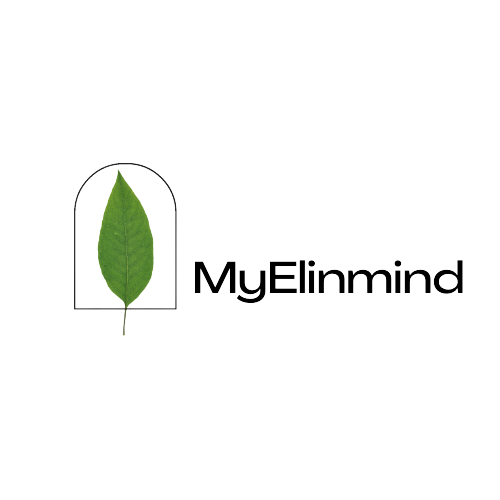
How to start a fitness journey
There is no end to a fitness journey. While you find the result from that journey you cannot stop there, because you need to keep pushing yourself to maintain it. Most people anticipate immediate results. Remember that you are committing to a longer journey and it will be difficult. Trusting the process and working for that will reward healthy life. “Once you started a fitness journey, there is no going back” – Unknown
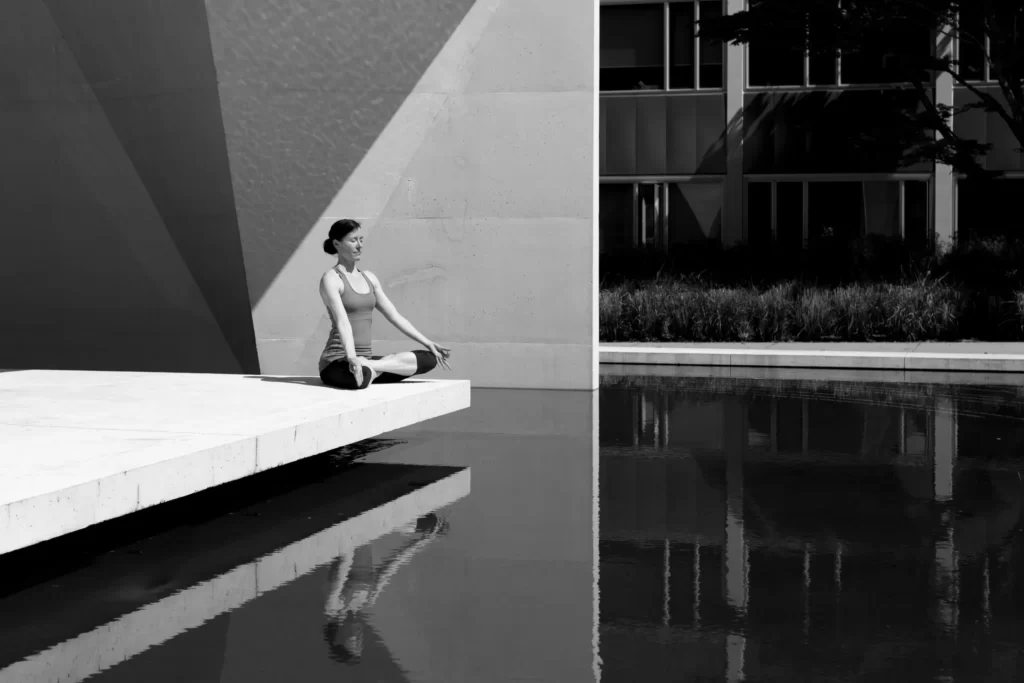
Get started on the journey
We made a question-answer survey on our Instagram page on the topic of “What holds them back from starting their fitness journey?”. And we found that most people don’t know where to start and how to set a fitness journey. In this blog, we help them by giving a step-by-step process to get started and maintain their fitness journey.
Defining why:
Before starting your fitness journey, you should ask yourself why you want to improve your health and fitness. Whether it’s to increase energy levels, enhance self-confidence, manage weight, or improve overall well-being, clarifying your “why” will serve as a powerful driving force throughout your journey.
It allows you to build a strong foundation that can sustain your dedication and perseverance, even when faced with challenges or setbacks along the way
Identifying your current fitness level:
Evaluating and identifying your current fitness level makes determine your starting point. You can assess your fitness level by checking cardiovascular endurance, strength, flexibility, and body composition. It can be identified by checking yourself or by approaching a fitness professional.
Ways to check your current fitness level
Cardiovascular Endurance : Test your cardiovascular fitness by performing activities that raise your heart rate, such as running, cycling, or brisk walking. Note how long you can sustain the activity and how quickly your heart rate recovers afterward.
Strength and Muscular Endurance : strength by performing exercises like push-ups, squats, or planks. Take note of how many repetitions you can perform with proper form.
Flexibility : Test your flexibility by performing stretches for different muscle groups, such as touching your toes or performing a seated hamstring stretch.
Body Composition : Assess your body composition by measuring your weight, body mass index (BMI), or body fat percentage.
Functional Movements : Observe how well you can perform functional movements like squatting, bending, or lifting. Note any limitations or difficulties you experience during these movements.
Daily Activities : Pay attention to your performance during everyday activities like walking up stairs, carrying groceries, or participating in recreational activities.
Subjective Assessment : Reflect on your perceived level of fitness and overall energy levels throughout the day. Consider how you feel during physical activities and if you feel generally fit and healthy.
It allows you to identify your strengths and weakness and areas to need improvement. However, you can also make informed decisions regarding exercise selection, intensity, and progression, ensuring that your fitness journey is safe, effective, and tailored to your individual needs
Set SMART goals
Establish Specific, Measurable, Achievable, Relevant, and Time-bound ( SMART ) goals to provide clarity and direction. For example, instead of a vague goal like “get fit,” set specific goals like “run a 5K in three months” or “lose 10 pounds in three months.” SMART goals will help you track progress and stay motivated.
Specific – This means setting a goal rather than setting a general goal like “get fit” to “increase muscle strength and tone” or “improve flexibility.
Measurable – It means setting goals that can be measured and tracking your progress. For example, “complete 30 minutes of cardio exercise four times a week” or “perform 10 push-ups without rest”.
Achievable – rather than investing your time and effort in unrealistic goals, you should focus on realistic and actionable goals. For example, if you are a beginner, you may not be able to achieve your goal of running a marathon in a month. Instead, set a goal to run a 5K race within a certain time frame.
Relevant – Prioritize your goals based on what you want to achieve.
Time-bound – By setting a time frame to achieve your goal you can be motivated and focused on your goals. Take it as a challenge to like you will lose 3kg within a month. By achieving that goal you will be highly confident and inspirational yourself and work for better output.
Choose suitable activities
There will be multiple ways to achieve your goal. You can lose weight through different types of training like cardio, and running and by connecting it with your personal interests you will enjoy what you are doing. It will help you to stay focused on your goal.
Create a structured workout plan
Before starting a fitness journey you need a well-structured workout plan. Remember that for overall fitness you need a clear balance and incorporate cardiovascular exercise, strength training, and flexibility exercises. Start with a low-intensity workout and gradually increase intensity and duration over time.
Seek professional guidance
As a beginner, you don’t know how to protect your body from injury and keep proper form while workout. It is better to consider consulting with a certified fitness professional. They can help you to design a Personalized workout plan and ensure proper form and technique.
Nutrition is the key
By identifying your goal that what you want to achieve you need to take enough nutrition to fuel Your body with a well-balanced diet that includes lean proteins, whole grains, fruits and vegetables, and healthy fats. If you are looking to gain weight then you will need to consume healthy fats and protein. Examples include whole grains, dried fruit, potatoes, avocados, oily fish, eggs, and dairy products.
Create a support system
Fitness is a long journey and consistency is one of the keys to success. To keep consistency and working toward goals we need motivation. you may be exhausted and unmotivated sometimes. Staying with a supportive community or surroundings will help you to encourage and get support from them. You can share your fitness goals with friends, and family, or join fitness groups, online communities, and workout classes.
Track progress and audit
Monitoring your progress regularly or during specific time periods will be motivational and boost your confidence. You can take images of each month and see how you are becoming changing. By tracking your progress you can make necessary changes to your workout plan or nutrition to continue hard work towards your goal.
Embrace a growth mindset
It is a long journey and you need to develop a growth mindset to approach that. Remember that progress takes time and you need to be patient with yourself. Each small step you make contributes to your overall success.
As I said earlier there is no end to the journey. after you achieve your goal, you have to continue the process to maintain your fitness level. Otherwise, you will lose your strength, form, and confidence as well. However, by following the above steps you can start your fitness journey and improved your health, and increased your strength. Remember, the journey is unique to you, so enjoy the process and celebrate every milestone along the way
GET A FREE SHAKER ON ORDER ABOVE 5000/-
- BMI Calculator
- Login/Sign Up

- All Accessories Best Sellers Clearance Sale Gainers General Wellnes Glanbia Goals Gym Accessories Gym Bags Membership Proteins Shakers Strength & Stamina Uncategorized Vegan Protein Weight Loss Search for:
No products in the cart.
- Whey Protein
- Whey Isolate
- Whey Hydrolysed
- Casein Protein
- Vegan Protein
- Peanut Butter
- Protein Snacks
- Mass Gainers
- Weight Gainer
- Carbohydrates
- Pre Workouts
- BCAAs & Aminos
- Nitric Oxide
- Fat Burners
- L-Carnitine
- Multivitamins
- Fish Oil & Omegas
- Joint Support
- Liver Support
- Testosterone Boosters
- Growth Hormone Support
- Allmax Nutrition
- ANS Performance
- Applied Nutrition
- BigMuscles Nutrition
- Bulk Sports
- Cloma Pharma Laboratories
- Dymatize Nutrition
- Dedicated Nutrition
- Doctor’s Choice
- Domin8r Nutrition
- Dragon Pharma
- Dynamik Muscle
- Enhanced Athlete
- Evlution Nutrition
- Gaspari Nutrition
- HealthFarm Nutrition
- HF Nutrition
- Innovative Labs
- Insane Labz
- International Protein
- Kevin Levrone
- Killer Labz
- Labrada Nutrition
- Libertylabz
- Muscle Club
- Muscle Science
- MusclePharm (MP)
- Nutrex Research
- Nutrition Bizz
- One Science Nutrition
- Optimum Nutrition
- Performax Labs
- Pole Nutrition
- Revange Nutrition
- RiteBite Nutrition
- Ronnie Coleman
- RSP Nutrition
- Sunline Alaska
- Ultimate Nutrition
- Terror Labz
- UP Nutrition
- VitaXtrong (VX)
- Universal Nutrition
- Diuretic / Water Loss
- Authenticity
- Store Locator
- Top 10 Supplements
- Bmi-Calculator
- Clearance Sale
Blog , Health & Lifestyle
10 effective tips for starting a fitness journey.

Embarking on a fitness journey can seem daunting, particularly if you’re unaccustomed to physical activity and wellness practices. Nevertheless, by adopting a positive attitude and a strategic method, you can successfully attain your fitness objectives and revolutionize your lifestyle.
Here are 10 Effective Tips for Starting a Fitness Journey:
1. set realistic goals.
To begin a fitness journey, it is important to establish practical objectives/goals. These objectives should be attainable, precise, quantifiable, and have a time limit. For instance, rather than aiming to shed 50 pounds in a month, strive to lose 1-2 pounds every week for six months.
2. Find an Exercise You Enjoy
To maintain a consistent fitness regimen, it is crucial to discover an exercise that brings you pleasure. Whether it is jogging, swimming, biking, or practicing yoga, select an activity that suits your lifestyle and that you eagerly anticipate engaging in.
3. Start Slowly and Gradually Increase the Intensity
To avoid injury and ensure long-term strength and endurance, it is crucial to begin your workouts slowly and gradually increase the intensity.
4. Make Time for Exercise
Make exercise a priority in your daily routine. Schedule it into your calendar and treat it like any other appointment. Sticking to your fitness routine and turning it into a regular habit can be facilitated by this.
5. Get a Workout Buddy
To maintain your motivation and responsibility towards your fitness routine, having a workout partner can be beneficial. Look for a friend or family member who has similar fitness objectives as you and plan regular workout sessions together.
6. Mix Up Your Workouts
To achieve optimal results in exercise, it is important to maintain variety in your workouts. This can be achieved by incorporating different activities, changing your routine, and including both strength training and cardio exercises. Varying your workouts can help you maintain engagement and provide your body with diverse challenges.
7. Fuel Your Body with Healthy Foods
To sustain your body and achieve your fitness objectives, it is crucial to consume a nutritious diet. Incorporate entire, nutrient-dense foods such as fruits, vegetables, lean protein, and healthy fats.
8. Stay Hydrated
Staying hydrated is important for your optimal health and fitness, as it helps regulate your body temperature, lubricate joints , and aid in digestion. Monitor your urine color to ensure you’re adequately hydrated. Make sure to consume sufficient water both during your exercise routine and throughout the day.
9. Get Enough Rest and Recovery
To attain your fitness objectives, it is equally crucial to prioritize rest and recuperation as much as exercising. Take rest days, get proper sleep, and add stretching and foam rolling into your regimen.
10. Celebrate Your Progress
Finally, celebrate your progress along the way. Whether it’s hitting a new personal record or simply sticking to your routine for a week, take time to acknowledge your achievements and reward yourself for your hard work.
Embarking on a fitness journey can pose difficulties, however, by implementing these ten practical suggestions, you can establish a strong foundation for triumph and attain your objectives. Remember to stay committed, stay positive, and enjoy the journey!
Starting a fitness journey is an exciting adventure, and choosing an exercise program that you love is a critical step toward long-term success. By trying different types of exercises, considering your preferences and interests, setting realistic expectations, mixing up your routine, and finding a workout buddy, you can discover activities that bring you joy and make your fitness journey more enjoyable.
Remember that everyone’s fitness journey is different, so listen to your body, establish reasonable objectives, and make modifications as required. Maintain consistency, motivation, and, most importantly, have fun along the journey. With these helpful hints, you’ll be well-equipped to begin your fitness adventure and reach your desired health and wellness objectives. So lace up your shoes, find your rhythm, and get ready for an adventure. Here’s to a fruitful and rewarding fitness adventure!
Fitnesstack

Username or email address *
Password *
Remember me Log in
Lost your password?
Email address *
Subscribe to our newsletter
Your personal data will be used to support your experience throughout this website, to manage access to your account, and for other purposes described in our privacy policy .
Gym Journey
A new way to track your workouts.
GymJourney offers a comprehensive platform for users to track their weight, set goals, and make regular updates to their progress. In addition, users can conveniently log their workouts, recording details such as exercises performed, sets, reps, and weights used.

Weight Tracker
GymJourney incorporates a comprehensive weight tracking feature that empowers users to effortlessly log their weight and establish personalized goals. Additionally, a visually engaging graph displays the progress of your weight throughout your fitness journey, enabling you to track and visualize your achievements.
Workout Logger
Tracking your workouts is a crucial element in every individual's fitness journey. Our workout logger provides a seamless solution for effortlessly monitoring and documenting exercise routines, encompassing sets, reps, and weights. This invaluable tool empowers users to track their progress in weightlifting accurately, allowing them to gauge their growth and improvements over time.
Mobile App Coming Soon!
iOS and Android App is currently in development.
GymJourney Demo
Username: DemoUser
Password: DemoPassword123
Welcome to gymjourney, empower your fitness, record your success, do any of these situations sound familiar.

Don't like the reflection in the mirror?

Feeling tired and unmotivated?

Feeling weak with low energy levels?
Looking for a demo?
Username: demousername, features of gymjourney.

Workout Logging

Progress Graphs
MOBILE APP COMING SOON
GymJourney's Mobile App is currently in development to make tracking your Gym Journey easier than ever!

Best Gym in Moscow
Local recommendations from our my guide moscow team.

Empire Swim Academy
At Empire Swim Academy we provide expatriates and residents of City of Moscow, Russia with the best quality swim programs that develop the physical, athletic and personal
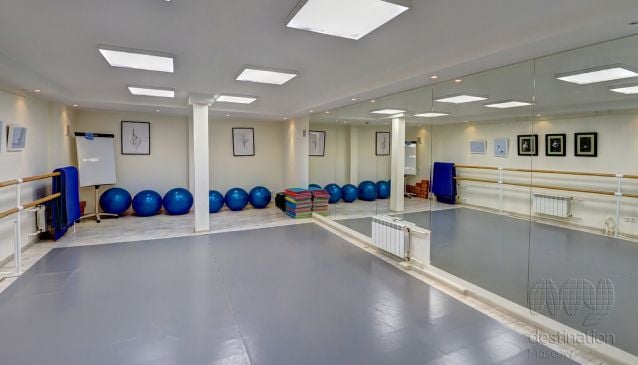
Clover Yoga & Dance Studio
Yoga and Dance Studio "Clover" opened its doors in one of the most beautiful places in the center of Moscow, in December 2014. From its very beginning the studio has beco
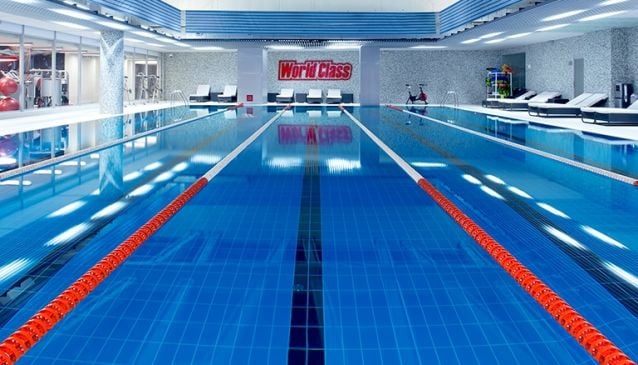
World Class
With World Class you will always find a form of exercise that works for you: everything from energetic and effective classes to calm and harmonic relaxation. Discover how

Orange Fitness
Orange Fitness is a leading European and Russian fitness operator with 34 opened clubs, fitness school, and modern technologies of providing premium services. Large poo

X-Fit is a chain of more than 50 modern, highly-equipped and comfortable fitness centers of premium and business class spread all over the country. One of the basic rul
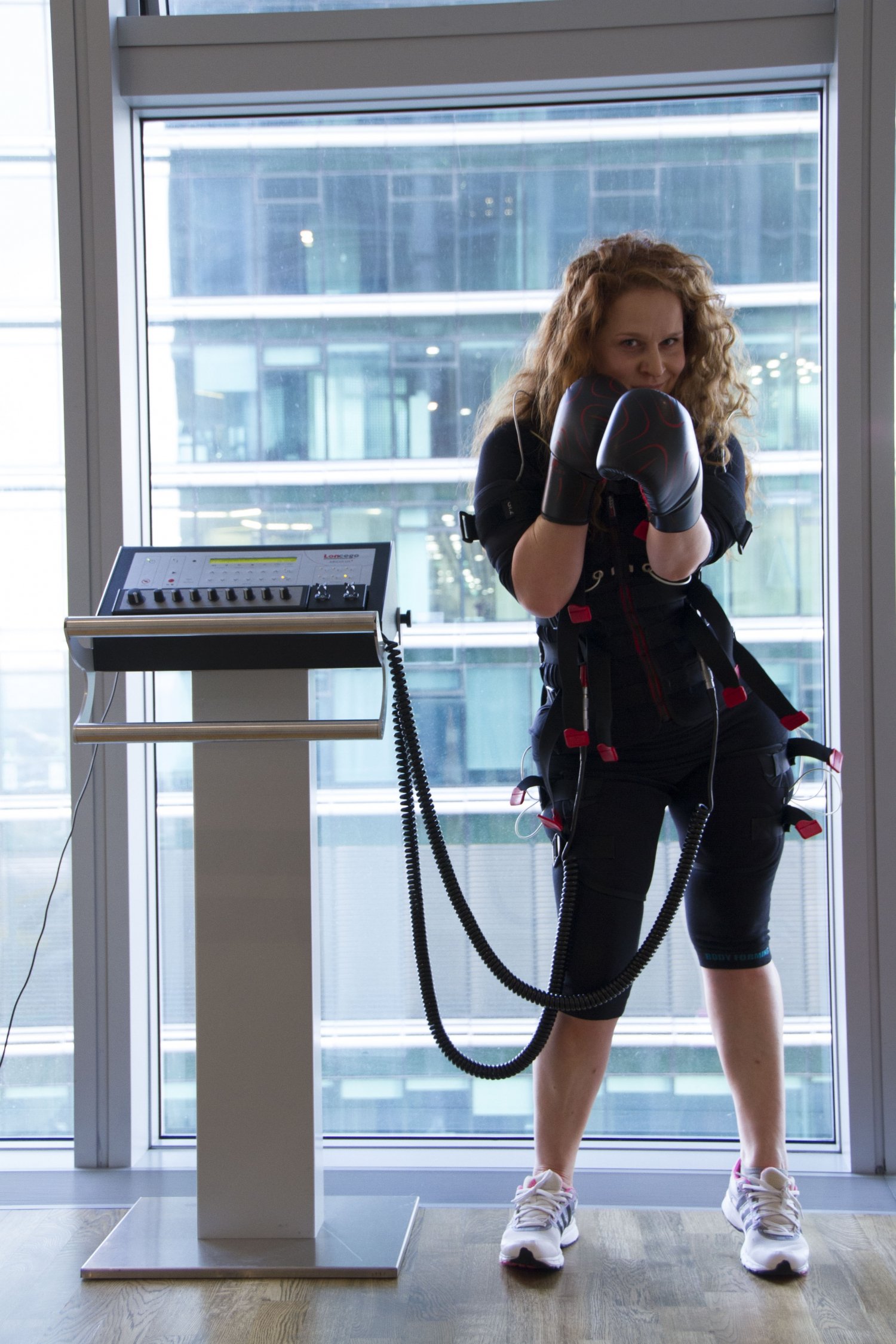
BODY FORMING
The EMS-centers “BODY FORMING” have been created for the purpose of health improvement and body modelling. Today “Body Forming” presents a chain of centers in Mos
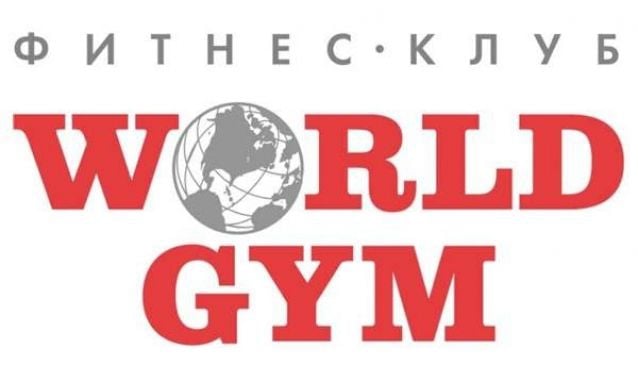
The international chain of fitness centers World Gym takes a special place among leaders of fitness industry in the USA and all over the world. For over 40 years of histo
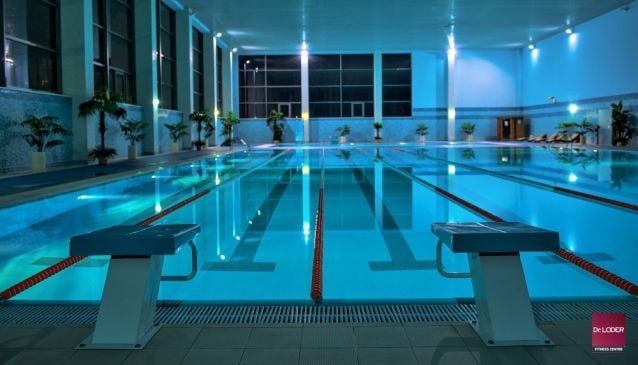
For more than 14 years Dr.LODER has been providing premium services at fitness market counting over 15 000 clients in Moscow. The history of this fitness center dates b

Planeta Fitness
Planeta Fitness was founded in 1997 in Moscow and gained much popularity in Russia opening its centers in Saint Petersburg, Samara, Kazan and other cities. Planeta is the

Viki Land Family club
No one can argue that Moscow is a booming metropolitan city where people can find the widest range of activities for themselves and their children..........
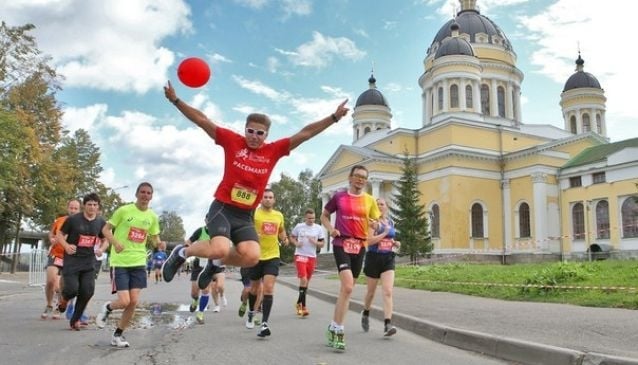
The Golden Ring Run
The Golden Ring Run is a unique project which will take place in the historical cities of the Golden Ring in Russia. The project first started in 2014 in Yaroslavl with t
Create New Guide
Mini guides.
Login to create your guides for Moscow.
Add to My Guide
- Add to New Guide
Recommended Experiences in Moscow

USSR History, Mosaics Arts, Soviet Architecture & Statues
Walk through the Soviet Historical Era of Bishkek of Soviet Kyrgyzstan. Explore Soviet architect Buildings, Statues and Touch the mosaics art which were applied in the decades between the 1960s-1980s.

T-72 Tank Driving Heavy Metal Experience
You'll have the opportunity to drive a T-72 tank under the guidance of a professional instructor who will provide you with expert instruction and safety briefings before you get behind the controls.

T-55 Tank Driving Heavy Metal Experience
You'll have the opportunity to drive a T-55 tank under the guidance of a professional instructor who will provide you with expert instruction and safety briefings before you get behind the controls.
Search, Compare, and Save up to 70%!
Local car rental comparison with my guide, free cancellation.
No need to worry if your plans change with free cancellation options available
24/7 Customer Service
All of our providers offer 24/7 support
500+ trusted car hire partners globally
Create & share your own guide to moscow with friends and family.
Add your recommended places to visit by browsing the website and pressing the icon.
Create your own guide of favourite 'must see' places
Earn your Local Expert badge by Sharing your guides with others
Get your guide seen by submitting it to the Mini Guides section
Must See Places For First Timers
Handpicked by a Local Expert

Places to watch the FIFA World Cup 2018

Best For Kids

We Are Part of the My Guide Network!
My Guide Moscow is part of the global My Guide Network of Online & Mobile travel guides.
We are now in 120+ Destinations and Growing. If you are interested in becoming a local travel partner and would like to find out more then click for more info about our Website Business Opportunity .
Nearby Destinations
- My Guide St Petersburg
- My Guide Warsaw
- My Guide Gdansk
- My Guide Stockholm
- My Guide Krakow
- My Guide Slovakia
- My Guide Budapest
- My Guide Copenhagen
- My Guide Berlin
No results found
- Banya and Sauna
- Beauty Salons
{[{item.label}]}
- {[{data.title}]}
Events in Moscow
Filter Events by Sub-Category
- This Weekend
Please select a Date first.
Gyms and fitness in Moscow, Russia
Find place near you.
Enable localization service to find club in neighborhood.
Welcome to Gym Navigator
The ultimate gym catalog! Dive deep into our comprehensive directory, curated with genuine feedback from our vibrant community of fitness enthusiasts. Beyond mere listings, Gym Navigator boasts cutting-edge Machine Learning analysis that offers insightful evaluations on amenities and classes.
Whether you're a seasoned athlete or just embarking on your fitness journey, our platform ensures you find the perfect gym that aligns with your goals and preferences—right in your vicinity. Let us help you discover the best gym near you.
Join us in exploring the world of fitness, leveraging real user insights and innovative technology to make your choice clear and informed.
Here is a list of distinguished gyms and fitness Moscow, Russia . See all the gyms in your area, click on the region you are looking for:
Find a gym in the neighborhood
What are the moscow gyms y.
If you are looking for a gym in Moscow y , you are spoilt for choice. On gym pages you can find map, photos, newses and information about amenities marked by community. These data can help you choose the best gym for you. 3 top rated gyms y in Moscow we feature on Gym Navigator are:
What are the Moscow gyms near me?
With over 202 gyms within 5 miles of Moscow , you are never too far from a gym near you in Moscow . To see which gym in Moscow is nearest to you visit our Moscow gym page and enter your address in search form above map.
What the gyms in Moscow with the best facilities?
The most people are searching a gym the nearest to their home or work. At Gym Navigator we have over 300 of all gyms in Russia . If you are looking for a gym with a specific facilities here are popular categories:
Popular classes available in Moscow, Russia - reach your fitness goals.
Gyms and fitness.
If you're looking for a gym, fitness club or yoga studio, you've come to the right place.
You can find information about gyms in your area. Browse catalog of gyms and find gyms with classes which are you looking for.
On gym page you can find simple information like address, phone or website. You can find list of available classes. You can check availability of personal training or small group classes. On place page you can also see information about open hours.
You can find gyms near you with amenities, courts, studios and equipments.
Use our map to find gym at your city or district.
In Gym Navigator you can find list of exercises with movies for many body parts.
You can browse exercises catalog and find exercises the best of you.
You can also find exercises grouped into workout plans, which you can use to improve you body. Each routine show you exercises one by one and give you possibility to count you progress and count down rest time.
THE 10 BEST Moscow Health/Fitness Clubs & Gyms
Health/fitness clubs & gyms in moscow.
- Health/Fitness Clubs & Gyms
- Yoga & Pilates
- Hammams & Turkish Baths
- Roman Baths
- Thermal Spas
- Hair & Nail Salons
- 5.0 of 5 bubbles
- 4.0 of 5 bubbles & up
- 3.0 of 5 bubbles & up
- District Central (TsAO)
- 3rd Transport Ring (TTK)
- Garden Ring
- District Northern (SAO)
- Good for a Rainy Day
- Good for Kids
- Budget-friendly
- Good for Adrenaline Seekers
- Good for Couples
- Good for Big Groups
- Adventurous
- Hidden Gems
- Honeymoon spot
- Things to do ranked using Tripadvisor data including reviews, ratings, photos, and popularity.

1. ThaiBeautySpa
2. Limestone
3. Royal Thai Pokrovka

4. Lay Back Massage Club

5. Swimming Pool Chaika

6. Wai Thai Michurino
7. Cosmos Spa
8. Fitness Club Miltronic

9. Pride Club Fitness

10. Usadba Bannaya

11. Spa Algotherm

12. Grand Fitness

13. Galotsentr Solyanaya Peshhera

14. VITASPORT Wellness Club

15. Usadba Bannaya

16. I N T U ' T I O N 2/05
17. city fitness.

18. Novorizhskiye Baths

19. Vital Practice University

20. Fresh Stretching
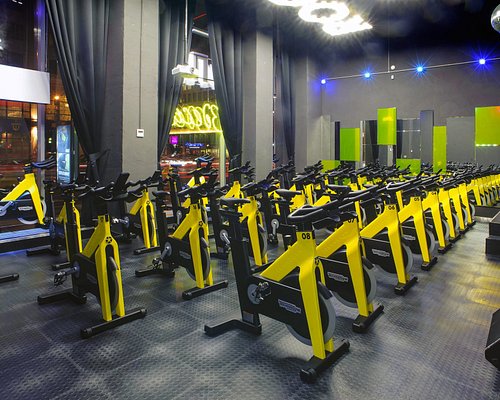
21. Rock The Cycle
22. Massage and Health Center Il de Provane

23. Encore City

24. Fitness Center Mark Avreliy

25. LifeCity Venecia
26. salt cave salegrotte.

27. Boxing Academy

29. Art of Pilates

Calisthenics Daily 17+
Unlimited bodyweight workouts, hal roberts, designed for iphone.
- 5.0 • 4 Ratings
- Offers In-App Purchases
iPhone Screenshots
Description.
Empower your fitness journey with Calisthenics Daily! Access unlimited workouts, track progress, and reach your goals effortlessly. Get started now! Embark on a transformative fitness journey with Calisthenics Daily, the ultimate app for bodyweight training enthusiasts. With an extensive library of unlimited workouts at your fingertips, Calisthenics Daily ensures that no matter your fitness level or schedule, you'll find the perfect routine to help you achieve your goals. Designed by certified personal trainers, our workouts are meticulously crafted to challenge and push you to new heights of strength and endurance. Whether you're a beginner looking to build foundational strength or a seasoned pro seeking to take your fitness to the next level, our diverse range of routines caters to all skill levels and preferences. What sets Calisthenics Daily apart is its accessibility and versatility. Most of our workouts require minimal to no equipment, making it convenient for you to train anytime, anywhere. While some routines may incorporate equipment like a pull-up bar for those seeking a greater challenge, rest assured that our workouts prioritize accessibility and inclusivity. Our commitment to your fitness journey goes beyond just providing workouts. With Calisthenics Daily, you have the power to discover, save, and track your progress through your favorite routines. Whether you're exploring dynamic full-body exercises or targeting specific muscle groups with precision, our intuitive interface makes it easy for you to navigate and personalize your fitness experience. At Calisthenics Daily, we believe that fitness should be empowering and enjoyable. That's why our app is designed to make your fitness journey seamless and rewarding. Join our community of like-minded individuals who are dedicated to unlocking their full potential, one workout at a time. Start your journey with Calisthenics Daily today and unleash the best version of yourself. To view our Terms of Use (EULA) click the following link https://www.apple.com/legal/internet-services/itunes/dev/stdeula/
Ratings and Reviews
Does a great job laying it out. Excited to continue!
App Privacy
The developer, Hal Roberts , indicated that the app’s privacy practices may include handling of data as described below. For more information, see the developer’s privacy policy .
Data Not Linked to You
The following data may be collected but it is not linked to your identity:
- Contact Info
Privacy practices may vary, for example, based on the features you use or your age. Learn More
Information
- App Support
- Privacy Policy
You Might Also Like
uveitisOnCall
Activity Rings+
Samera Health
Net Check In - Ogden Clinic
We're Working Out - Al Kavadlo

StarsInsider
From ancient Greece to modern gyms: A journey through the evolution of physical culture
Posted: February 21, 2024 | Last updated: February 21, 2024
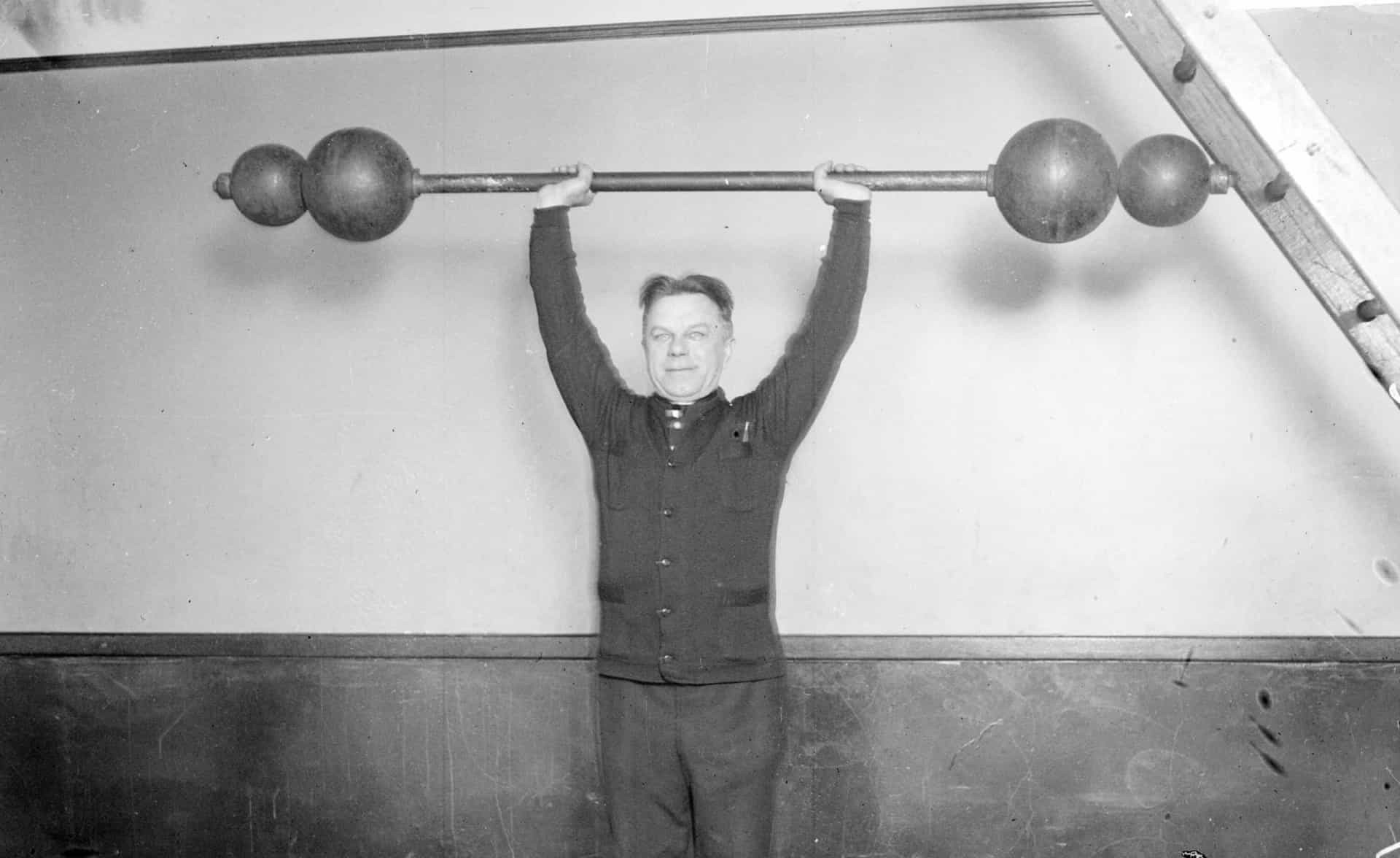
You may also like: 30 facts you probably didn't know about the world
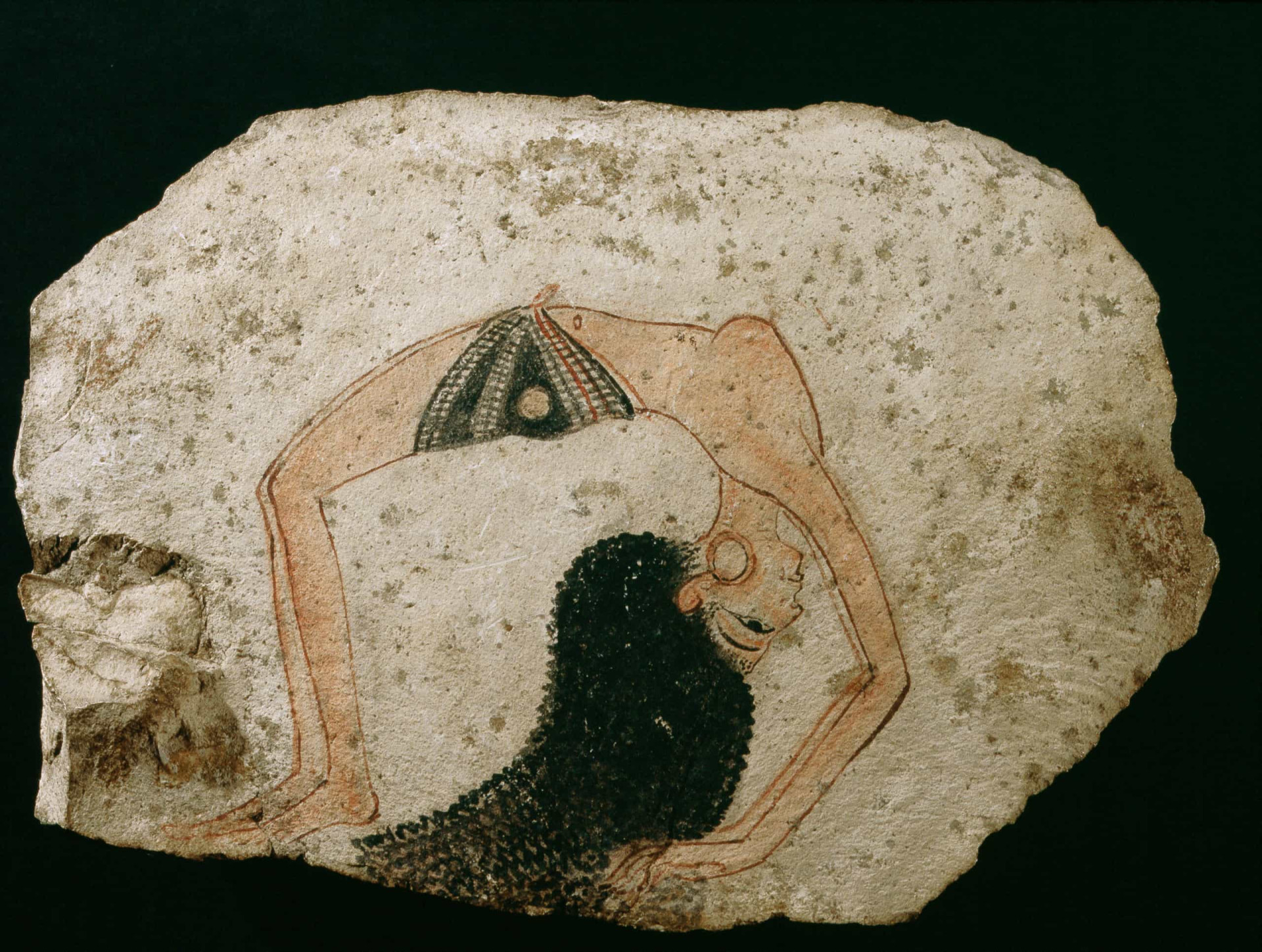
The exact birth of structured exercise remains unknown, however it’s believed that it began with acrobatics in Egypt around 2000 BCE.
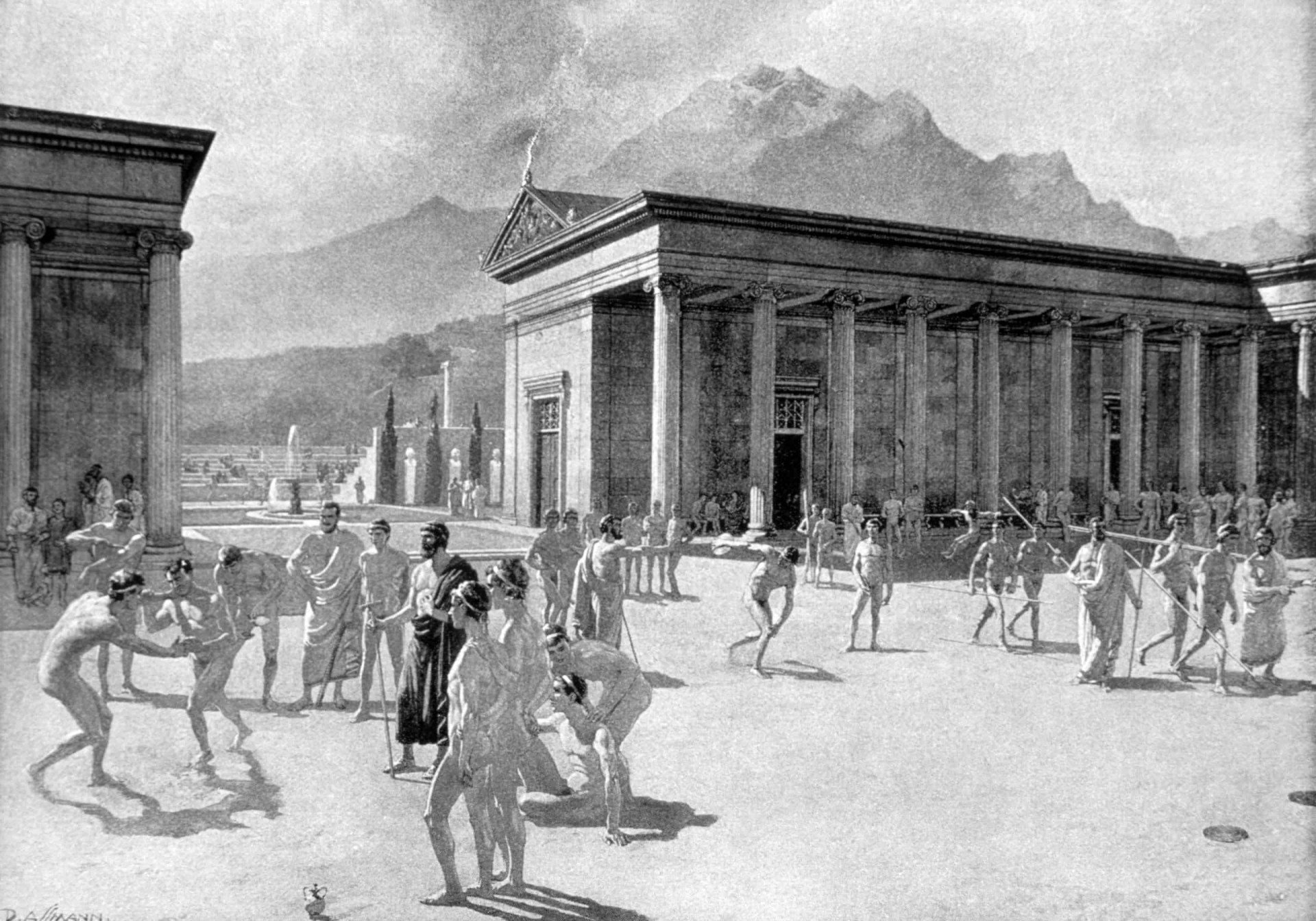
The birth of the gymnasium
Gymnasiums were places where young men exercised in Ancient Greece. The name stuck and was abbreviated to gym in many cultures.
You may also like: These stunning images weren't made with Photoshop

Ancient Greece
Public gymnasiums were also used by athletes to train for events such as the Olympics.

Ancient Rome
While Romans were more into wine, entertainment, and conquering territory, one of them—a poet named Juvenal—came up with one of the most famous mottoes in the history of fitness around 1 CE.
You may also like: The scariest places around the world

Body-mind connection
He coined the Latin phrase Mens sana in corpore sano , usually translated as "a healthy mind in a healthy body".

Working out in a structured way lost its appeal for many years in Europe, but in 1569 an Italian physician named Girolamo Mercuriale published the book ‘De Arte Gymnastica.’
In the book he described various body movements and the use of equipment we now handle in most gyms, including dumbbells.
You may also like: Inside the bizarre The Family cult
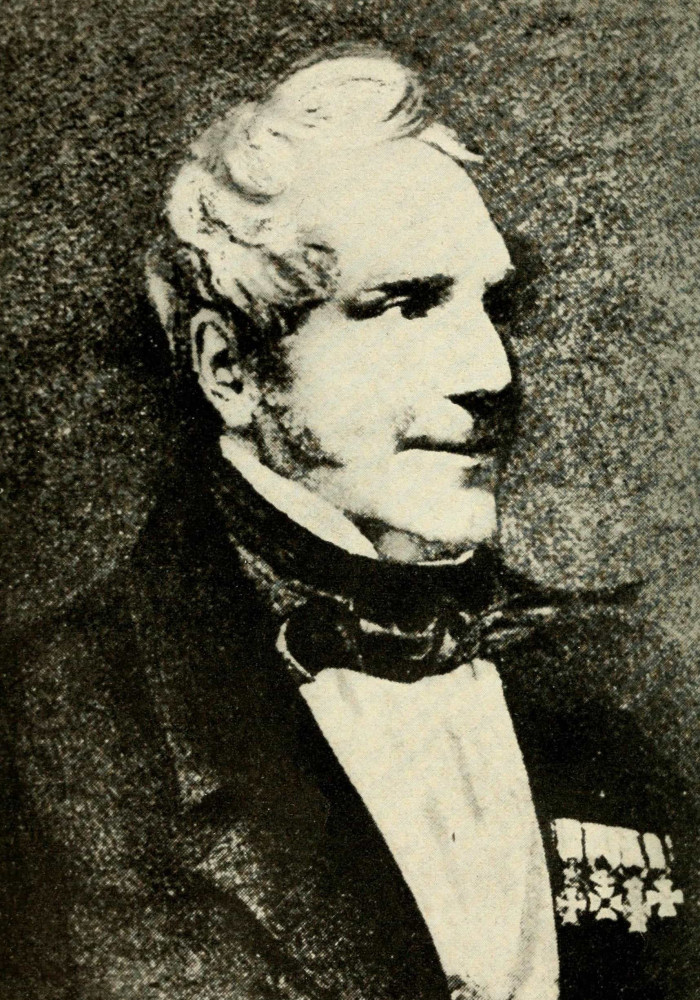
The first private gym
In 1799, Franz Nachtegall established the first private gym in Denmark. Classes consisted of calisthenics and exercises using equipment such as wooden dumbbells.
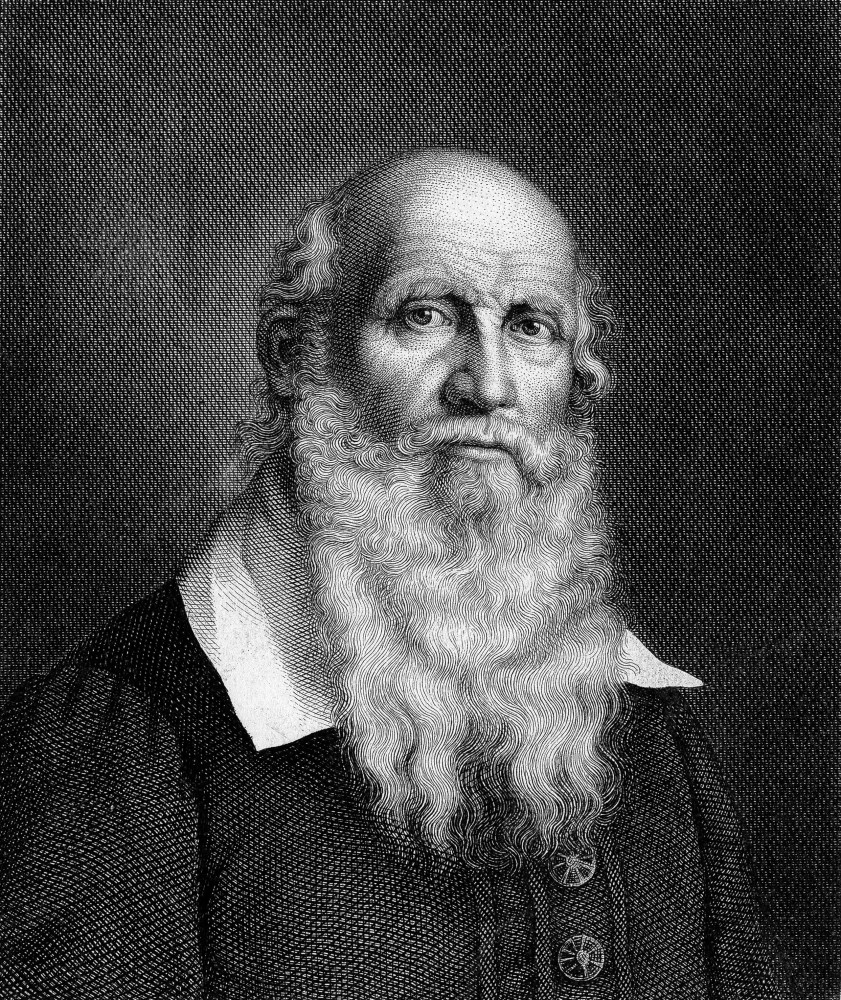
In 1811, Friedrich Ludwig Jahn, also known as the “father of modern gymnastics,” established the first Turnverein, or 'Turn.'
You may also like: Actors who've been victims of the Oscar curse
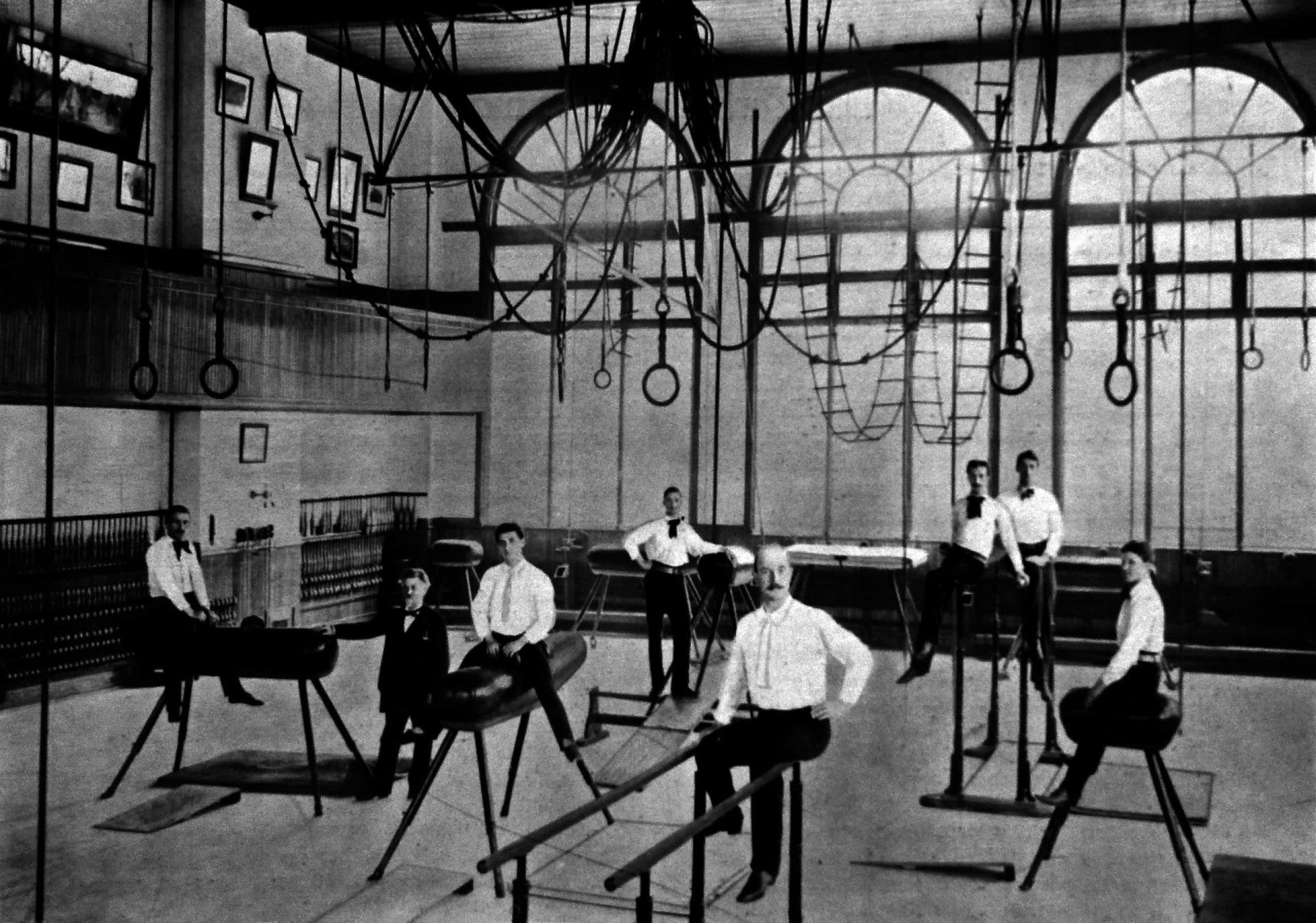
This gymnastic club had various pieces of equipment, including parallel and horizontal bars, pommel horses, and other popular gymnastics equipment. Turns eventually spread across Germany.

Turns went global
It’s estimated that by 1860 over 150 Turnverein had spread across the world, including to the US.
You may also like: Babies who look exactly like celebrities!
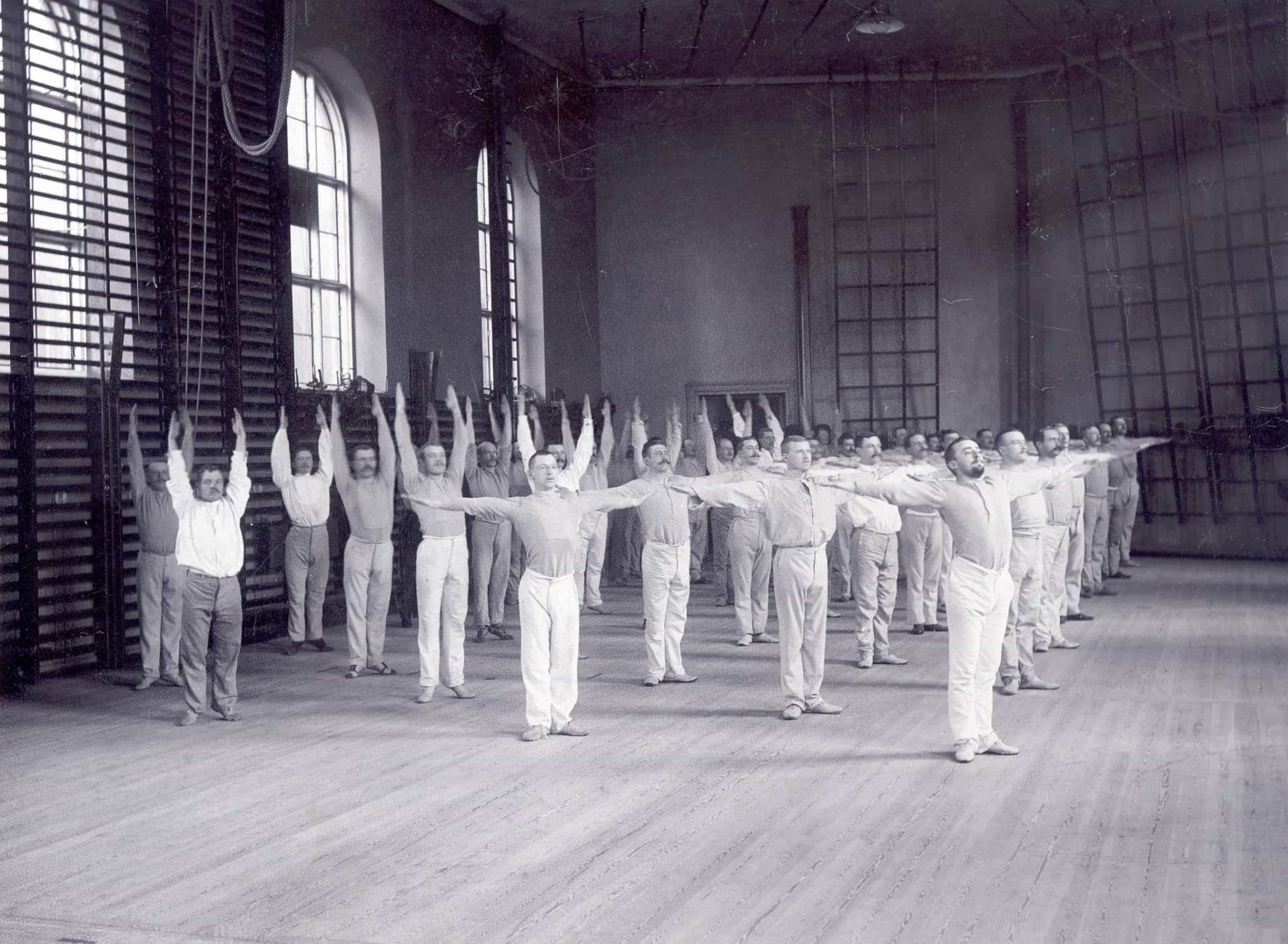
Swedish pedagogic gymnastics
In the early 1800s, Pehr Henrik Ling created a new gymnastics system, which was eventually adopted by Swedish troops.
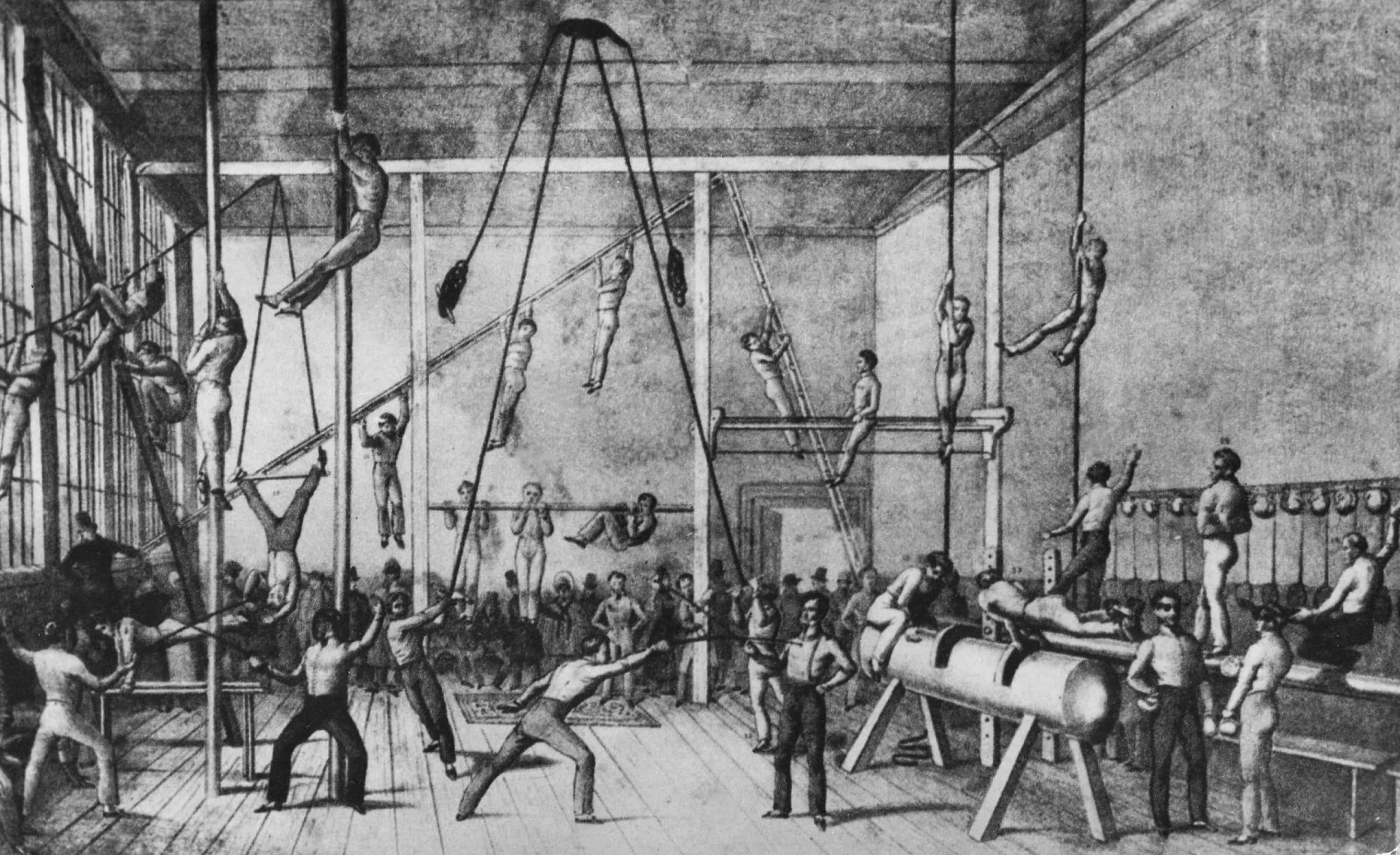
Gymnase Triat
This is believed to have been the first membership-driven gym. It was first established in 1848 in Brussels, Belgium and then relocated to Paris, France.
You may also like: Incredible hidden attractions in US cities
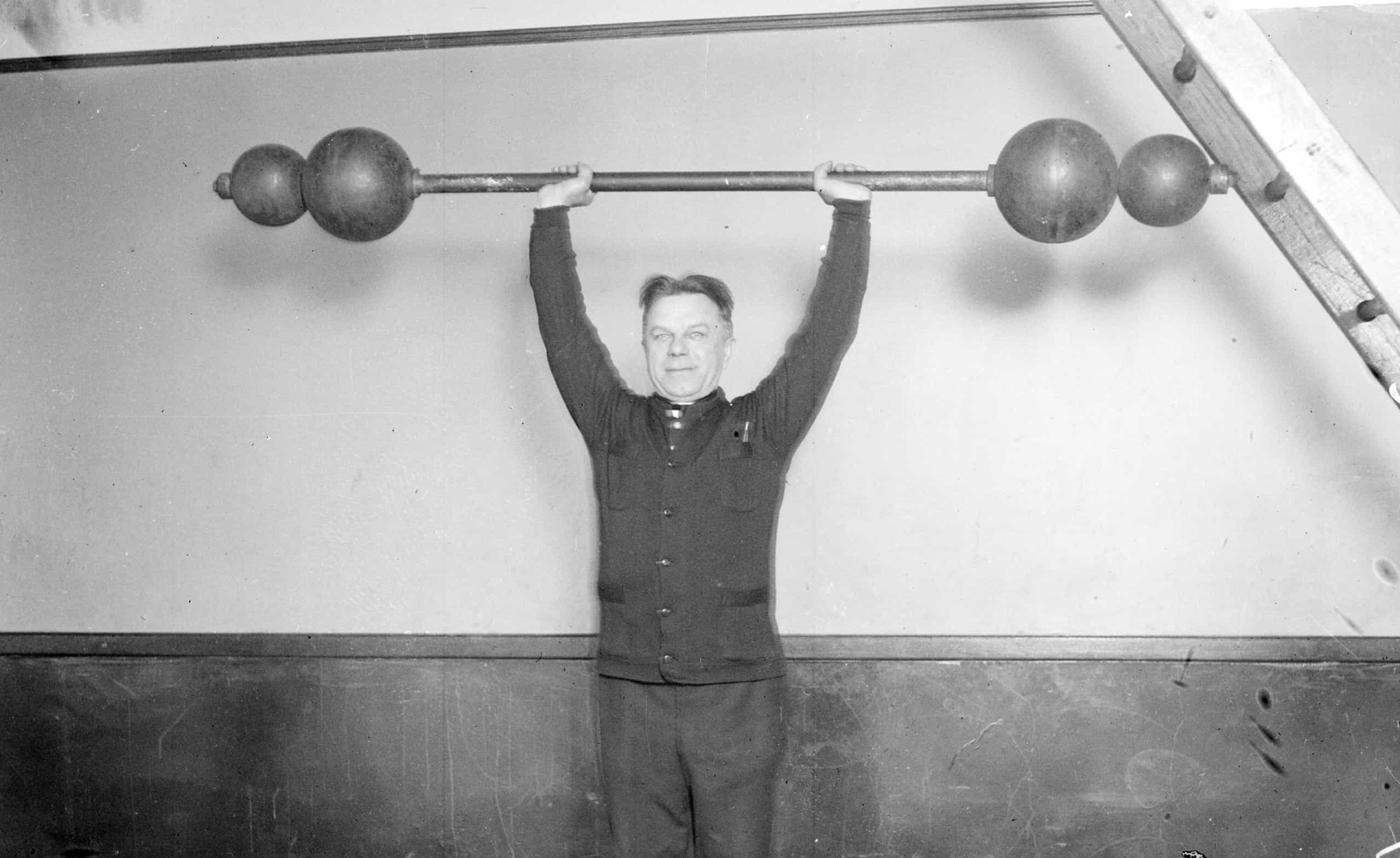
Among gym equipment such as ropes, pommel horses, and dumbbells, the club also offered barbells called Bares A spheres De 6 Kilos . These are believed to be the first barbells made available to the public.

The Young Men's Christian Association (as it was called in the beginning) has been promoting athleticism since it was founded in 1844 by Sir George Williams in London, England.
You may also like: Banned baby names in Australia
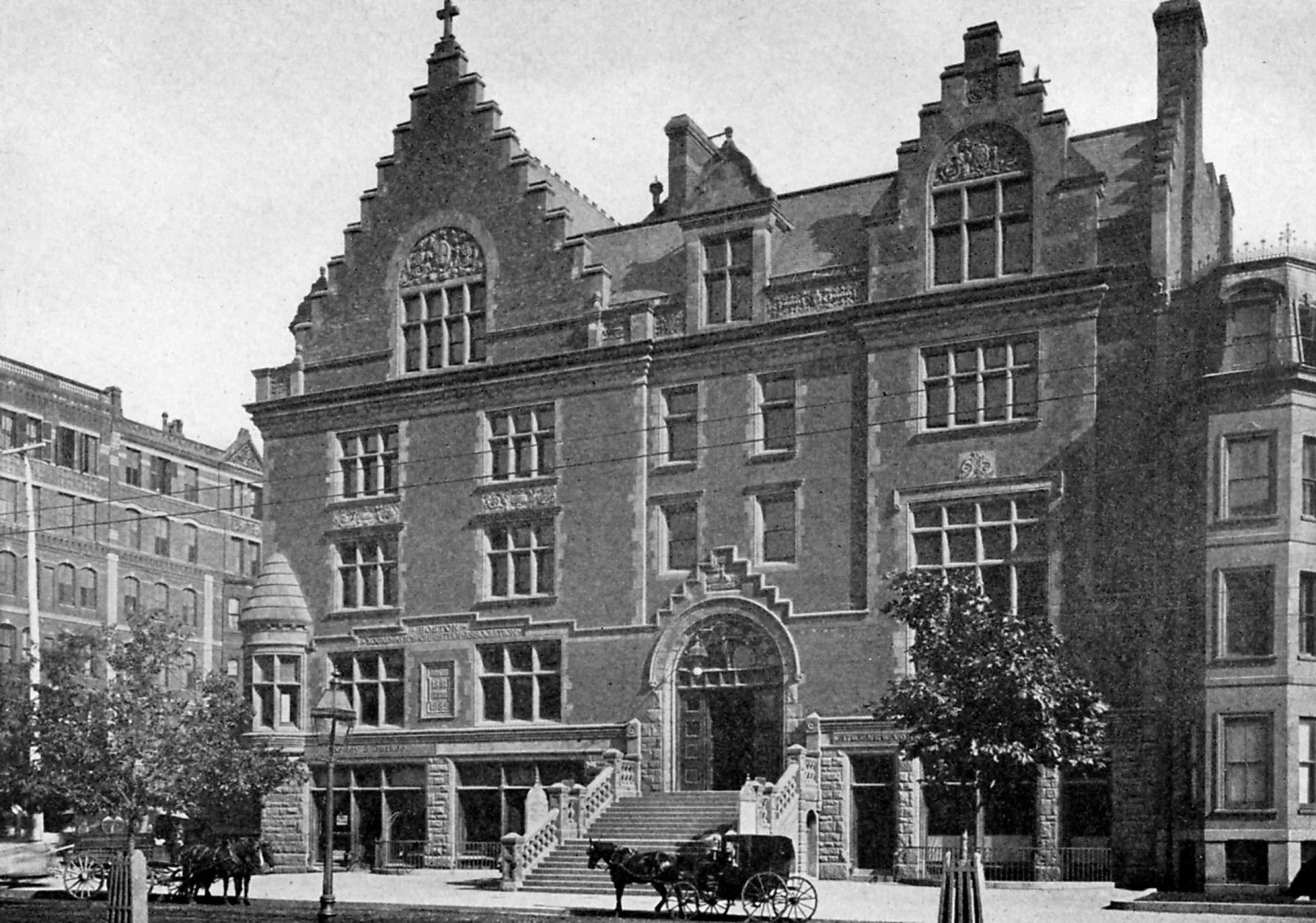
The first YMCA in the US (1850)
The Boston YMCA was the first fitness gym in the US. In addition to a fully-equipped gym, it also featured an area for combat sports.
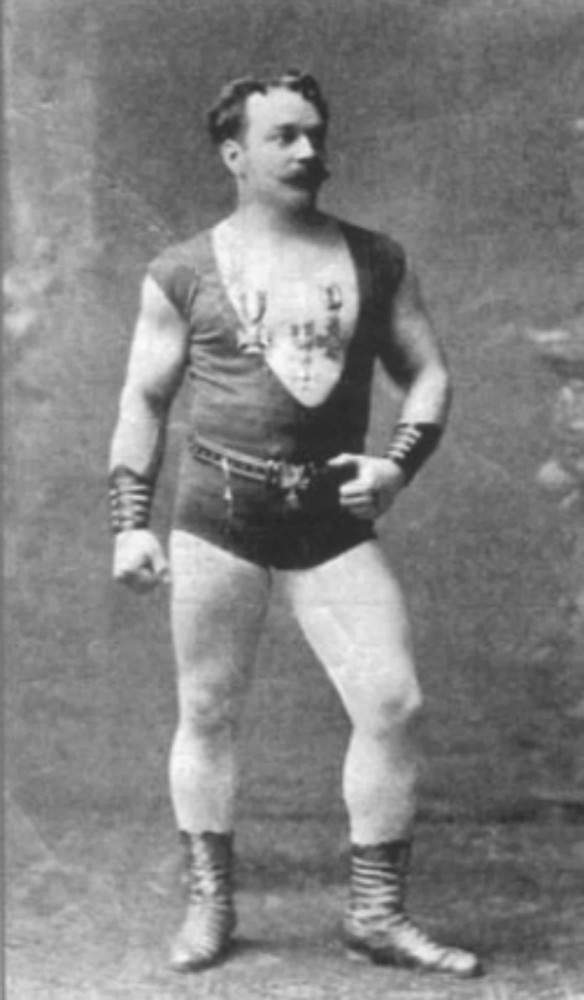
The first personal training gyms
Ludwig Durlacher, also known as Professor Attila, was a strongman dubbed as the first personal trainer. Attila opened the first personal gyms in Europe and the US.
You may also like: Hearts of gold: the most generous and charitable celebs
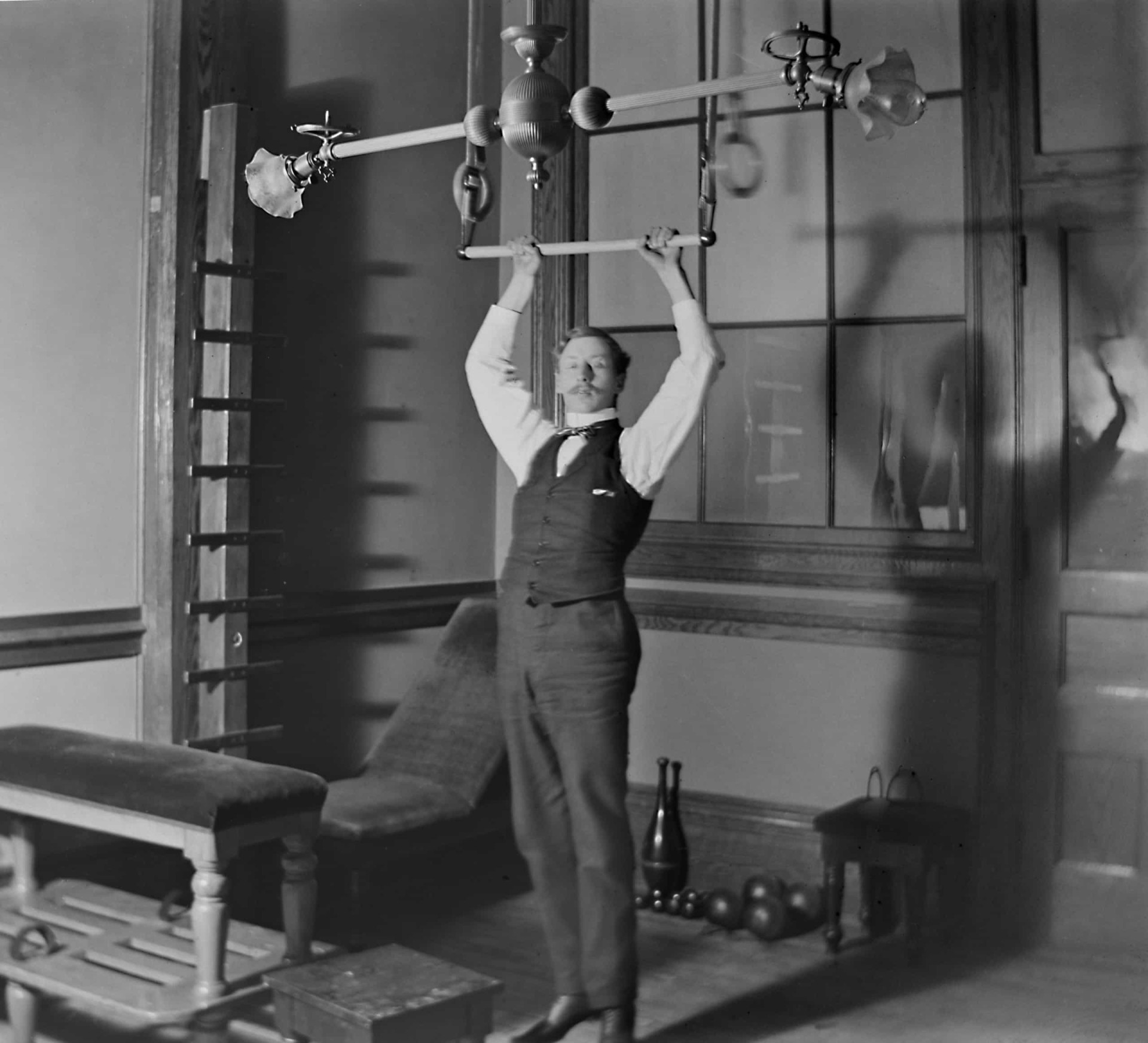
He opened his first gym in Brussels in the 1880s, then one in London, and finally, in 1894, he opened Attila’s Athletic Studio and School of Physical Culture in New York.
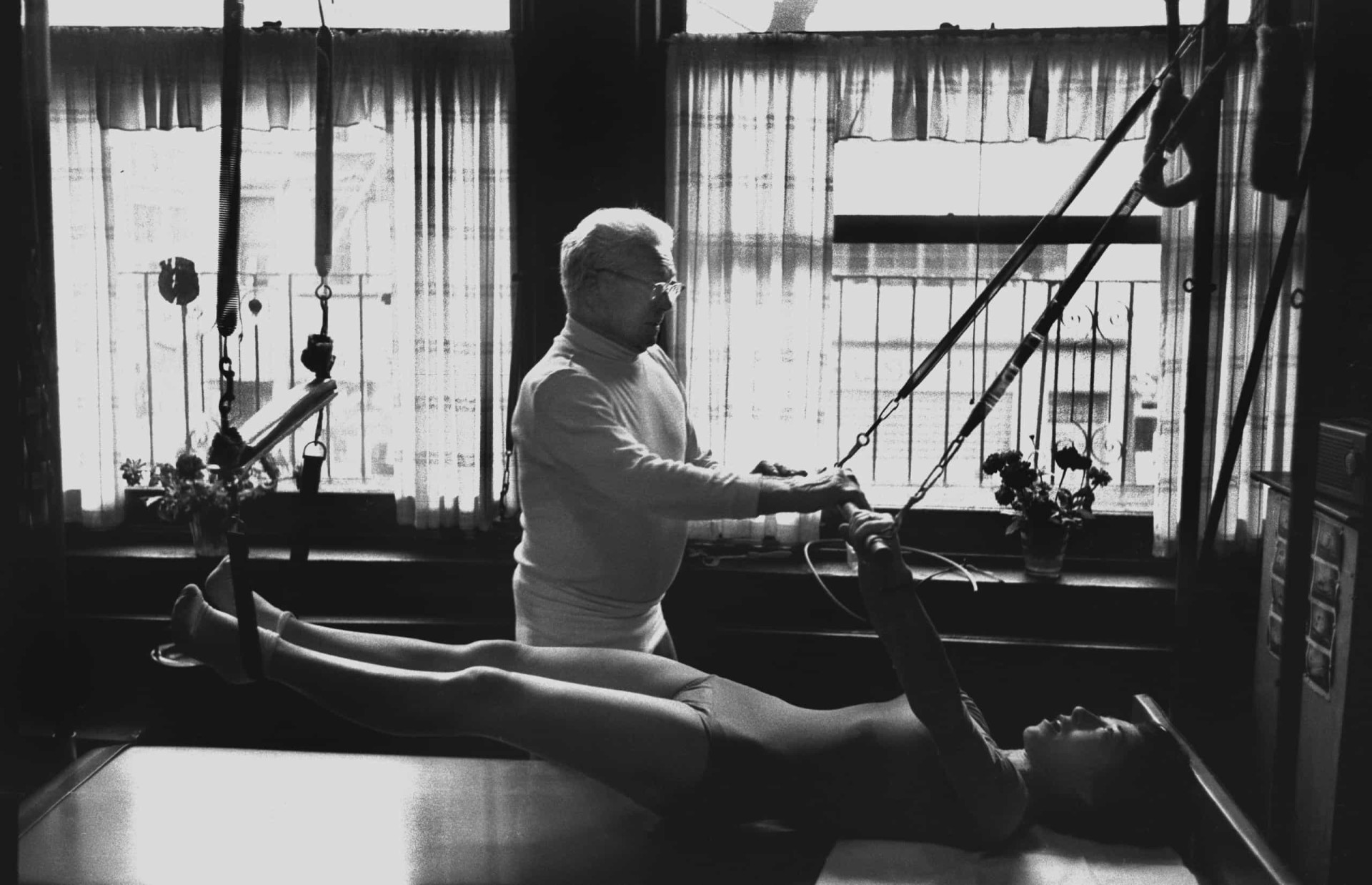
The first pilates studio
Joseph Pilates opened his first Contrology (as the method was known back then) studio in 1926, also in New York.
You may also like: American foods that are banned around the world
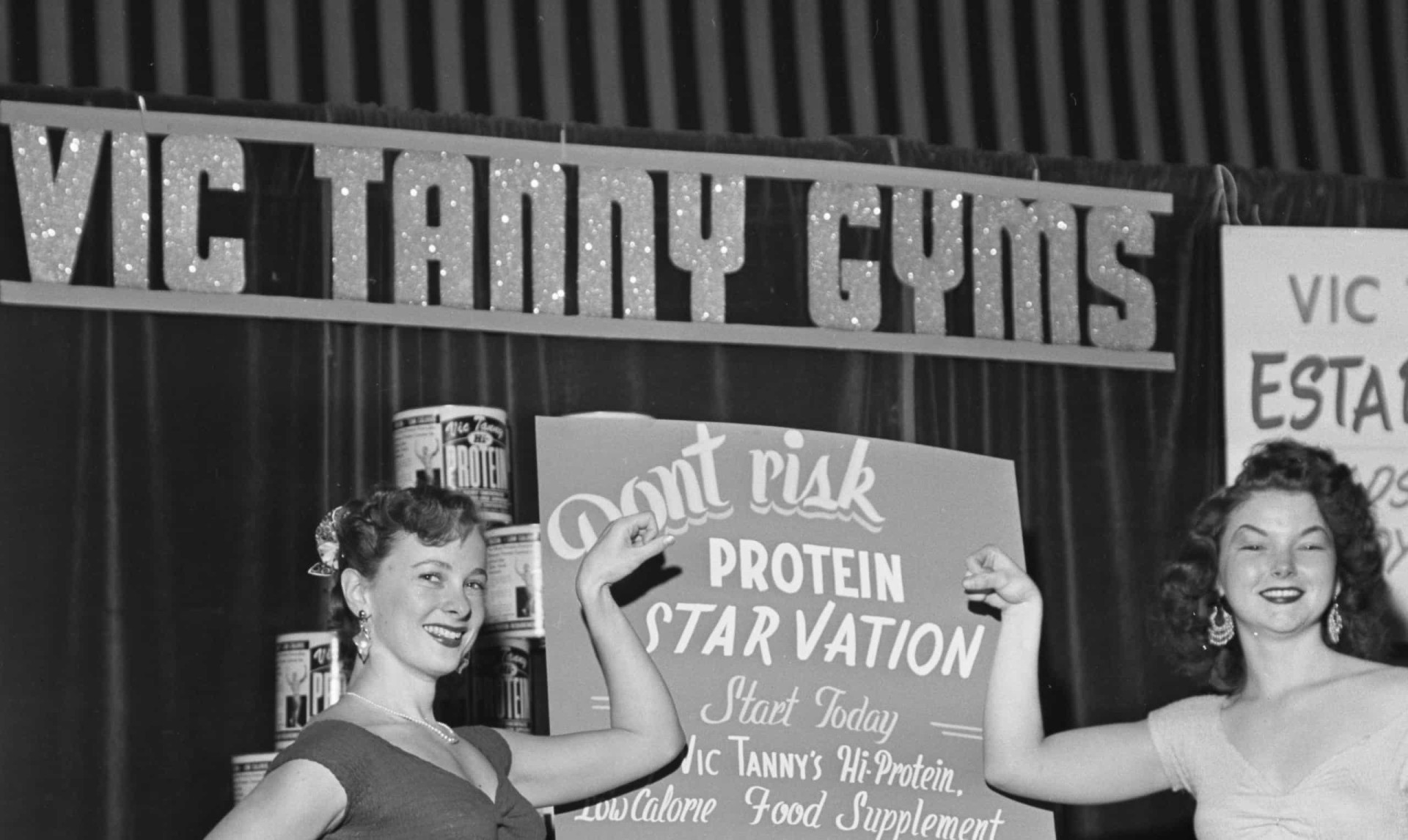
The first health club
In 1947, the first Vic Tanny Health Club opened, offering a new concept that catered to both men and women. Vic Tanny eventually expanded the business to over 100 clubs.
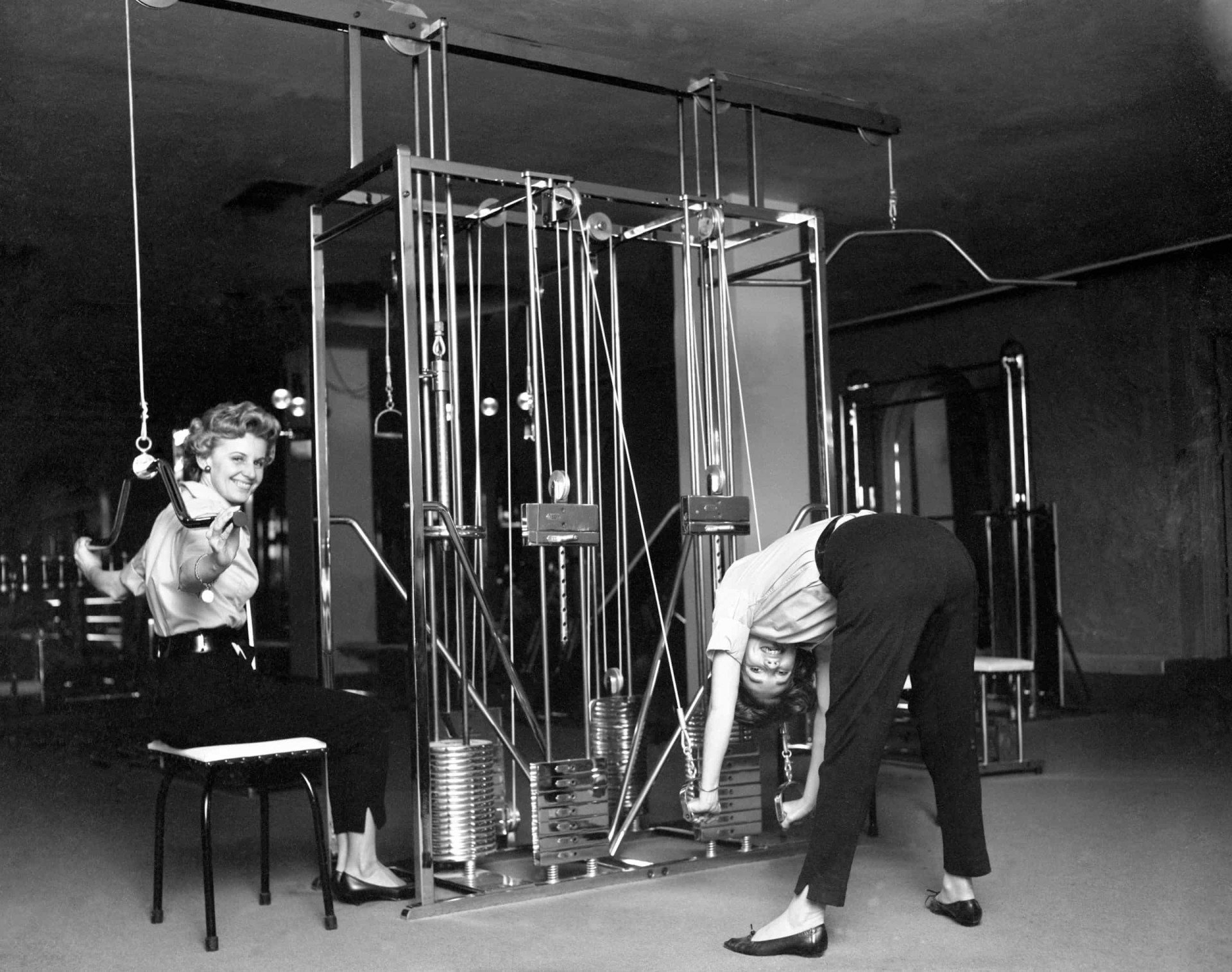
First women-only club chain
In 1969, Lucille Roberts opened the first chain of women-only health clubs. The clubs offered group classes and even 'babysitting' services.
You may also like: Take flight for a brief history of aviation
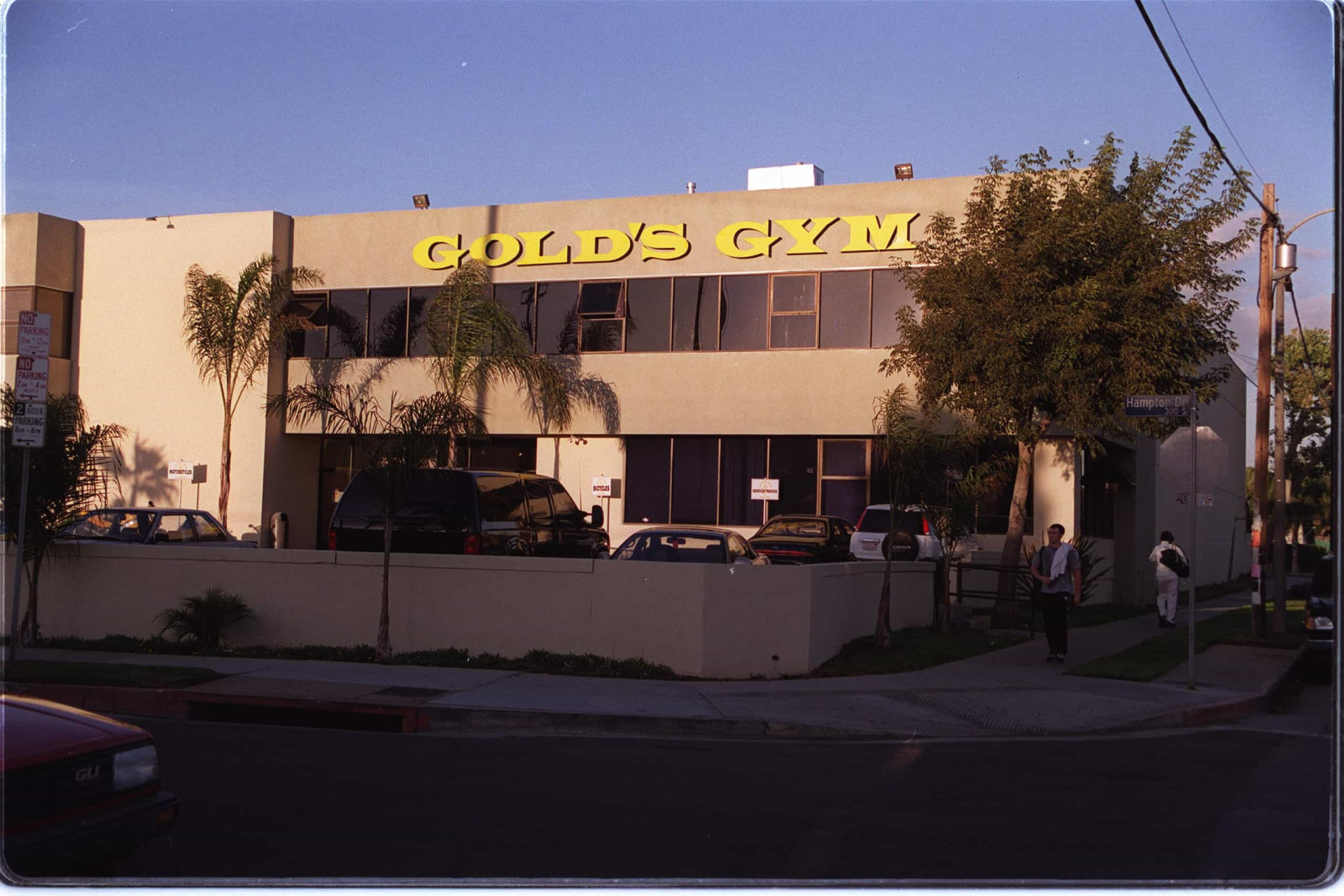
In 1965, Joe Gold opened the first Gold’s Gym in Venice, California. The brand grew massively and became a household name in bodybuilding and fitness in general.
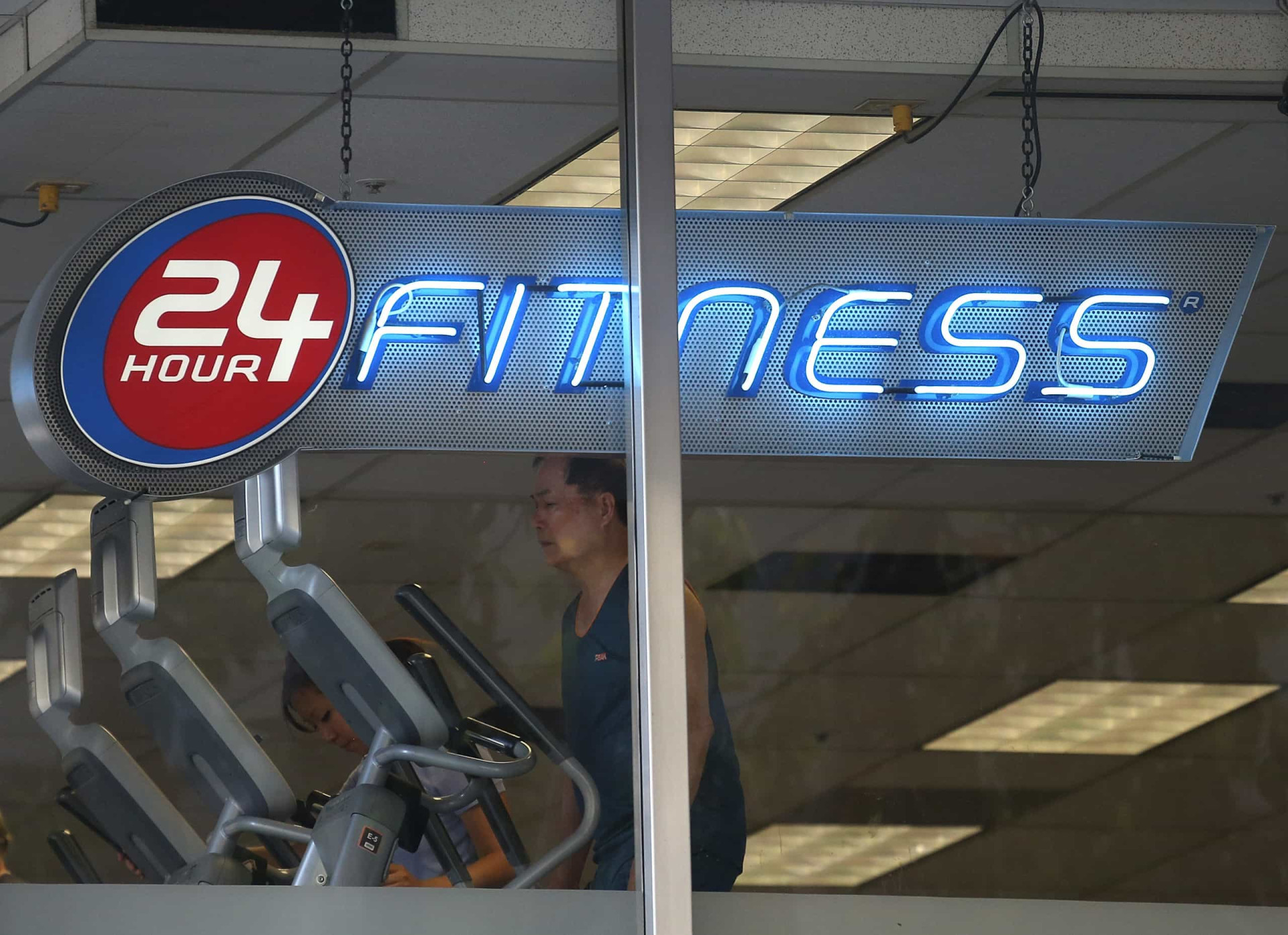
The first 24/7 gym chain
Mark Mastrov opened 24 Hour Fitness in 1983. The pioneers of the innovative concept are currently the second-largest fitness chain in the US, based on revenue.
You may also like: Celebrity habits: The good, the bad, and the downright weird
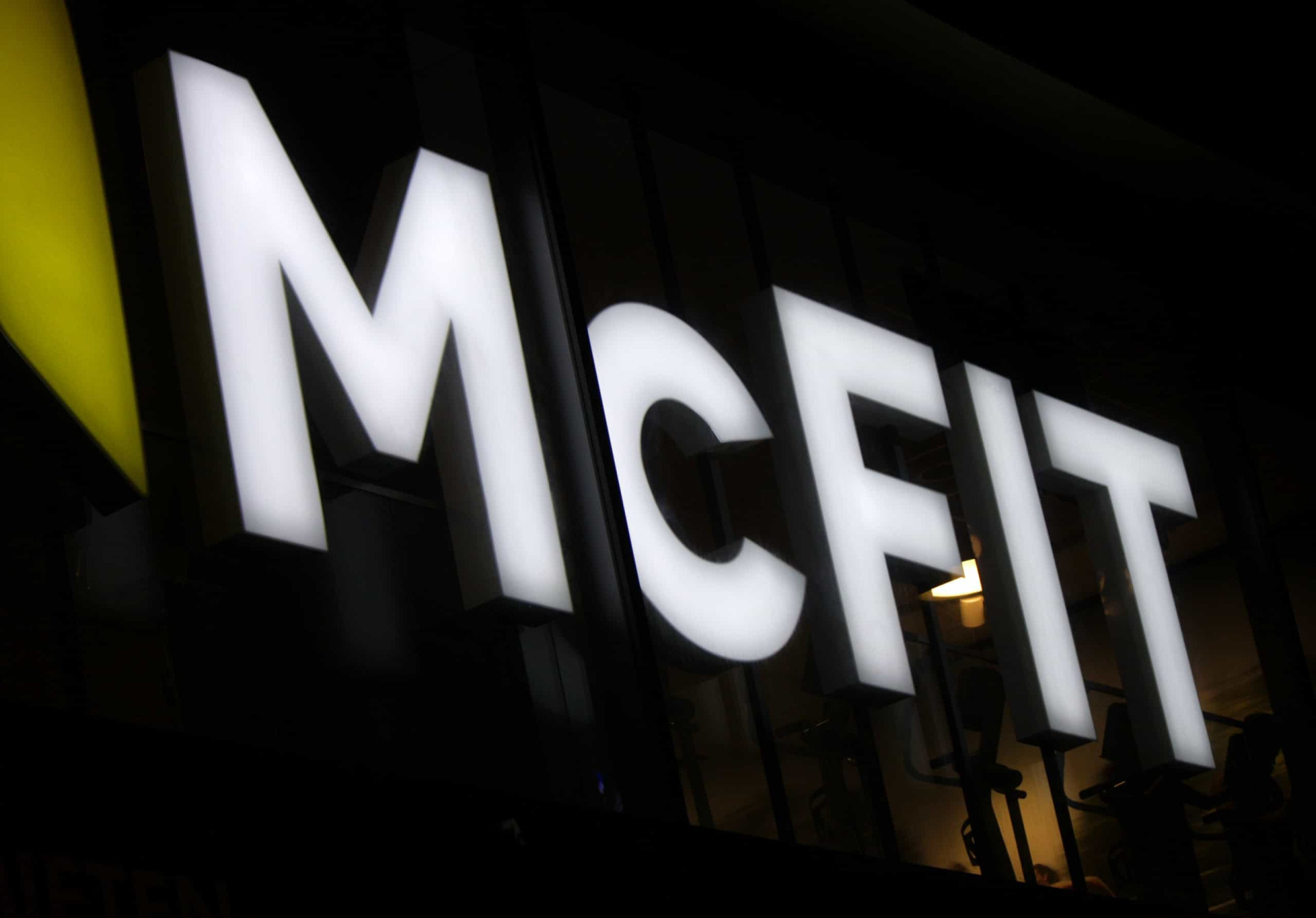
The first low-cost gym
Rainer Schaller founded McFit in 1997, in Germany. The revolutionary model was rapidly adopted by others in the industry and remains popular to this day.
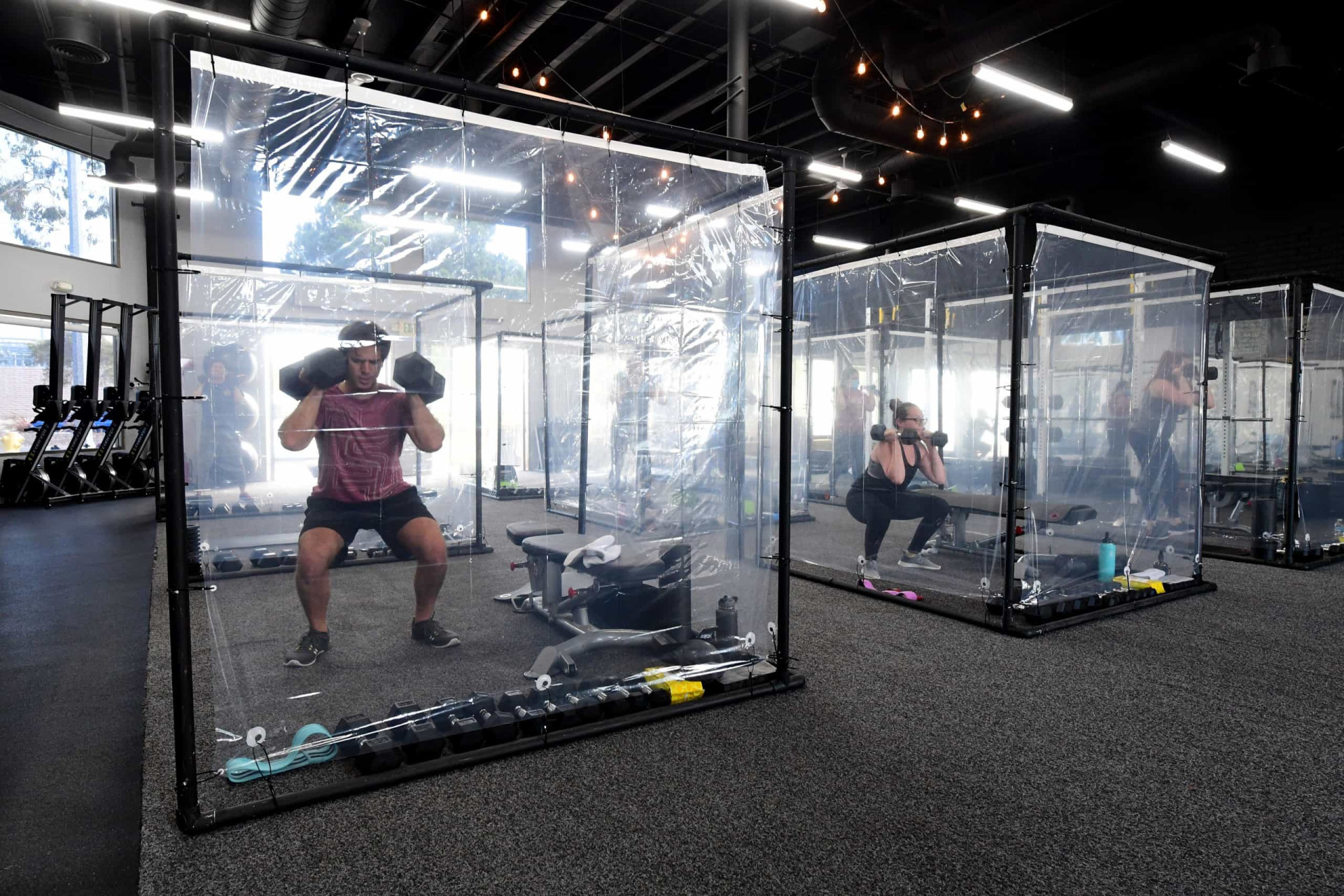
Modern gyms
After the boom of gym culture was taken over by health clubs, in recent years we’ve seen a renascence of traditional training methods and the introduction of new ones.
You may also like: Scenic train journeys to take during winter
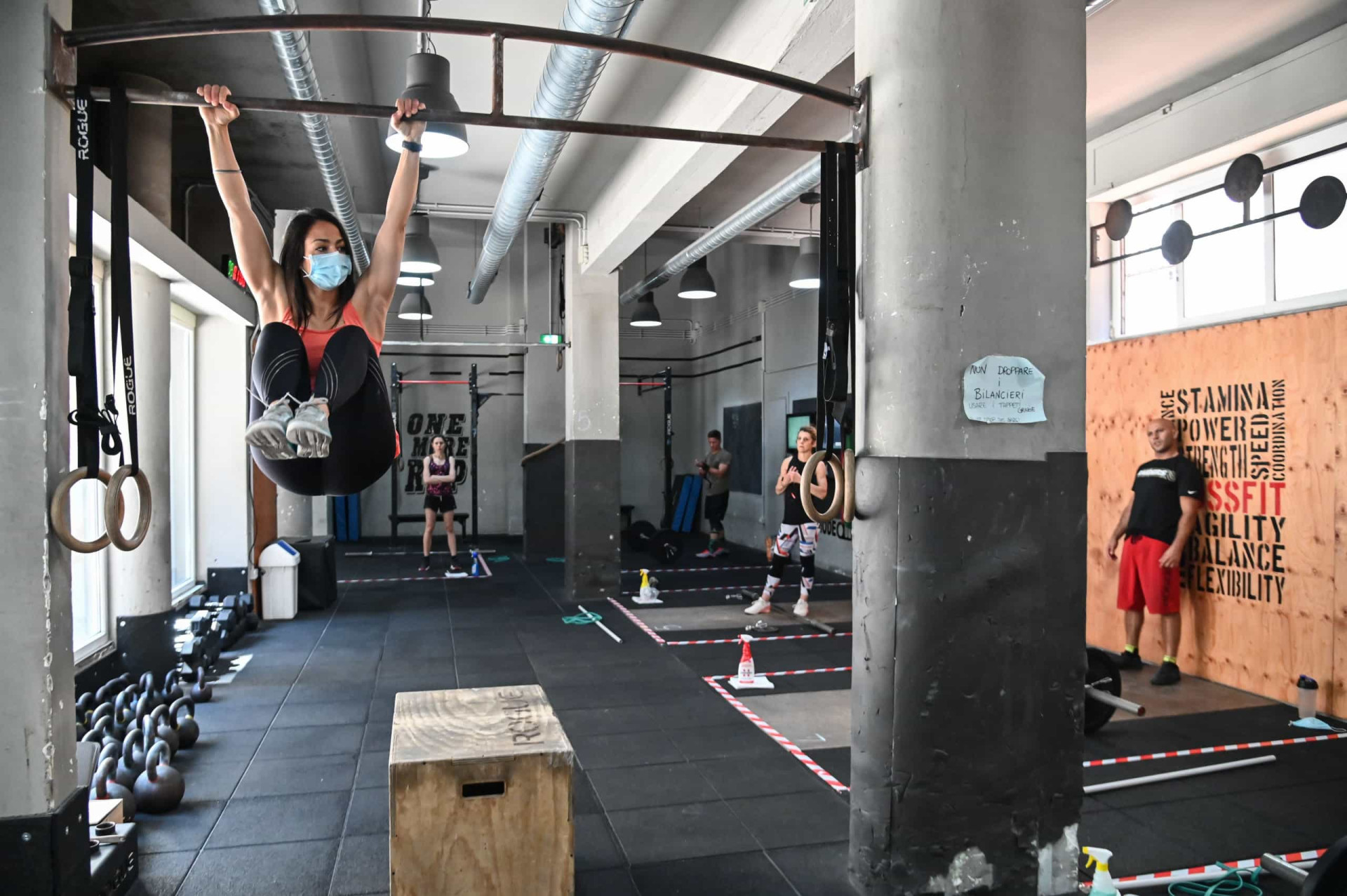
Cross training gyms
One example includes CrossFit. Since the turn of the century, gyms (or boxes, as they’re known in CrossFit) have been popping all over the world.
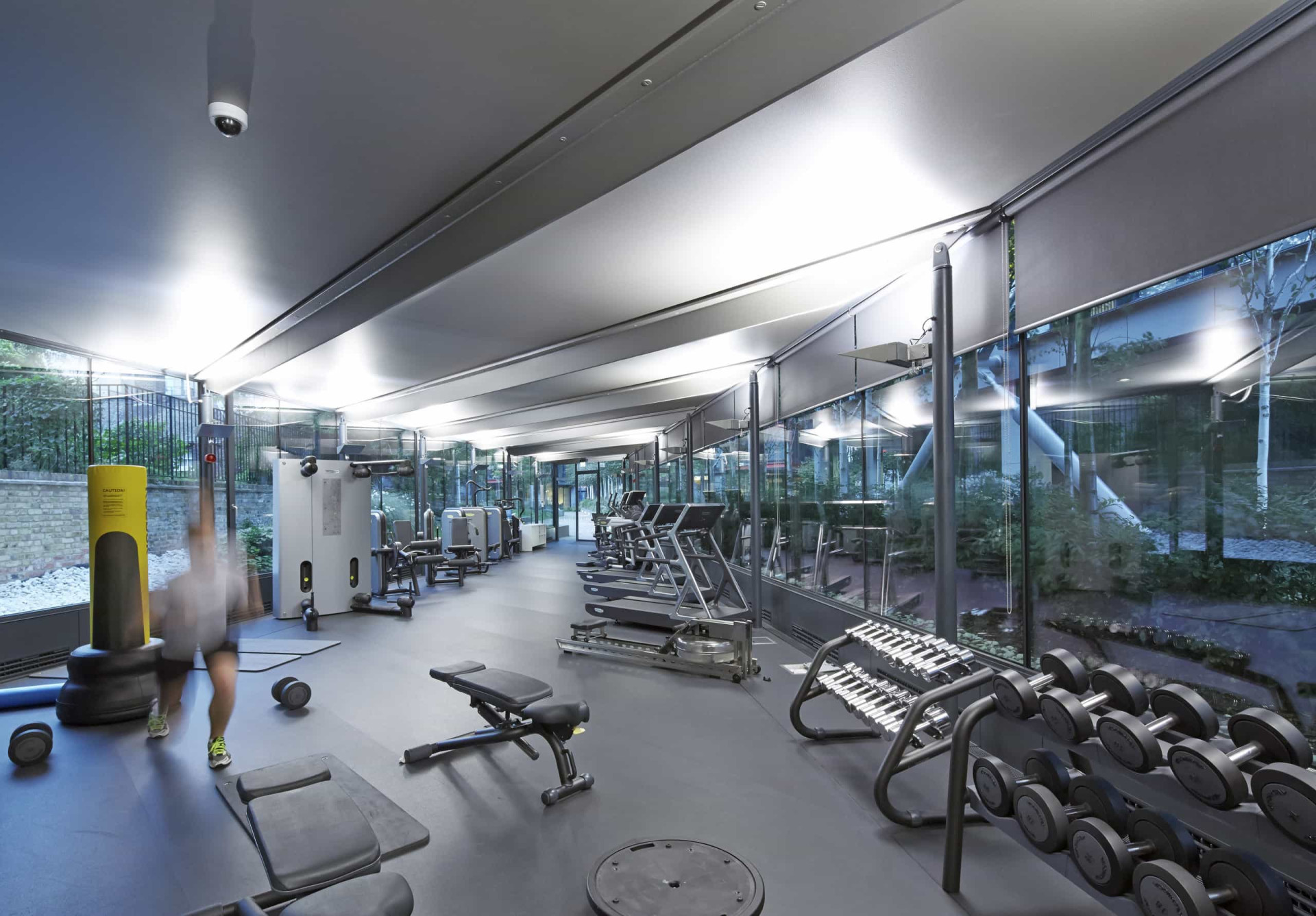
21st-century gyms
While niche spaces continue to exist, many modern gyms mix a wide range of disciplines. Members can lift weights, run on a treadmill, or do martial arts, among many other things.
Sources: (The University of New Mexico) (Les Mills) (ClubReady)
You may also like: Films that inspired real-life crimes
More for You
Donald Trump Makes Bold Claim About Iranian Attack on Israel
Ryan Gosling, 'SNL' Cast Barely Keep It Together In 'Beavis And Butt-Head' Sketch
Former undercover agent recalls infiltrating the Hells Angels: 'A dangerous game to play'
Childhood Chills: 15 Scary Movies That Haunted Viewers for a Lifetime
Famous figures who had Titanic tickets but didn't make it on board
Helicopters race to rescue over 170 people trapped in cable car
Tiger Woods makes absolute mess of Masters hole, takes “worst cart ride” in golf
Ryan Gosling and Kate McKinnon's ‘Close Encounter' Sketch Sends ‘SNL' Cold Open Into Hysterics
King and Queen ‘utterly shocked and horrified’ by ‘senseless attack’ in Sydney
Bread Recalled After Threat-to-Life Warning Issued
I tutor the children of some of Dubai's richest people. One of them paid me $3,000 to do his homework.
Common over-the-counter medicine linked to increased dementia risk
7 CDs You Probably Owned, Threw Out and Now Are Worth Bank
US Marines China war training on secluded island 'ridiculous' and will 'backfire'
The best way to answer 'tell me about yourself,' says CEO who's done over 30,000 interviews
They Wrote it Off as School Stress. I Hid the Truth Out of Terror
Famous Roles That 16 Actors Never Want to Play Again
Woman with rare syndrome left allergic to ‘everything’ except just four foods
A key part of our bodies continues to live on years after we die
How Biden's new student-loan forgiveness plan could be jeopardized before it even goes into effect
until December 14, 2025
Novotel Moscow City Hotel
- Photographs of the hotel 49
- Guests' photos 21

What was good
location is very nice
What was bad
the breakfast staff in the restaurant non friendly at all specially the egg section is so rude
Main amenities of the hotel
- Free Internet
- Fitness centre
- Bar or restaurant
- Moscow City • 160 m
- Delovoy Tsentr (Bolshaya Koltsevaya) • 170 m
- Delovoy Tsentr (Solncevskaya) • 210 m
- Mezhdunarodnaya • 240 m
- Museum-panorama The Battle of Borodino • 1.3 km
Available rooms
Enter your dates of travel and we will display the current prices
No dates selected
If you don't know the specific dates yet, select approximate dates to see the price estimates.
Presnensky District, Presnenskaya Naberezhnaya, 2, Moscow
- What's nearby
- Places of interest
- Pushkin Museum • 4.3 km
- Gorky Park • 4.6 km
- Moscow Kremlin • 4.7 km
- MSU Main Building • 5.0 km
- Red Square • 5.3 km
- State Tretyakov Gallery • 5.3 km
- Bolshoi Theatre • 5.3 km
- Saint Basil's Cathedral • 5.5 km
- ZIL Culture Center • 8.5 km
- VDNKh • 11.0 km
- Sheremetyevo International Airport • 25.5 km
- Moscow Domodedovo Airport • 43.6 km
- Zhukovsky International Airport • 43.0 km
- Vnukovo Airport • 22.3 km
- Train stations
- Kiyevsky Railway Station • 1.9 km
- Aeroexpress Vnukovo • 1.9 km
Description of the hotel
Good choice if you’re looking forward to taking some rest at the hotel as much as to walking around the city. Hotel «Novotel Moscow City Hotel» is located in Moscow. This hotel is located in 5 km from the city center. You can take a walk and explore the neighbourhood area of the hotel — Moscow City, Delovoy Tsentr (Bolshaya Koltsevaya) and Museum-panorama The Battle of Borodino.
At the hotel
Spend an evening in a nice atmosphere of the bar. You can stop by the restaurant. Free Wi-Fi is available on the territory. Ask for more information when checking in. Specially for tourists who travel by car, there’s a parking zone.
Also, the following services are available for guests at the hotel: a sauna and a hamam. Sports fans are going to love a gym. Pets are welcome here. They are allowed for an additional cost. If you want to make your journey even more comfortable, you can order a transfer.
Accessibility: there is an elevator/lift. At the guests’ disposal, there’s also a laundry, dry cleaning, an ATM, ironing, press, car rental and a concierge. The staff of the hotel speaks English and Russian.
Room amenities
The room is warmly decorated and has everything you need to have a rest after a long eventful day. There is a TV and a bathrobe. The room equipment depends on its category.
The hotel's awards

Ostrovok Guests' Choice
Facts about the hotel
Year of construction
Type of electrical socket
220 V / 50 Hz
Number of rooms and floors
360 rooms • 8 floors
What other amenities are there?
- Air conditioning
- 24-hour reception
- Elevator/lift
- Smoke-free property
- Early check-in
- Late check-out
- Fire Extinguisher
- All Spaces Non-Smoking (public and private)
- Upper floors accessible by elevator
- Room service
- Safe (in room)
Accessibility
- Accessibility features
- Wheelchair access to restaurant
- Wheelchair access to bar
Services and amenities
- Iron and board
paid for separately
- Concierge services
- Luggage storage
- Breakfast in the room
Languages Spoken
- Suitable for Events
- Event facilities
- Conference Hall
Beauty and wellness
Health and Safety Measures
- Temperature control for staff
- Personal protection equipment for staff
- Extra decontamination measures
- Contactless check-in and/or check-out
Check-in terms and conditions
Payment on the spot is possible, visa information, additional information.
Based on 186 reviews guests
Cleanliness
Hygiene products
Value for money
Wi-Fi quality
Review sorting
leisure, family
January 2024
Superior Double room with courtyard view (full double bed) (queen size bed, Child bed is not included), 3 nights
Executive Deluxe Double room with city view (full double bed) (+ sofa), 3 nights
close to mall
staff of resturant specially breakfast not friendly and they shout to customers
leisure, company
Superior Double room with city view (twin beds), 2 nights
business trip, solo
December 2023
Superior Double room with courtyard view (full double bed) (queen size bed), 1 night
The bed was broken, low quality bed sheets, long check-in, wifi did not work properly - have to move outside of hotel for calls.
leisure, couple
November 2023
Executive Double room with courtyard view (full double bed) (king size bed), 8 nights
breakfast, gym, convenient
price, check in line, check in time, late room cleaning
August 2023
Superior Double room (full double bed) (queen size bed), 5 nights
Very good service and the staff is helpful Clean and contains all what you need Very clean Very good
- Company and team
Our app has lower prices and more options! You can also pay by Apple Pay and Android Pay there. Besides, you can easily access your booking vouchers in your personal account even if you're offline.
Registered service mark in the European Union
- Search Please fill out this field.
- Manage Your Subscription
- Give a Gift Subscription
- Newsletters
- Sweepstakes
Megan Thee Stallion Says Fitness Saved Her from 'Dark Times': I Used Working Out to Escape'
The rapper, 29, said exercising gave her a place to focus her energy when she was struggling mentally
Vanessa Etienne is an Emerging Content Writer-Reporter for PEOPLE.
Ramona Rosales for Women's Health
For Megan Thee Stallion , physical and mental health go hand in hand.
The "Savage" rapper, 29, posed nude for the May/June 2024 cover of Women's Health and opened up about how focusing her energy on fitness was beneficial when her mental health was suffering.
Megan explained that she suffered mentally after rapper and former friend Tory Lanez shot and injured her in July 2020. Her struggle continued during and after the emotional trial where he was found guilty and sentenced to 10 years in prison in December 2023 for the incident.
“A lot of people didn’t treat me like I was human for a long time,” she told the outlet, referring to the hate she received on social media from strangers and even fellow artists who questioned her recollection of the shooting. “I feel like everybody was always used to me being the fun and happy party girl. I watched people build me up, tear me down, and be confused about their expectations of me. As a Black woman, as a darker Black woman, I also feel like people expect me to take the punches, take the beating, take the lashings, and handle it with grace. But I’m human.”
The hip-hop artist said she attempted to suppress her emotions during the “dark times” and simply kept her problems behind the scenes.
“I didn’t want to get [out] from under the covers,” Megan said. “I stayed in my room. I would not turn the lights on. I had blackout curtains. I didn’t want to see the sun. I knew I wasn’t myself. It took me a while to acknowledge that I was depressed. But once I started talking to a therapist, I was able to be truthful with myself.”
Ramona Rosales for Women's Health
Along with therapy, the "Sweetest Pie" musician said fitness became a way to help her get back on her feet.
“Working on myself made me get into working out because I needed to focus my energy somewhere else,” she explained. “I used working out to escape and to get happy.”
Now, Megan — who is often posting her workout videos on social media — is staying active regularly. “I’m in a space where I feel good mentally, so I want to look as good as I feel,” she told the outlet.
“Getting out of bed to work out in the morning is a struggle,” she admitted. “I have to get mentally prepared. I’m like, ‘I can stay here for another hour, or I can get up and go work out and be a bad b—. If I want to be a stallion and not a pony, I got to get up and put in the work.’”
Four or five days a week, she’s taking a pilates class or in the gym with her trainers. And her fitness regimen is paying off, boasting, “My thighs look good as f---!”
Never miss a story — sign up for PEOPLE's free daily newsletter to stay up-to-date on the best of what PEOPLE has to offer, from celebrity news to compelling human interest stories.
Megan also gave insight on her workout regimen in Women’s Health ’s “Everything But The Sweat” video .
“I prefer to work out in the morning because you are really that girl if you jump out the bed and have working out on your mind,” she said in the clip. “If you start your day with sweating, squatting, punching, lifting and doing ab workouts and stuff, you have no choice but to really tackle your day the same way.”
The Grammy winner said in addition to Pilates classes and strength training with her trainers, she loves doing cardio, hitting the stairmaster or elliptical. Megan also boasted that she also puts a lot of effort into her gym outfits, wearing clothes that make her feel “sexy, confident and strong.”
“When I'm in the gym and I’m looking at myself in the mirror doing my sets and my reps, if I don’t look fine doing it, I’m like, ‘Dang, OK girl. We need to reevaluate this,’” she said with a laugh. “Do you want to be a pony or do you want to be a stallion? What I have on definitely motivates me to do better. If I look good doing my sets then I must be doing my sets good.”
“I’m a two-piece set girl and when I’m working out in it, I just feel like a superhero. I feel like I can take on the whole gym,” she quipped.
Related Articles

Sign in to add this item to your wishlist, follow it, or mark it as ignored
Sign in to see reasons why you may or may not like this based on your games, friends, and curators you follow.

Buy College Gay Sex - Episode 3
INTRODUCTORY OFFER! Offer ends 24 April
Mature Content Description
The developers describe the content like this:
This game is intended for adults and includes explicit, sexual content that some viewers may find offensive. The characters, story, and actions are fictitious. All characters are depicted as 18 and over. Contains nudity, alternative lifestyles, graphic depictions of oral, anal, masturbation and non-penetrative sexual acts, bodily fluids. Contains gay sex scenes.
About This Game
System requirements.
- OS: Windows 10
- Processor: 2 GHz Dual Core
- Memory: 2 GB RAM
- Graphics: Graphics card supporting DirectX 9.0c
- DirectX: Version 9.0c
- Storage: 1 GB available space
- Sound Card: Any
More from EroticGamesClub
More like this.
You can write your own review for this product to share your experience with the community. Use the area above the purchase buttons on this page to write your review.

You can use this widget-maker to generate a bit of HTML that can be embedded in your website to easily allow customers to purchase this game on Steam.
Enter up to 375 characters to add a description to your widget:
Copy and paste the HTML below into your website to make the above widget appear

Popular user-defined tags for this product: (?)
Sign in to add your own tags to this product.


IMAGES
VIDEO
COMMENTS
A "rep" is a single repetition of a given exercise; think curling a dumbbell up and lowering it back down again. A "set" is a cluster of repetitions performed back-to-back with no rest in ...
Starting a fitness journey can be intimidating. There are workouts to learn, diets to follow, willpower to conjure, and self-consciousness to overcome. But making the decision to start a fitness regimen and making strides toward improving your health are the absolute best things you can do for yourself—mind and body.So give yourself a big pat on the back, then listen to the sage advice of ...
Step 1 — Pick a Goal. If this is your first workout program, or you don't have much experience, you'll see the most benefits from an outlined plan. Rest assured — this is applicable for ...
0. Embarking on a fitness journey refers to the intentional and structured pursuit of improving one's physical fitness, overall health, and well-being. It involves setting goals, adopting healthy lifestyle habits, and engaging in regular exercise and physical activity to achieve desired outcomes. A fitness journey is a personal and ...
Gym Fitness • Gym Membership • iChuze Fitness How to Start Going to the Gym: A Guide. Starting your fitness journey is a transformative step towards a healthier and happier you. In this guide, we'll share with you some of the essential aspects of starting your 30-minute gym routine (if you're just starting), providing practical advice and motivation to help you navigate the exciting ...
Here are our top five tips to get you started off on the right foot so you can meet your goals! Know your goals. Find your "why.". Going to the gym without goals in mind can be like driving a car without a destination. When creating a goal, it can be beneficial to think about the process that it takes to accomplish your goal.
A fitness journey is a skill, and you can't get better at that skill unless you learn more about it, and practice what you are learning. My Weekly Forms for instance, which my clients use as a journal focus their minds on completing objectives, trying to get them excited about the progress they are journalling each week, and keeping them ...
1. Look inside and find your "why". No journey worth pursuing just happens. There's a strong "why" behind it that propels it forward and keeps it going when, well, the going gets tough. If for example, your main motivation for starting a new fitness journey is that you want to be skinny again, your chance of long-term success is nil.
Set SMART goals. This mnemonic device for goal setting is popular for a reason—because it works. SMART stands for: Specific. Make sure your goal is specific rather than being broad and vague. For example, instead of a goal of "get stronger," a better goal might be to "build up the strength to do push-ups.". Measurable.
Moving, resting, and, above all, patience, will keep you on a good path to your fitness goals. Sandra Gutierrez is the former Associate DIY editor at Popular Science. She makes a living by turning ...
Fat loss: Bodyweight x 10-12. Maintain weight: Bodyweight x 13-15. Gain weight: Bodyweight x 16-18. Example: 150 x 10 = 1,500 and 150 x 120 = 1,800 (Between 1,500 and 1,800) You don't need to count calories to be successful. But as Yale researchers showed us, for fat loss creating a calorie deficit is important.
Aim to get in two or three sessions a week and do a minimum of one set for each major muscle group. To maximize your time, do compound movements that involve more than one muscle group at a time (i.e. squats, push-ups, lunges and rows). Include joint stability and core into your program (i.e. planks, bridges).
how to start working out, be consistent, get out of a slump, start your fitness journey, and change your life! GET MY WORKOUT GUIDE HERE ♡: (thank you so muc...
Create a structured workout plan. Before starting a fitness journey you need a well-structured workout plan. Remember that for overall fitness you need a clear balance and incorporate cardiovascular exercise, strength training, and flexibility exercises. Start with a low-intensity workout and gradually increase intensity and duration over time.
Roll your head in half-circles slowly, from shoulder to shoulder. 5 circles in each direction. Slowly roll your shoulders forwards and backwards. 10 each way. Keep your legs stationary, and twist your torso, left and right. 10 twists on each side. Quad stretch: Hold each stretch for 5 seconds. Do 3 on each side:
Utilizing online resources, fitness apps, and communities for inspiration and guidance. Building a support system of like-minded individuals who can encourage and motivate you along the way. In conclusion, as a debutant, starting your fitness journey is an empowering decision towards a healthier and fitter lifestyle.
1. Set Realistic Goals. To begin a fitness journey, it is important to establish practical objectives/goals. These objectives should be attainable, precise, quantifiable, and have a time limit. For instance, rather than aiming to shed 50 pounds in a month, strive to lose 1-2 pounds every week for six months. 2. Find an Exercise You Enjoy.
Gym Journey. A new way to track your workouts. Features. GymJourney offers a comprehensive platform for users to track their weight, set goals, and make regular updates to their progress. In addition, users can conveniently log their workouts, recording details such as exercises performed, sets, reps, and weights used.
The international chain of fitness centers World Gym takes a special place among leaders of fitness industry in the USA and all over the world. For over 40 years of histo. ... Massada and the Dead Sea - A journey to the lowest place in the world. €54.41 From. Book Now! ...
Beyond mere listings, Gym Navigator boasts cutting-edge Machine Learning analysis that offers insightful evaluations on amenities and classes. Whether you're a seasoned athlete or just embarking on your fitness journey, our platform ensures you find the perfect gym that aligns with your goals and preferences—right in your vicinity.
THE 10 BEST Moscow Health/Fitness Clubs & Gyms. 1. ThaiBeautySpa. Here my journey starts to the world of thai spa, I did not expect to get such a big choice of treatments and massage... 2. Limestone. Limestone is the biggest bouldering wall in Moscow.
Access unlimited workouts, track progress, and reach your goals effortlessly. Get started now! Embark on a transformative fitness journey with Calisthenics Daily, the ultimate app for bodyweight training enthusiasts. With an extensive library of unlimited workouts at your fingertips, Calisthenics Daily ensures that no matter your fitness level ...
Among gym equipment such as ropes, pommel horses, and dumbbells, the club also offered barbells called Bares A spheres De 6 Kilos. These are believed to be the first barbells made available to the ...
Stacey Ritzen. Apr 12, 2024 1:57 PM EDT. Wilmer Valderrama will perhaps always be best known for playing Fez on That '70s Show, but the character wasn't exactly known for his athletic prowess. So ...
Also, the following services are available for guests at the hotel: a sauna and a hamam. Sports fans are going to love a gym. Pets are welcome here. They are allowed for an additional cost. If you want to make your journey even more comfortable, you can order a transfer. Accessibility: there is an elevator/lift.
Megan Thee Stallion Says Fitness Saved Her from 'Dark Times': I Used Working Out to Escape'. The rapper, 29, said exercising gave her a place to focus her energy when she was struggling mentally ...
College Gay Sex - Episode 3. An erotic VISUAL NOVEL featuring HD graphics, steamy ANIMATIONS, and realistic-looking characters. Cody's journey as a gay college student continues with an intense menage at the gym as Jax recruits a senior student to help them train for the football team. This game is marked as 'Adult Only'.